Public Opinion Research on Noticeability of Health Information Messages and effectiveness of Health Warnings for Tobacco Labelling - Final report
Prepared for Health Canada
Supplier Name: Environics Research
Call-up number: HT372-183473/001/CY
POR Registration Number: POR 058-18
Contract Value: $110,925.04 (HST included).
Award Date: 2018-10-18
Delivery Date: May 2019
Registration Number: POR 058-18
For more information on this report, please contact Health Canada at: hc.cpab.por-rop.dgcap.sc@canada.ca
Ce rapport est aussi disponible en français.
Public Opinion Research on Noticeability of Health Information Messages and effectiveness of Health Warnings for Tobacco Labelling
Final report
Prepared for Health Canada by Environics Research
March 2019
This public opinion research report presents the results of an online survey conducted by Environics Research on behalf of Health Canada. The research was conducted with 3,000 Canadians aged 16 and older who are daily or occasional smokers between January 28 and March 5, 2019.
Permission to reproduce
This publication may be reproduced for non-commercial purposes only. Prior written permission must be obtained from Health Canada. For more information on this report, please contact Health Canada at:
hc.cpab.por-rop.dgcap.sc@canada.ca
© Her Majesty the Queen in Right of Canada, as represented by the Minister of Public Services and Procurement Canada, 2019.
Cat. No. H21-310/2019E-PDF
ISBN 978-0-660-30325-3
Related publications (registration number : POR 058-18)
Catalogue number : H21-310/2019F-PDF (Final Report, French)
ISBN : 978-0-660-30326-0
Cette publication est aussi disponible en français sous le titre Recherche sur l'opinion publique concernant la visibilité des messages d'information sur la santé et l'efficacité des avertissements de santé pour l'étiquetage du tabac.
Table of Contents
- Executive summary
- Introduction
- Detailed findings
- A. Respondent profile
- B. HIM noticeability
- C. Cognitive reaction to Health Information Messages
- D. Cessation and health information preferences
- E. Cognitive reaction to Health Warnings
- F. Conclusions
- Appendix A: Methodology
- Appendix B: Research instrument
Executive summary
Background and objectives
Previous research has demonstrated that health-related information on tobacco product packaging is effective at raising awareness of the health hazards and effects of tobacco use, particularly through both loss-framed (negative consequences) and gain-framed (encouraging) messages on the same package. In Canada, legislation requires Health Warnings (HW) on the outside of tobacco packaging, Health Information Messages (HIM) on the inside, and Toxic Emissions Statements (TS) on the side.
The research objectives are as follows:
- Health Information Messages: To gather national, quantitative information from smokers about their views of current HIM placement and suggestions on how to improve this component of tobacco labeling which informs Canadians on the health effects of smoking and the health benefits of quitting/provides tips to help people quit tobacco.
- Health Warnings: To provide quantitative information on draft HW to gauge the clarity and understanding of the HW in conveying the health hazards and health effects of tobacco use. Also, to inform label design and gauge the viability of testing tobacco labeling using an on-line survey tool (as opposed to focus groups).
Methodology
To address the research objectives, an online survey was conducted between January 28 and March 5, 2019 with 3,000 Canadians aged 16 or older who are daily or occasional smokers. Quotas were used to ensure that a sizeable number of surveys were completed by respondents in four different age groups (16-19, 20-24, 25-44 and 45+) across the country. A quota was also included to ensure that at least 1,000 surveys were completed in French which included an oversample in Quebec and the targeting of panellists from areas outside Quebec with sizeable French-speaking populations. The final sample was weighted to reflect the regional and demographic composition of current smokers according to the 2017 Canadian Tobacco Alcohol and Drugs (CTADS) survey.
Survey respondents were drawn from among panels of individuals who have agreed to participate in online surveys. Because the sample is based on those who initially self-selected for participation in the panel, no estimates of sampling error can be calculated, and the results cannot be described as statistically projectable to the target population.
Cost of research
The cost of this research was $110,925.04 (HST included).
Key findings
The findings of this research shed light on how smokers interact with the mandated HIM and HW on cigarette packaging. Recall was measured for a total of 10 HIM, including eight current and two uncirculated HIM. Each respondent then evaluated two of the current HIM in greater detail. In addition, a total of 24 HW that have never appeared on cigarette packages were tested for noticeability. Each respondent completed a detailed evaluation of two HW.
Health Information Messages (HIM)
Respondents are generally aware of the health topics addressed by HIM: 89% of those reporting reading HIM at least rarely recall a current HIM health topic from a list provided. They also have reasonably good recall of existing HIM (six in ten respondents overall recalled at least one current HIM from a set of four images shown), well above the levels of recall for HIM which do not currently appear on cigarette packaging that were provided as a control (and thus they could not have been exposed to). The majority of respondents notice and read HIM at least sometimes and are reading them just as often as a year ago, in large part because they consider them very prominent and hard to miss or ignore. Non-readers cite the lack of new stimuli as the main reason they don't read HIM.
Overall, HIM are judged to be interesting, credible, and in most cases, the right length. Although there is some connection between interest and recall, the connection is weak – the best recalled HIM are not necessarily the ones that score the highest on the various dimensions, (e.g. interest, credibility) nor is there a clear pattern between HIM recall and the element that first catches the eye (e.g. the colour, the headline, the image, etc.). In other words, the most noticeable HIM are not necessarily the ones where the image (or any other element) catches the eye first.
Package type is a main factor in how respondents interact with HIM. Flip-top package users are more likely than slide and shell users to notice HIM, because they are included as an insert, whereas the HIM is found on the backside of the slide of a slide and shell package. However, because flip-top users tend to discard the inserts, slide and shell users are more likely to read HIM. When asked where to place new HIM on slide and shell packages specifically to promote noticeability, the most common suggestion is an insert, which is mentioned more often than the inside flap on the slide or on either side of the shell. This location, however, raises the possibility fewer people would read new HIM, similar to current flip-top inserts.
HIM also appear to resonate more strongly among those who are planning or intending to quit in the next three or six months. Those who are more serious about quitting and are more likely to say the information is interesting, helpful and relevant to them (and to read HIM more often and read more of the content when they do). They are also more likely to express interest in most types of health information, including how to end tobacco addiction, how health improves after quitting and how to reverse the negative effects of smoking, as well as cessation information related to managing cravings and withdrawal symptoms.
Health Warnings (HW)
Respondents were shown five randomly selected HW from the total of 24 tested and asked to rank them in terms of noticeability. They were then given a series of follow up questions about two of them: the one which they chose as the most noticeable and another randomly selected HW.
The detailed evaluations provided information about the noticeability, clarity and comprehension of the HW. The HW with images that were clearly identified as the most eye-catching element also had high noticeability scores. Examples include the HW showing decayed teeth/mouth, neck cancer and oral cancer. The majority of respondents feel that each of the HW tested here clearly communicate the intended health message through the use of images and text. Respondents believe that what the HW are saying about the health effects of smoking is true, would not want to see the image presented again and would remember the health warning in one month's time.
Ratings for believability/credibility were higher for testimonial-style HW (one that tells a true personal story from a real person about how tobacco use has affected their health and lives) and those where health concerns are better known (e.g., pregnancy, impact on babies, lung cancer, throat cancer, heart disease).
Political neutrality statement and contact information
I hereby certify as a Senior Officer of Environics Research that the deliverables fully comply with the Government of Canada political neutrality requirements outlined in the Communications Policy of the Government of Canada and Procedures for Planning and Contracting Public Opinion Research. Specifically, the deliverables do not contain any reference to electoral voting intentions, political party preferences, standings with the electorate, or ratings of the performance of a political party or its leader.
Sarah Roberton
Vice President, Corporate and Public Affairs
sarah.roberton@environics.ca
613-793-2229
Supplier name: Environics Research Group
PWGSC contract number: HT372-183473/001/CY
Original contract date: 2018-10-18
Introduction
Background
Tobacco use is the leading preventable cause of death and disease in Canada and a contributing factor to serious chronic diseases including cancer, respiratory ailments and heart disease. Research has demonstrated that health-related information on tobacco product packaging is effective at raising awareness of the health hazards and effects of tobacco use, particularly through both loss-framed (negative consequences) and gain-framed (encouraging) messages on the same package.
In Canada, there is legislation that regulates tobacco labelling (the Tobacco Products Labelling Regulations (Cigarettes and Little Cigars) (TPLR-CLC) and the Tobacco Products Information Regulations (TPIR). The TPLR-CLC set out requirements for health warning labels of packages of cigarettes and little cigars. Health Warnings (HW) are required on the outside of packaging, Health Information Messages (HIM) on the inside, and Toxic Emissions Statements (TS) on the side. HW are loss-framed messages that typically provide information about the health effects/hazards of tobacco use, testimonials on their negative effects or information on the emissions of tobacco products, and also provide a pan–Canadian toll-free quit line number and cessation Web portal. HIM are gain-framed messages that communicate messages which emphasize the benefits of quitting, provide tips to help people quit and complement the HW.
Research objectives
Health Canada's Forward Regulatory Plan 2019-2021 includes a goal of "increasing awareness of the health hazards and health effects associated with tobacco use" With this in mind, Health Canada is developing a new suite of HIM, HW and TS for tobacco products to update the messages. Two rounds of qualitative research have been conducted to test potential HW, HIM and TS texts and designs. Quantitative research was also required to assess the noticeability, clarity and comprehension of a select number of redesigned HW and to assess views of the current HIM format. This project also explored how an online survey can be used to test and gather feedback about HW. This research project has two main objectives:
- Health Information Messages: To gather national, quantitative information from smokers about their views of current HIM placement and suggestions on how to improve this component of tobacco labeling which informs Canadians of the health effects of smoking and the health benefits of quitting/provides tips to help people quit tobacco.
- Health Warnings: The research objectives around HW are:
- To provide quantitative information on draft HW to gauge the clarity and understanding of the HW in conveying the health hazards and health effects of tobacco use.
- To gauge the viability of testing tobacco labeling using a quantitative on-line survey tool to inform label design (as opposed to focus groups).
The specific research objectives related to the HIM include:
- Quantify the extent to which the current location of the HIM is the most effective way of communicating the health effects and health hazards of smoking and the health benefits of quitting.
- Gather information on salience and cognitive reactions to HIM in general.
- Gather information on potential themes/topics for cessation messages.
The specific research objectives related to the HW include:
- Testing the effectiveness (measure the clarity and understanding) of proposed HW text in communicating the health effects and health hazards of cigarette use.
- Testing the effectiveness (measure the clarity and understanding) of proposed HW images in communicating the health effects and health hazards of cigarette use.
- Gather information on other ways in which Health Canada can improve the effectiveness (clarity and understanding) of HW.
About the report
This report begins with an executive summary outlining key findings, followed by a detailed analysis of the survey data. This research was conducted with current smokers, whether daily or occasional. Statistically significant differences between subgroups are bolded where they exist. Statistical comparisons are done between different demographic groups and among groups defined by behaviour (e.g. daily or occasional smoking).
Provided under a separate cover is a set of detailed "banner tables" presenting the results for all questions by population segments (including by region, demographics and other smoking behaviours). These tables are referenced by the survey question in the detailed analysis.
Throughout the report, some abbreviations are used for simplicity and brevity. Health Information Messages are usually referred to as "HIM" and Health Warnings as "HW." Also, given the importance that the type of package plays in how HIM and HW are presented, they are referenced commonly. The two main types (see the Type of cigarette package used most frequently section below for more detailed information) are flip-top packages, which are often referred to as "F/T" and slide and shell packages, "S/S."
A detailed description of the methodology used to conduct this research is presented in Appendix A. The survey instrument is included in Appendix B.
Throughout the report, results are expressed as percentages unless otherwise noted. Where base sizes are reported in tables and charts, they reflect the actual number of respondents who answered the question. Respondents had the ability to click 'next' on any given question to avoid answering it and, as a result, the base reported here may be lower than would be assumed by looking at the skip logic alone (this is never more than 5 respondents in any given question). Results may not add to 100% due to rounding or multiple responses. Net results cited in the text may not exactly match individual results shown in the charts/tables due to rounding.
Detailed findings
A. Respondent profile
The table below compares the final weighted sample of respondents aged 16 and older to the Canadian Tobacco Alcohol and Drugs Survey (CTADS) 2017 population estimates for Canadian smokers aged 15 and older. The data were weighted by age, gender and region and thus closely match the current CTADS estimates on those parameters; smoking frequency was not weighted but nonetheless is also reasonably close to population estimates.
| Region | CTADS 2017 Current Smokers (15+) | Weighted Data 16+ (n=3,000) |
|---|---|---|
| Atlantic | 7% | 7% |
| Quebec | 24% | 24% |
| Ontario | 33% | 33% |
| Prairies | 21% | 21% |
| British Columbia | 14% | 14% |
| Gender | ||
| Male | 54% | 54% |
| Female | 46% | 46% |
| Other | - | <1% |
| Age | ||
| 15-19 (CTADS) / 16-19 (Sample) | 4% | 4% |
| 20-24 | 8% | 8% |
| 25-44 | 37% | 37% |
| 45+ | 51% | 51% |
| Smoking frequency | ||
| Occasionally | 28% | 34% |
| Daily | 71% | 66% |
Base: All respondents
Note: Prairies includes Alberta, Saskatchewan and Manitoba and Atlantic includes New Brunswick, Nova Scotia, Prince Edward Island and Newfoundland & Labrador.
Smoking frequency
Two-thirds are daily smokers, the majority of whom smoke between 5 and 24 cigarettes per day.
Two-thirds (66%) of respondents are daily smokers while the other third (34%) are occasional smokers (i.e., do not smoke every day). The tables below presents the frequency of smoking among all survey respondents and the number of cigarettes smoked per day among daily smokers.
| Smoking frequency | All respondents |
|---|---|
| Base size | 3,000 |
| Occasionally | 34% |
| Daily | 66% |
Q2. At the present time, do you smoke cigarettes every day, occasionally or not at all? Base: All respondents
| Smoking frequency | Daily smokers |
|---|---|
| Base size | 2,023 |
| Less than 5 | 9% |
| 5-9 | 25% |
| 10-14 | 31% |
| 15-24 | 25% |
| 25+ | 9% |
Q7. Approximately how many cigarettes do you smoke in a day on average? Base: Daily smokers
Type of cigarette package used most frequently
Flip-tops are more common than slide and shell packages, especially in Western Canada.
A majority (71%) of respondents most often buy flip-top packages, compared to three in ten (29%) who usually buy slide and shell packages.
Figure 4: Type of package used most frequently

Text Description
Open cigarette pack, with cigarettes
One in English one in French.
Mise en garde
Health Warning.
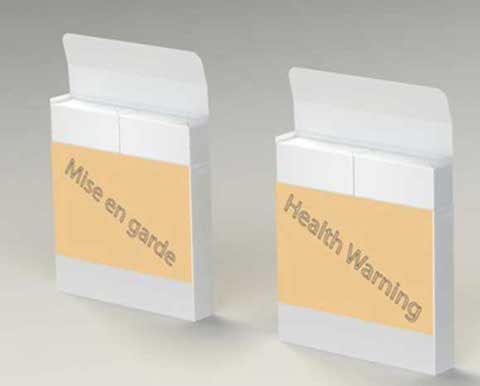
Text Description
Open cigarette pack, no cigarettes
One in English one in French.
Mise en garde
Health Warning.
Q8. What type of cigarette package do you use most often, a flip top or slide and shell package? Base: All respondents
The tables below present a demographic comparison of flip-top and slide and shell users. A higher proportion of flip-top users are English-speaking, aged 18-24 and live in the Prairies or British Columbia (BC), while a higher proportion of slide and shell users are French-speaking and live in Quebec or Ontario.
| English | French | Male | Female | 16-17 | 18-24 | 25-44 | 45-64 | 65+ | |
|---|---|---|---|---|---|---|---|---|---|
| Base size | 1,993 | 1,007 | 1,727 | 1,264 | 187 | 332 | 1,060 | 1,124 | 297 |
| Flip-top | 74% | 62% | 71% | 72% | 71% | 78% | 73% | 68% | 70% |
| Slide & shell | 26% | 38% | 29% | 28% | 29% | 22% | 27% | 32% | 30% |
Q8. What type of cigarette package do you use most often, a flip top or slide and shell package? Base: All respondents
| BC | Prairies | Ontario | Quebec | Atlantic | |
|---|---|---|---|---|---|
| Base size | 306 | 576 | 617 | 1,200 | 301 |
| Flip-top | 88% | 75% | 68% | 62% | 70% |
| Slide & shell | 12% | 25% | 32% | 38% | 30% |
Q8. What type of cigarette package do you use most often, a flip top or slide and shell package? Base: All respondents. Note: Prairies includes Alberta, Saskatchewan and Manitoba and Atlantic includes New Brunswick, Nova Scotia, Prince Edward Island and Newfoundland & Labrador.
| High School or Less | College /Some University | University Degree+ | Under $40k | $40k - $80k | $80k - $100k | $100k+ | |
|---|---|---|---|---|---|---|---|
| Base size | 1,032 | 1,160 | 778 | 799 | 918 | 352 | 503 |
| Flip-top | 70% | 70% | 74% | 70% | 72% | 72% | 70% |
| Slide & shell | 30% | 30% | 26% | 30% | 28% | 28% | 30% |
Q8. What type of cigarette package do you use most often, a flip top or slide and shell package? Base: All respondents
Desire to quit
Almost all respondents think that they should quit smoking, but only one in five say they intend to within the next three months.
When asked about their quitting intention, a small proportion (7%) say they do not want to stop smoking. Most say they should stop smoking, although nearly six in ten say they either don't really want to (28%) or don't have a timeline in mind (28%). The remaining one third either plan to quit sometime in the next six months (17%) or intend to in the next three months (20%).
Quit intention is linked to the frequency that people smoke. Intention to quit in the next three months is higher among those who smoke occasionally or fewer than five cigarettes a day (30%), while the proportion who doesn't want to quit is higher among heavy smokers (those smoking 15+ cigarettes a day).
| Quitting intention | Overall | Occasional smoker / less than 5 daily | 5-9 daily cigarettes | 10-14 daily cigarettes | 15-24 daily cigarettes | 25+ daily cigarettes |
|---|---|---|---|---|---|---|
| Base size | 2,997 | 1,136 | 511 | 642 | 501 | 207 |
| I really want to stop smoking and intend to in the next 3 months | 20% | 30% | 14% | 14% | 12% | 15% |
| I want to stop smoking and plan to do so in the next 6 months | 17% | 17% | 18% | 19% | 13% | 11% |
| I want to stop smoking but haven't thought about when | 28% | 26% | 32% | 31% | 29% | 24% |
| I think I should stop smoking but don't really want to | 28% | 22% | 31% | 30% | 33% | 35% |
| I don't want to stop smoking | 7% | 5% | 5% | 6% | 12% | 16% |
Q38. Which of the following best describes you? Base: All respondents
Demographic differences:
- Intention to quit in the next three months is higher among females (23%).
- This intention is lower among those aged 16-17 (14%) and 25-44 (16%).
Past quit attempts
Around three quarters of respondents say they have made a serious quit attempt and those who have made such an attempt are more likely to intend to quit in the near future.
The majority (73%) of respondents have made a serious attempt to quit smoking that lasted for more than 24 hours. Previous quit attempts are more commonly reported in Quebec (80%) and by those who speak French (82%). Age is also a factor: previous quit attempts are highest among those aged 65 and older (85%) and lower among those aged 16-17 (63%) or 18-24 (69%). Those with a university education are less likely to have made a past attempt (68%) than those with lower levels of education. There are no significant differences in past quit attempts by the number of cigarettes smoked daily or by gender.
| Ever made a serious attempt to quit smoking which lasted more than 24 hours? | Overall |
|---|---|
| Base size | 3,000 |
| Yes | 73% |
| No | 27% |
Q39. Since you started smoking cigarettes, have you ever made a serious attempt to quit smoking which lasted more than 24 hours? Base: All respondents
Future intentions to quit are tied to previous quit attempts. Four in ten (41%) of those who have tried to quit in the past plan to do so again in the next six months, compared to one in four (26%) who have never made a serious quit attempt. Compared to respondents who reported previous quit attempts, higher proportions of those who have never made a serious attempt say they don't want to stop smoking (14%) or that they would like to quit smoking but have no plans as to when (34%).
| Quit intention | Overall | Have made a serious quit attempt | Have not made a serious quit attempt |
|---|---|---|---|
| Base size | 2,997 | 2,216 | 781 |
| I really want to stop smoking and intend to in the next 3 months | 20% | 23% | 13% |
| I want to stop smoking and plan to do so in the next 6 months | 17% | 18% | 13% |
| I want to stop smoking but haven't thought about when | 28% | 26% | 34% |
| I think I should stop smoking but don't really want to | 28% | 28% | 27% |
| I don't want to stop smoking | 7% | 5% | 14% |
Q38. Which of the following best describes you? Base: All respondents
B. HIM noticeability
HIM placement varies depending on the type of cigarette package. On a slide and shell package, the HIM is comprised of two sections: a short. message (the teaser) displayed on the top flap of the slide to draw attention to the inside of the package and the health information (text and images) located on the back of the slide. In flip-top packages, the HIM appears as an insert in the interior of the package. Respondents were asked how often they noticed these messages in the past month and, if they had noticed them (at least rarely), how often they read them.
Top-flap message (teaser)
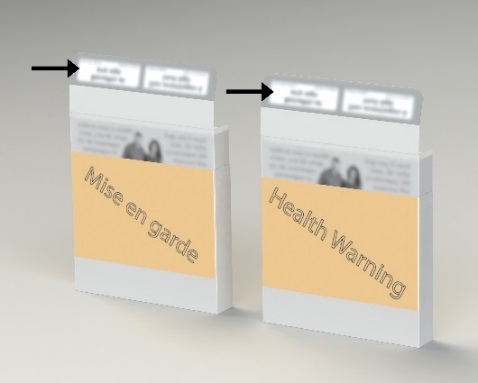
Text Description
Cigarette pack with blurry Health information warning pulled 1/3 out with tabs showing. One English and one French.
Arrows pointing to tabs.
Mise en garde
Health warning.
Seven in ten slide and shell users notice the message on the top flap at least sometimes, and six in ten of these people read the message at least sometimes.
Seven in ten (70%) respondents who use S/S packages notice the message on the top-flap always, often or sometimes within the past month, compared to three in ten (30%) who do so rarely or never.
Among those who notice the message on the top-flap at least rarely, six in ten (62%) say they read it at least sometimes in the last month, compared to more than three in ten (37%) who do so rarely or never.
| Figure 11: Noticed and read the top-flap message on S/S packages | |||||
|---|---|---|---|---|---|
| Among all slide and shell users (n=929) | Always | Often | Sometimes | Rarely | Never |
| Noticed the message on the top flap of the slide of cigarette packages | 20% | 25% | 25% | 19% | 11% |
| Among all slide and shell users who notice the top-flap HIM (n=814) | Always | Often | Sometimes | Rarely | Never |
| Read the message on the top flap of the slide of cigarette packages | 12% | 21% | 29% | 25% | 12% |
Q9. In the past month, how often have you noticed the message on the top flap of the slide of cigarette packages? Base: All slide and shell package users. Q10. In the past month, how often have you read the message on the top flap of the slide of cigarette packages? Base: All slide and shell package users who notice the top-flap HIM at least rarely.
Demographic differences:
- Likelihood of noticing the message on the top-flap (always, often or sometimes) is higher among those who live in BC (92%), 16-17 year-olds (92%), those with children in their household (79% vs. 64% of those without) and English speakers (73% vs. 60% of French speakers). It is significantly lower among those who smoke 25+ cigarettes a day (58%).
- Likelihood (among those who notice it) of reading the message on the top-flap (always, often or sometimes) ranges from virtually all 16-17 year-olds (96%) to just over half (51%) of those aged 65 and older and is higher among those with children in the household (70% vs. 57% of those without) and English speakers (66% vs. 53% of French speakers).
HIM on back of slide/insert
Flip-top users are the most likely to notice HIM, but less likely to read them. In contrast, slide and shell users report lower noticeability but higher readership of the HIM located on the back of the slide.
Figure 12: Description of HIM on F/T and S/S packages
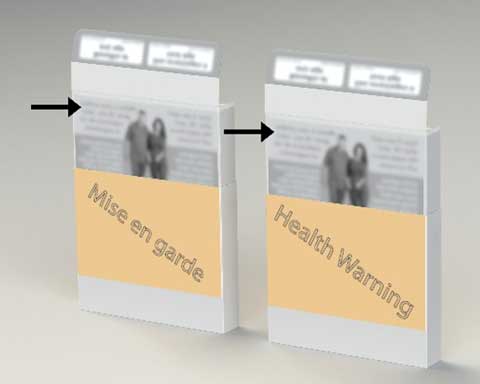
Text Description
Slide and shell cigarette pack with blurry Health information warning pulled 1/2 out with tabs showing. One English and one French.
Arrows pointing to Health information warning.
Mise en garde
Health warning.
Text Description
Flip top open cigarette pack showing health information message pulled 2/3 out. Arrow pointing to title of message. One English and one French.
Mise en garde
Health warning.
S/S package users were also asked about the HIM that appears on the back of the slide. Six in ten (63%) notice the HIM at least sometimes within the past month. Among those who notice the back of the slide HIM (at least rarely), six in ten (59%) read it at least sometimes in the past month.
Among F/T package users, eight in ten (80%) notice the HIM insert at least sometimes in the past month (including 44% who say they always notice it). However, among F/T package users who notice the HIM insert in the past month (at least rarely), four in ten (44%) read it at least sometimes.
Figure 13: Noticed and read the back of slide/insert HIM
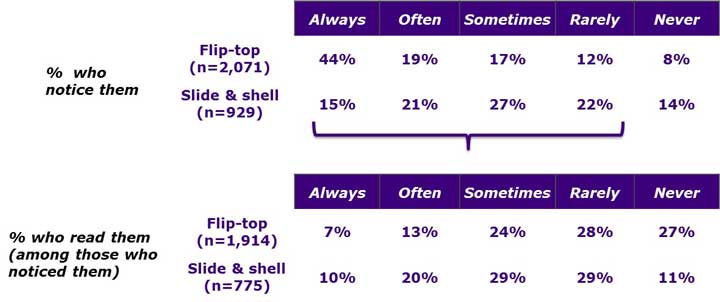
Text Description
| Package type | Always | Often | Sometimes | Rarely | Never |
|---|---|---|---|---|---|
| Flip-top (n= 2071) | 44% | 19% | 17% | 12% | 8% |
| Slide & shell (n=929) | 15% | 21% | 27% | 22% | 14% |
| Package type | Always | Often | Sometimes | Rarely | Never |
|---|---|---|---|---|---|
| Flip-top (n= 1914) | 7% | 13% | 24% | 28% | 27% |
| Slide & shell (n=775) | 10% | 20% | 29% | 29% | 11% |
Q11/Q12. In the past month, how often, have you noticed / read the messages on the back of the slide/inserts in cigarette packages? Base: All respondents
Profile of HIM readers/non-readers
HIM readers are more likely to be English-speaking, younger, smoke fewer cigarettes a day and use slide and shell packages.
The tables below compare different demographic groups in terms of who reads HIM on the back of the slide or on the insert (at least sometimes) and those who do not (rarely/never or do not notice them). Overall, 44% of all respondents are classified as HIM-readers and 56% are not. People who are more likely to be HIM readers include: people 16-17 years-old (82%), those who smoke 5-9 (51%) or less than five cigarettes a day (53%), S/S package users (51%), those who plan to quit in the next six months (51%) and English-speakers (45%).
| HIM-reader status | English | French | Male | Female | 16-17 | 18-24 | 25-44 | 45-64 | 65+ |
|---|---|---|---|---|---|---|---|---|---|
| Base size | 1,993 | 1,007 | 1,727 | 1,264 | 187 | 332 | 1,060 | 1,124 | 297 |
| HIM-reader | 45% | 39% | 45% | 44% | 82% | 50% | 52% | 37% | 26% |
| Non-HIM-reader | 55% | 61% | 55% | 56% | 18% | 50% | 48% | 63% | 74% |
Q12. In the past month, how often, have you read the messages on the back of the slide/inserts in cigarette packages? Base: All respondents.
| HIM-reader status | BC | Prairies | Ontario | Quebec | Atlantic | F/T user | S/S user |
|---|---|---|---|---|---|---|---|
| Base size | 306 | 576 | 617 | 1,200 | 301 | 2,071 | 929 |
| HIM-reader | 38% | 45% | 48% | 42% | 42% | 41% | 51% |
| Non-HIM-reader | 62% | 55% | 52% | 58% | 58% | 59% | 49% |
Q12. In the past month, how often, have you read the messages on the back of the slide/inserts in cigarette packages? Base: All respondents. Note: Prairies includes Alberta, Saskatchewan and Manitoba and Atlantic includes New Brunswick, Nova Scotia, Prince Edward Island and Newfoundland & Labrador.
| HIM-reader status | High School or Less | College /Some University | University Degree+ | Under $40k | $40k - $80k | $80k - $100k | $100k+ |
|---|---|---|---|---|---|---|---|
| Base size | 1,032 | 1,160 | 778 | 799 | 918 | 352 | 503 |
| HIM-reader | 45% | 41% | 47% | 37% | 48% | 45% | 44% |
| Non-HIM-reader | 55% | 59% | 53% | 63% | 52% | 55% | 56% |
Q12. In the past month, how often, have you read the messages on the back of the slide/inserts in cigarette packages? Base: All respondents.
| HIM-reader status | Less than 5 / day | 5-9 daily cigarettes | 10-14 daily cigarettes | 15-24 daily cigarettes | 25+ daily cigarettes |
|---|---|---|---|---|---|
| Base size | 161 | 511 | 642 | 501 | 207 |
| HIM-reader | 53% | 51% | 42% | 38% | 33% |
| Non-HIM-reader | 47% | 49% | 58% | 62% | 67% |
Q12. In the past month, how often, have you read the messages on the back of the slide/inserts in cigarette packages? Base: All respondents.
| HIM-reader status | Don't want to stop |
Should quit but don't want to |
Want to quit- haven't thought about when |
Plan to in the next 6 months |
Intend to in the next 3 months |
|---|---|---|---|---|---|
| Base size | n=230 | n=821 | n=875 | n=503 | n=568 |
| HIM-reader | 31% | 39% | 48% | 51% | 45% |
| Non-HIM-reader | 69% | 61% | 52% | 49% | 55% |
Q12. In the past month, how often, have you read the messages on the back of the slide/inserts in cigarette packages? Base: All respondents.
Proportion of HIM read
The majority of those who read HIM read at least half of the one they read most recently.
Eight in ten respondents who report reading the HIM read all (39%) or half or more (41%) of the last one they recall reading. One in five (20%) read less than half of the HIM. Slide and shell package users are more likely to read all of it than flip top users.
| Proportion of HIM read | Overall | English | French | 16-17 | 18-24 | 25-44 | 45-64 | 65+ |
|---|---|---|---|---|---|---|---|---|
| Base size | 2,077 | 1453 | 624 | 173 | 253 | 782 | 711 | 158 |
| All of it | 39% | 37% | 48% | 49% | 41% | 37% | 41% | 32% |
| Half or more, but not all of it | 41% | 43% | 31% | 47% | 46% | 44% | 35% | 42% |
| Less than half of it | 20% | 20% | 21% | 4% | 13% | 19% | 24% | 26% |
Q16. Thinking about the last time you read a message on the slide/an insert in a cigarette package, how much of the message did you read? Base: Those who always/often/sometimes/rarely read the messages on back of slides/inserts
| Proportion of HIM read | Overall | F/T | S/S |
|---|---|---|---|
| Base size | 2,077 | 1,384 | 693 |
| All of it | 39% | 36% | 44% |
| Half or more, but not all of it | 41% | 40% | 42% |
| Less than half of it | 20% | 23% | 14% |
Q16. Thinking about the last time you read a message on the slide/an insert in a cigarette package, how much of the message did you read? Base: Those who always/often/sometimes/rarely read the messages on back of slides/inserts
Demographic differences:
The proportion of people who read all of the HIM that they most recently recall reading is higher among:
- 16-17 year-olds (49%)
- French speakers (48%)
- People from Quebec and Atlantic Canada (47% each)
- Those with a high school education or less (45%)
- Those planning to quit smoking in the next three to six months (44% each)
- People with children living in their household (43%).
- Daily smokers (42%)
Reasons for reading HIM
Many say they read HIM simply because they are hard to ignore. However, respondents with intentions to quit are more likely than others to say HIM are relevant or provide helpful information.
The most common reason given for reading the HIM is that they are very prominent and hard to miss or ignore (47% of those of who read HIM). Those who are more serious about quitting are more likely than others to say the information is helpful to them; those who intend to quit in the next three months are also more likely than others to say the information is relevant to them.
| Reasons for reading HIM | Overall | Don't want to stop |
Should quit but don't want to |
Want to quit- haven't thought about when |
Plan to in the next 6 months |
Intend to in the next 3 months |
|---|---|---|---|---|---|---|
| Base size | 1,350 | 77 | 330 | 419 | 259 | 264 |
| They are very prominent/ hard to miss/ignore | 47% | 38% | 45% | 47% | 51% | 47% |
| Information is helpful/helps me try to quit or cut back | 34% | 12% | 21% | 34% | 39% | 49% |
| I trust this source of health information | 32% | 37% | 26% | 29% | 36% | 37% |
| Information is relevant to me | 29% | 20% | 23% | 28% | 30% | 38% |
| The information is interesting | 27% | 24% | 28% | 30% | 27% | 23% |
| To learn something new | 27% | 19% | 29% | 27% | 25% | 26% |
Q14. Why do you read the messages on the slides of/inserts in cigarette packages? Base: Those who always/often/ sometimes read the messages on back of slides/inserts Note: only responses given by 2% or more are shown
Demographic differences:
- Higher likelihood to say that their reason for reading HIM is that they are very prominent/hard to miss is more common among females (51% vs. 43% among males) and daily smokers (49% vs. 42% among occasional smokers).
- The proportion who say that the 'information is helpful/helps me try to quit or cut back' is higher among people in BC (46%), those who have attempted to quit in the past (36%) and English speakers (35%).
- Mentions of 'I trust this information source' are higher among those who have a household income between $80-$100k (41%) and those with a university education (39%).
- The proportion who say they read HIM because the information is relevant to them is higher among those aged 16-17 (43%), those with children in the household (33%) and English speakers (30%).
- Likelihood to say both 'the information is interesting' and 'to learn something new' is higher among those aged 16-17 (47% and 34%, respectively), 18-24 (38% and 33%, respectively) and 25-44 (30% and 29%, respectively) compared to older respondents. Those with children at home are also more likely to say they read HIM 'to learn something new' (31%).
Reasons for not reading HIM/reading them more often
Non-readers say they don't read HIM because they are already familiar with them, while flip-top users also say they remove the insert altogether without reading it.
Among those who do rarely or never read the HIM, the main reasons given are because there is nothing new (50%) and the messages are too repetitive (23%). Many F/T package users also say they remove the HIM insert as soon as they open the pack (58%). A third of respondents (33%) say that they are just not interested in getting health messages with their cigarette packages.
Other reasons for not reading HIM (for both S/S and F/T) include almost a quarter (23%) who say the messages are not interesting or are too repetitive, that the messages are not visually appealing (14%) or are too long (7%).
| Reasons for NOT reading HIM | Overall | Flip-top | Slide and Shell |
|---|---|---|---|
| Base size | 1,339 | 1,032 | 307 |
| I have read/seen them all before/there is nothing new | 50% | 47% | 61% |
| I remove the insert as soon as I open the pack (F/T only) | n/a | 58% | n/a |
| Not interested in getting health messages with my cigarette packages | 33% | 33% | 33% |
| Messages are not interesting/too repetitive | 23% | 22% | 24% |
| Not visually appealing | 14% | 13% | 17% |
| Messages are too long | 7% | 8% | 5% |
| Information is not relevant to me | 5% | 5% | 7% |
| Difficult to remove the insert to read it (F/T only) | n/a | 5% | n/a |
| Do not trust the information on a cigarette package | 3% | 3% | 4% |
| Other | 2% | 2% | 2% |
Q13. Why don't you read the messages on the slides of/inserts in cigarette packages? Base: Those who rarely/never read the messages on back of slides/inserts
Demographic differences:
- The likelihood to say they don't read the HIM because they have seen/read all of them before is higher among those aged 65 or older (63%), those who use slide and shell packages (61% vs. 47% of F/T), English speakers (52% vs 42% of French speakers) and those who have tried to quit in the past (52% vs 43% of those who have not).
- The proportion of flip top users who are more likely to say they remove the insert as soon as they open the pack is higher in Atlantic Canada (69%), among people with household incomes below $40k (66%), those with a high school education or less (65%), daily smokers (63%), those who have attempted to quit in the past (62%) and do not have children in their household (61%).
- The proportion who don't read HIM because they are not interested in health messages is higher among those who don't want to quit (52%), people aged 45-64 (36%) or 65 years or older (39%), English speakers (36%) and daily smokers (36%).
- Although it is not mentioned as often as a reason not to read the HIM, those who are more likely to mention that the HIM are not visually appealing are 18-24 year-olds (22%), French speakers (20%) and occasional smokers (18%).
Change in frequency of reading HIM
The majority of respondents perceive no change in how often they read HIM compared to a year ago.
Compared to a year ago, six in ten (63%) respondents who say they read HIM at least rarely do so about the same amount, with the remainder almost equally divided between reading them more often (20%) or less often (17%) than before. It is worth noting that this question measures change in reading frequency among those who read HIM and not among those who say they never do, which may result in underestimating the proportion who are "reading less often" than before.
Age is a key factor: the proportion who read HIM more often than before is highest among 16-17 year-olds (42%) and lowest among those aged 65 and older (6%), who in turn are most likely of all age groups to say they are reading HIM less often than before (29%). The results among 16-17 year-olds may reflect that they were not smoking a year ago and so are reading HIM more often now that they are smokers.
| Change in reading HIM | Overall | 16-17 | 18-24 | 25-44 | 45-64 | 65+ |
|---|---|---|---|---|---|---|
| Base size | 2,078 | 173 | 253 | 782 | 711 | 159 |
| More often than before | 20% | 42% | 25% | 23% | 15% | 6% |
| About the same amount | 63% | 53% | 59% | 63% | 65% | 66% |
| Less often than before | 17% | 5% | 17% | 13% | 20% | 29% |
Q15. Compared to a year ago, do you read the health messages on cigarette package slides/inserts? Base: Those who always/often/ sometimes/rarely read the messages on back of slides/inserts
Demographic differences:
- Respondents with children in their household are more likely than other groups to say they are reading HIM more often than before (29%).
- The proportion who say they are reading HIM less often than before is higher in Quebec (24%) and among French speakers (26%).
Recall of HIM health topics
Most respondents recall at least one of the current HIM health topic, although some also mistakenly recall health topics not featured in current HIM.
From a list of 13, those who read HIM at least rarely were asked to identify up to three health topics they remember seeing in cigarette packages and a list was provided that included both current and incorrect HIM topics. Overall, respondents are more likely to recall current topics (89%) than the other/incorrect topics (50%). However, certain incorrect topics are recalled just as often as current ones. For example, about one in four respondents (24%) recalled a HIM topic around "third-hand smoke health effects", which is not featured on HIM or any package labels. The current HIM topic "Cravings after quitting smoking" was recalled by fewer than one in ten (8%) respondents.
Recall of HIM health topics is similar for F/T and S/S package users. Those who read HIM always/often/sometimes are more likely than those who read them rarely to recall both current HIM and incorrect ones.
| Recall of current and incorrect HIM health topics | Overall | Flip-top | Slide and Shell | HIM reader | Rarely read HIM |
|---|---|---|---|---|---|
| Base size | 2,078 | 1,385 | 693 | 1,350 | 728 |
| Current HIM topics (net – mentioned any) | 89% | 89% | 88% | 91% | 86% |
| Respiratory problems/coughing | 43% | 44% | 42% | 40% | 48% |
| Reasons to quit smoking | 32% | 34% | 27% | 33% | 30% |
| Increasing life expectancy by quitting smoking | 30% | 29% | 31% | 30% | 29% |
| Quitting smoking before pregnancy | 29% | 28% | 31% | 27% | 32% |
| How to access the Quitline for support | 17% | 18% | 14% | 17% | 16% |
| Never quit trying to quit | 15% | 15% | 14% | 14% | 16% |
| A personal quit story | 12% | 12% | 11% | 13% | 9% |
| Cravings after quitting smoking | 8% | 8% | 8% | 10% | 5% |
| Other/incorrect HIM topics (net – mentioned any) | 50% | 49% | 51% | 53% | 43% |
| Third-hand smoke health effects | 24% | 24% | 23% | 24% | 23% |
| Looking better after you have quit smoking | 12% | 12% | 12% | 14% | 10% |
| How much money you will save from quitting smoking | 12% | 12% | 12% | 13% | 9% |
| Having better sex as a result of quitting smoking | 8% | 7% | 11% | 10% | 6% |
| Smoking and your pet | 5% | 5% | 5% | 6% | 3% |
| Not sure/can't recall | 8% | 7% | 8% | 5% | 12% |
Q17. Without looking at a cigarette package, please select up to THREE health topics you remember seeing on a cigarette package/inserts in cigarette packages Base: Those who always/often/sometimes/rarely read the messages on back of slides/inserts
Demographic differences:
- Those who are more likely to recall a current HIM topic include 16-17 year-olds (96%) and 18-24 year-olds (94%).
- The people who are more likely to recall an incorrect HIM are 16-17 year-olds (71%), those with a university degree (54%), those with children in the household (54%), males (52%), daily smokers (51%) and English speakers (51%).
C. Cognitive reaction to Health Information Messages
HIM Recall
To test how well existing HIM are recalled, each respondent was shown four images – three were randomly selected from eight HIM that currently exist in cigarette packages, plus one randomly selected from two new HIM not currently being used in cigarette packages. Images were presented in the package version (F/T or S/S) that the respondent most often uses. Respondents were asked to select which of the four HIM, if any, they had seen before. The results reported below are based on the number of respondents who were exposed to each image. Given differences in the HIM content and images between F/T and S/S packages (e.g. the S/S text being bilingual and the size and placement of images) they are analysed separately in this section of the report.
Around six in ten respondents (62% F/T and 59% S/S package users) recall seeing a current HIM, while one in five (20% for both F/T and S/S package users) recall seeing a HIM which they could not have seen.
Recall of current HIM is higher than that of the new, unreleased HIM when taken as a whole. Recall of each of the current HIM ranges from 21% to 47%. Most of the current HIM are recalled more often than the new ones that are not currently circulating in packages, but there is some overlap, meaning that some respondents recalled a HIM they could not have seen more often than one they could have.
It is a well-known phenomenon that a small proportion of survey respondents will 'recall' a stimuli even when it is impossible for them to have ever seen it. In this case, the new HIM serve as a 'control' for determining the incorrect level of recall. Any existing HIM recalled above this level can be deemed to be accurately (rather than mistakenly) recalled.
| % among those exposed to each HIM who recall seeing it | F/T package user | S/S package user |
|---|---|---|
| Base size | 2,071 | 929 |
| Recalled at least one current HIM | 62% | 59% |
| Recalled a new HIM | 20% | 20% |
| I have not seen any of these before | 33% | 35% |
| HIM and tagline | Flip-top package users | Slide and shell package users | ||
|---|---|---|---|---|
| Total # cases exposed to this HIM | Proportion exposed who recall seeing this HIM | Total # cases exposed to this HIM | Proportion exposed who recall seeing this HIM | |
| CurrentHIM_2 (Morning cough) |
n=771 | 47% | n=346 | 41% |
| CurrentHIM_6 (Thinking of having a baby?) |
n=777 | 46% | n=350 | 46% |
| CurrentHIM_1 (It's never too late…) |
n=772 | 33% | n=346 | 31% |
| CurrentHIM_8_Quitline (How can the quitline help me?) |
n=782 | 32% | n=350 | 22% |
| CurrentHIM_4_Quitline (I had enough of feeling guilty…) |
n=778 | 30% | n=348 | 21% |
| CurrentHIM_5 (They only last a few minutes) |
n=776 | 29% | n=350 | 24% |
| CurrentHIM_3 (Never quit trying to quit) |
n=783 | 28% | n=346 | 26% |
| CurrentHIM_7 (Quitting… What's in it for me?) |
n=774 | 28% | n=351 | 22% |
| NEWHIM_1_Quitline (Tips for quitting) |
n=1,035 | 27% | n=463 | 25% |
| NEWHIM_2_Quitline (Control cravings) |
n=1,036 | 14% | n=466 | 15% |
| I have not seen any of these before | - | 33% | - | 35% |
Q18. Which of these four Health Messages have you ever seen in a cigarette package? Base: Those who were exposed to each HIM
There are few significant differences in recall between English and French-speaking respondents. Among the current HIM, French respondents are more likely to recall:
- CurrentHIM_1_Fliptop: It's never too late… (38% vs. 32% among English speakers) and,
- CurrentHIM_7_Fliptop: Quitting… What's in it for me? (32% vs. 27% of English speakers).
English speakers are more likely to recall:
- CurrentHIM_3_Fliptop: Never quit trying to quit (30% vs 20% of French speakers)
- CurrentHIM_4_Quitline_SlideShell: I had enough of feeling guilty… (23% vs. 15 % of French speakers)
- CurrentHIM_3_SlideShell: Never quit trying to quit (28% vs. 22% among French speakers).
English S/S package users are significantly more likely to say they recall both of the uncirculated S/S HIM:
- NEWHIM_1_Quitline_SlideShell: Tips for quitting (28% vs. 18% of French speakers) and,
- NEWHIM_2_Quitline_SlideShell: Control cravings (16% vs. 10% of French speakers).
Roughly one third of all respondents (33% F/T and 35% S/S package users) did not recall a HIM whether existing or new. This is substantially higher than the proportion who could not recall any health topics (8%). This is likely because the HIM are a more specific and identifiable element than a description of a health topic. For example, it is expected that people are more likely to feel they recall something about 'respiratory problems/coughing' than the more specific Morning cough HIM with an image of lungs.
Evaluation of individual HIM
Once respondents had been shown four HIM in order to measure recall, they were asked a set of follow-up evaluation questions about two current HIM that they recalled (if they recalled three current HIM, two of them were chosen randomly). If they recalled only one or no current HIM, a random current HIM was selected to be evaluated. As a result, the number of respondents who evaluated each HIM varies with the ones with higher levels of recall being evaluated more often.
Overall, all of the HIM are considered interesting, credible, and in most cases, about the right length (for all but one HIM, a majority said the message was the right length). Although there appears to be some connection between interest and recall, the connection is not direct; HIM with high recall are not necessarily those with high interest and vice-versa. There is also no clear pattern in terms of the elements which are noticed first and recall. Most HIM do not have one element that is much more noticeable than the others and among the cases where there is one, these HIM are do not necessarily have better or worse recall.
F/T and S/S versions: Although the rank order of HIM in terms of being well or poorly recalled is similar regardless of version (i.e. whether the F/T or S/S), the absolute level of recall is the same or higher for the F/T version of every single HIM tested compared to the S/S version of the same HIM. This difference may be due to the difference in the proportion of people who notice HIM between F/T and S/S package users. F/T package users report always or often noticing the HIM 63% of the time whereas S/S package users always or often notice the HIM only 36% of the time. F/T package users are more likely to have seen the visual due to their greater likelihood of noticing them, and, as such, to recall them when presented with the actual image they would have seen.
Throughout the analysis of the individual HIM below, the S/S version of each HIM tend to receive higher scores than the F/T version in terms of being interesting. Although the proportion of people who feel the messages tested are too long is low, in almost every case, the proportion of people saying that the HIM is too long is higher for the S/S version than the F/T version. This may be due to the fact there is more visible text on the S/S version of the HIM since both official languages are presented on a single design as opposed to the insert which only contains one language on each side.
There is no difference in terms of the level of credibility/believability that is reported with respondents providing almost identical scores on this metric for each HIM regardless of whether they were being asked about the S/S or F/T version. This suggests that the information presented is not being perceived differently based on the version that people are seeing it in.
HIM-readers vs Non-HIM readers: The people who say they read HIM always/often/sometimes provide consistently different responses from non-HIM readers when asked to evaluate each HIM individually. In virtually every case they are significantly more likely than non-readers to say the overall subject of the message is what first caught their eye, that the HIM is interesting, that it is the right length and that they find the HIM credible/believable. This trend is so persistent that it is not specifically noted within the analysis of the individual HIM below.
Demographics: There are few universal differences between demographic groups when evaluating the HIM in this study. The area with the least consistent patterns was which elements were noticed first. The only slight tendency here was males being a little more likely to choose the overall subject matter than females. In terms of interest and credibility, people who have tried to quit in the past, respondents under the age of 25 and, especially, those who want to quit and plan to do so in the next six month or really want to quit and intend to in the next three months are more likely to give higher scores. On the flip side, those 65 years of age or older and those who do not want to quit are routinely more likely see the HIM as less interesting, less credible, and too long. French speakers are also generally more likely to feel that the HIM are too long.
Each of the HIM are evaluated and analysed individually in the section below, first looking at the F/T and then the S/S version for each pair. The responses for each question are provided along with general comments and are followed by specific demographic differences that are observed for each.
A few things to note about the analysis in this section:
- Subgroup differences (variables included in the analysis are: gender, age, language, education, income, smoking frequency, past quit attempts, future quit intentions and whether there are children in the household) are listed if they are statistically significant at the 95% confidence level.
- Only subgroups with n=30 or more respondents are considered in the comparisons.
- Differences by language are included wherever they are significant.
- Demographic differences for interest and credible/believable are based on differences in the combined total of the top two choice options (very interesting combined with somewhat interesting or very combined with somewhat credible/believable).
HIM Evaluation: CurrentHIM_1_FLIPTOP

Text Description
An elderly couple walking hand in hand.
The text reads:
It's never too late…
Quitting smoking increases life expectancy and improves quality of life.
People who quit smoking increase their chances of living longer. They improve their general health, leading to a better quality of life.
Its' never too late to quit. No matter how old you are, you'll start to feel major and immediate health benefits and have more energy to help you live life to the fullest.
Talk to a health care provider.
Health Canada
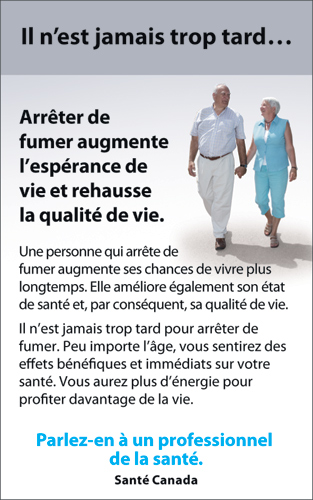
Description textuelle
Un couple de personnes âgées marchant main dans la main.
Il n'est jamais trop tard…
Le texte est le suivant :
Arrêter de fumer augmente l'espérance de vie et rehausse la qualité de vie.
Une personne qui arrête de fumer augmente ses chances de vivre plus longtemps. Elle améliore également son état de santé et, par conséquent, sa qualité de vie.
Il n'est jamais trop tard pour arrêter de fumer. Peu importe l'âge, vous sentirez des effets bénéfiques et immédiats sure votre santé. Vous aurez plus d'énergie pour profiter davantage de la vie.
Parlez-en à un professionnel de la santé.
Santé Canada
This HIM is recalled by a third of those respondents exposed to it – the image is the element that first catches people's eye, but the headline is chosen by more than a quarter of respondents.
% of respondents exposed to this HIM who recall it: 33%
A third of flip-top users shown this HIM recall seeing it. Although the image/picture is chosen as the element which first catches people's eye (41%), the headline is chosen by a greater proportion of people for this HIM than for any other (27%). Around seven in ten found the topic of the message interesting (69%) and nine in ten (90%) found it credible/believable.
| Figure 26: Responses for CurrentHIM_1_FlipTop (n=520) | |
|---|---|
| Q19. What first catches your eye? | Overall |
| The image/picture | 41% |
| The headline at the top of the message | 27% |
| The overall subject of the message | 16% |
| The colour | 10% |
| The text in the body of the message | 3% |
| Other | 2% |
| Q20. How interesting is the topic of the message? | Overall |
| Very/somewhat interesting | 69% |
| Very interesting | 24% |
| Somewhat interesting | 46% |
| Not very interesting | 19% |
| Not at all interesting | 11% |
| Q21. Do you feel the message is... | Overall |
| Too long | 35% |
| About the right length | 65% |
| Too short | 0% |
| Q22. How credible or believable is this message? | Overall |
| % Very/somewhat credible | 90% |
| Very | 42% |
| Somewhat | 47% |
| Not very | 7% |
| Not at all | 3% |
Significant demographic subgroup differences in evaluations of this HIM:
- People who are relatively more likely to notice the headline include those 18-24 (44%), those with incomes under $40K (40%) and with a high school education (35%).
- Those who are more likely to find the topic more interesting are 16-17 year-olds (93%), those planning to quit in the next three or six months (respectively, 84% and 81%), French respondents (79%), those who smoke between 5 and 9 cigarettes a day (77%) and those who smoke occasionally or fewer than 5 cigarettes a day (74%).
- Those more inclined to find the message too long are university graduates (43%) and those who smoke occasionally or less than 5 cigarettes a day (42%).
- People who find the message more credible are more likely to be people who intend to quit smoking in the next six months (98%), are 16-24 years of age (97%), have an income between $80-100k (96%) and be occasional smokers (96%).
HIM Evaluation: CurrentHIM_1_SLIDESHELL

Text Description
An elderly couple walking hand in hand. Written in both official languages.
The text reads:
It's never too late…
See the back.
Health Canada
Quitting smoking increases life expectancy and improves quality of life.
People who quit smoking increase their chances of living longer. They improve their general health, leading to a better quality of life.
Its' never too late to quit. No matter how old you are, you'll start to feel major and immediate health benefits and have more energy to help you live life to the fullest.
Talk to a health care provider.
Health Canada
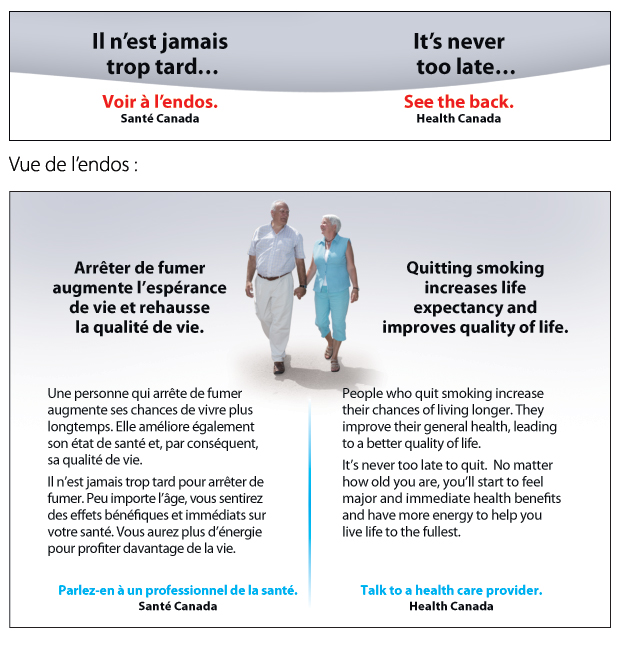
Description textuelle
Un couple de personnes âgées marchant main dans la main.
Écrit dans les deux langues officielles.
Le texte est le suivant :
Il n'est jamais trop tard…
Voir à l'endos.
Santé Canada
Arrêter de fumer augmente l'espérance de vie et rehausse la qualité de vie.
Une personne qui arrête de fumer augmente ses chances de vivre plus longtemps. Elle améliore également son état de santé et, par conséquent, sa qualité de vie.
Il n'est jamais trop tard pour arrêter de fumer. Peu importe l'âge, vous sentirez des effets bénéfiques et immédiats sure votre santé. Vous aurez plus d'énergie pour profiter davantage de la vie.
Parlez-en à un professionnel de la santé.
Santé Canada
As with the F/T version of this HIM, the image first caught people's eye but the headline was also chosen frequently (23%).
% of respondents exposed to this HIM who recall it: 31%
Just under a third of slide and shell users who were shown this HIM said that they recalled seeing it. As with the F/T version, the image/picture was chosen as the element which first catches people's eye (40%) but the headline was chosen far more often for this HIM than for other HIM. The S/S version of this HIM scores significantly higher (77%) than the F/T version in terms of how interesting it is seen to be.
| Figure 27: Responses for CurrentHIM_1_SlideShell (n=238) | |
|---|---|
| Q19. What first catches your eye? | Overall |
| The image/picture | 40% |
| The headline at the top of the message | 23% |
| The overall subject of the message | 20% |
| The colour | 11% |
| The text in the body of the message | 2% |
| Other | 4% |
| Q20. How interesting is the topic of the message? | Overall |
| Very/somewhat interesting | 77% |
| Very interesting | 31% |
| Somewhat interesting | 46% |
| Not very interesting | 15% |
| Not at all interesting | 8% |
| Q21. Do you feel the message is.... | Overall |
| Too long | 36% |
| About the right length | 62% |
| Too short | 2% |
| Q22. How credible or believable is this message? | Overall |
| % Very/somewhat credible | 91% |
| Very | 48% |
| Somewhat | 42% |
| Not very | 7% |
| Not at all | 3% |
Significant demographic subgroup differences in evaluations of this HIM:
- People who are relatively more likely to have noticed the colour includes those with an income of $100k+ (26%) and those with a university degree (24%). The people who are more likely to have noticed the overall subject of the message are those with a high school education or less (30%), those with incomes below $40k (27%) and those without children in the household (25%).
- Those who are more likely to find the topic interesting have a college education (87%) and have tried to quit in the past (82%).
- Those who find the message too long are more likely to smoke between 5 and 9 cigarettes a day (54%).
- People who found the message more credible are more likely to be those who intend to quit smoking in the next three months (100%) and people who have attempted to quit before (96%).
HIM Evaluation: CurrentHIM_2_FLIPTOP

Text Description
Set of light blue animated lungs with beige bronchioles.
The text reads:
Morning cough?
Coughing is your lungs warning you it's time to quit.
When you quit smoking:
- Within the first few months, you'll cough and wheeze less and you'll be short of breath less often.
- In the first 5 years, respiratory problems like bronchitis and pneumonia will decrease significantly.
You can quit and breathe easier!
Health Canada

Description textuelle
Ensemble de poumons animés bleu clair avec bronchioles beiges.
Le texte est le suivant :
Vous toussez le matin?
La toux est un signal de vos poumons qu'il est temps d'arrêter.
Quand vous arrêter de fumer :
- Dès les premiers mois, la toux et les râlements diminueront. Vous serez moins essoufflé.
- Au cours des 5 premières années, les problèmes respiratoires, comme la bronchite et la pneumonie, diminueront de façon marquée.
Vous pouvez arrêter et respirer mieux!
Santé Canada
This HIM was recalled by almost half of those exposed to it, making it one of the most memorable – it is also seen as one of the most credible.
% of respondents exposed to this HIM who recall it: 47%
Just under half (47%) of all flip-top users who were shown this HIM said that they recalled seeing it. Although the image catches people's eye the most often (32%), the colour (21%) and the overall subject of the message (20%) are also common responses. Seven in ten (72%) indicated the HIM was interesting and large majorities felt this HIM was the right length (80%) and credible (90%).
| Figure 28: Responses for CurrentHIM_2_FlipTop (n=616) | |
|---|---|
| Q19. What first catches your eye? | Overall |
| The image/picture | 32% |
| The headline at the top of the message | 17% |
| The overall subject of the message | 20% |
| The colour | 21% |
| The text in the body of the message | 6% |
| Other | 4% |
| Q20. How interesting is the topic of the message? | Overall |
| Very/somewhat interesting | 72% |
| Very interesting | 28% |
| Somewhat interesting | 44% |
| Not very interesting | 18% |
| Not at all interesting | 10% |
| Q21. Do you feel the message is.... | Overall |
| Too long | 18% |
| About the right length | 80% |
| Too short | 2% |
| Q22. How credible or believable is this message? | Overall |
| % Very/somewhat credible | 90% |
| Very | 51% |
| Somewhat | 39% |
| Not very | 6% |
| Not at all | 3% |
Significant demographic subgroup differences in evaluations of this HIM:
- Those who are more likely to say the colour caught their eye are those who smoke 25+ cigarettes a day (41%), 18-24 year-olds (32%) and females (27%). Males are relatively more likely to have noticed the overall subject of the message (24%).
- People who are more likely to find the topic more interesting are 16-17 year-olds (96%) and those planning to quit in the next three or six months (respectively, 80% and 83%).
- Those more inclined to find the message too long are people who do not want to quit smoking (36%) and smokers 65 years of age or older (29%).
- Those who are less likely to find the message credible/believable are those aged 65 or over (80%) and those who don't want to quit (74%).
HIM Evaluation: CurrentHIM_2_SLIDESHELL
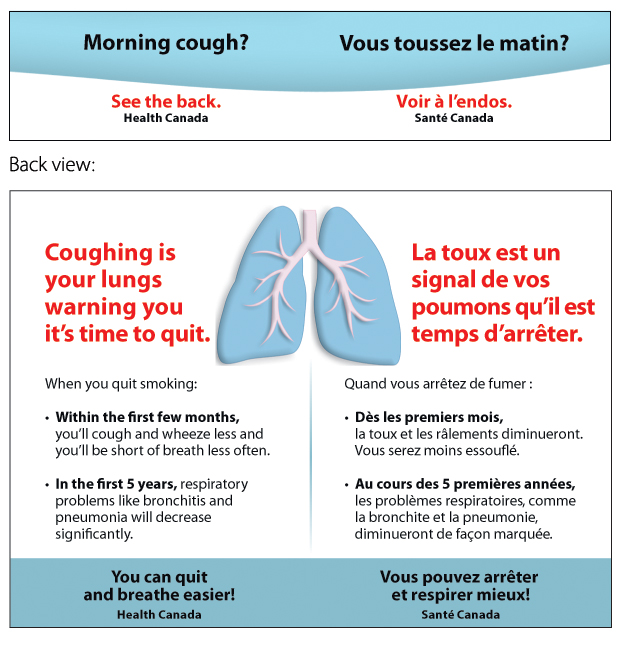
Text Description
Set of light blue animated lungs with beige bronchioles. Text written in both official languages.
The text reads:
Morning cough?
See the back.
Health Canada
Coughing is your lungs warning you it's time to quit.
When you quit smoking:
- Within the first few months, you'll cough and wheeze less and you'll be short of breath less often.
- In the first 5 years, respiratory problems like bronchitis and pneumonia will decrease significantly.
You can quit and breathe easier!
Health Canada
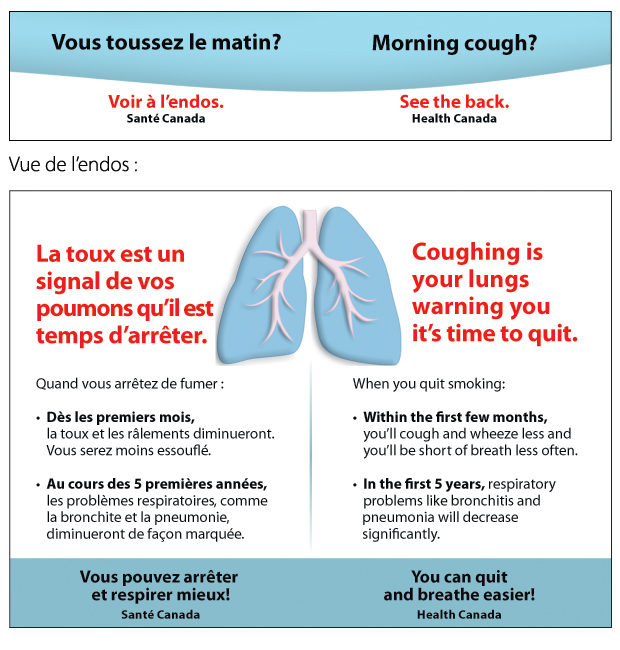
Description textuelle
Ensemble de poumons animés bleu clair avec bronchioles beiges.
Écrit dans les deux langues officielles.
Le texte est le suivant :
Vous toussez le matin?
Voir à l'endos.
Santé Canada
La toux est un signal de vos poumons qu'il est temps d'arrêter.
Quand vous arrêter de fumer :
- Dès les premiers mois, la toux et les râlements diminueront. Vous serez moins essoufflé.
- Au cours des 5 premières années, les problèmes respiratoires, comme la bronchite et la pneumonie, diminueront de façon marquée.
Vous pouvez arrêter et respirer mieux!
Santé Canada
This HIM was recalled by four-in-ten respondents exposed to it with the image of the lungs being the clear focus of attention.
% of respondents exposed to this HIM who recall it: 41%
Around four in ten (41%) of the people who were shown this HIM said that they recalled seeing it. The image caught people's eye the most often (50%) with the overall subject of the message being the second most noticeable element (20%). This HIM was viewed as interesting by more than three quarters (77%) of respondents, similar to the proportion who felt the message is the right length (74%). A large majority see it as credible (94%).
| Figure 29: Responses for CurrentHIM_2_SlideShell (n=280) | |
|---|---|
| Q19. What first catches your eye? | Overall |
| The image/picture | 50% |
| The headline at the top of the message | 14% |
| The overall subject of the message | 20% |
| The colour | 10% |
| The text in the body of the message | 5% |
| Other | 2% |
| Q20. How interesting is the topic of the message? | Overall |
| Very/somewhat interesting | 77% |
| Very interesting | 27% |
| Somewhat interesting | 50% |
| Not very interesting | 17% |
| Not at all interesting | 6% |
| Q21. Do you feel the message is.... | Overall |
| Too long | 24% |
| About the right length | 74% |
| Too short | 2% |
| Q22. How credible or believable is this message? | Overall |
| % Very/somewhat credible | 94% |
| Very | 51% |
| Somewhat | 43% |
| Not very | 6% |
| Not at all | 0% |
Significant demographic subgroup differences in evaluations of this HIM:
- Those more likely to say the image caught their eye are occasional smokers (63%) and females (59%). Males are more likely to have noticed the overall subject of the message (29%). People who are 65 years of age or older are more likely to first noticed the headline at the top of the HIM (35%).
- French speakers are more inclined to find the message too long (32%).
- Respondents with children living in the household are more likely to find the message credible (99%).
HIM Evaluation: CurrentHIM_3_FLIPTOP
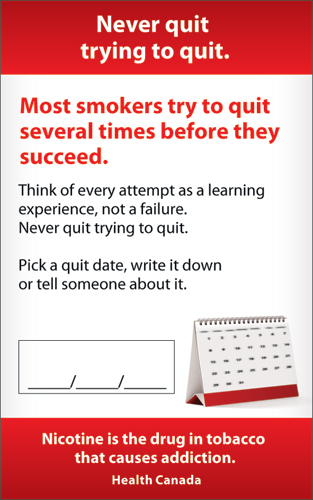
Text Description
An animated calendar and a date box.
The text reads:
Never quit trying to quit.
Most smokers try to quit several times before they succeed.
Think of every attempt as a learning experience, not a failure. Never quit trying to quit.
Pick a quit date, write it down or tell someone about it.
Nicotine is the drug in tobacco that causes addiction.
Health Canada
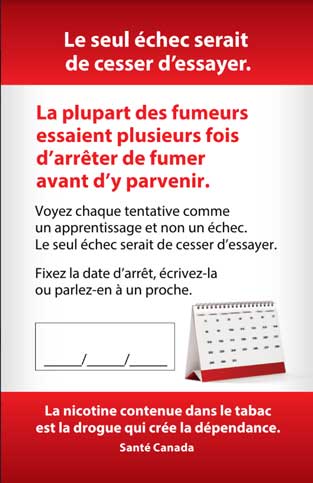
Description textuelle
Un calendrier animé et une boîte de date.
Le texte est le suivant :
Le seul échec serait de cesser d'essayer.
La plupart des fumeurs essaient plusieurs fois d'arrêter de fumer avant d'y parvenir.
Voyez chaque tentative comme un apprentissage et non un échec. Le seul échec serait de cesser d'essayer.
Fixez la date d'arrêt, écrivez-la ou parlez-en à un proche.
La nicotine contenue dans le tabac est la drogue qui crée la dépendance.
Santé Canada
This HIM was recalled by around a quarter of those who it was shown to. Its colour is the most striking feature.
% of respondents exposed to this HIM who recall it: 28%
A little over a quarter (28%) of F/T package users who were shown this HIM say that they recall seeing it. The red colour is what caught more than half of people's eye (52%) with the headline being the second most noticeable element (21%). Around two thirds feel the HIM is interesting (65%) and four in five consider it the right length (80%). The proportion seeing it as credible/believable is 85 percent.
| Figure 30: Responses for CurrentHIM_3_FlipTop (n=468) | |
|---|---|
| Q19. What first catches your eye? | Overall |
| The image/picture | 9% |
| The headline at the top of the message | 21% |
| The overall subject of the message | 12% |
| The colour | 52% |
| The text in the body of the message | 4% |
| Other | 1% |
| Q20. How interesting is the topic of the message? | Overall |
| Very/somewhat interesting | 65% |
| Very interesting | 20% |
| Somewhat interesting | 45% |
| Not very interesting | 25% |
| Not at all interesting | 10% |
| Q21. Do you feel the message is.... | Overall |
| Too long | 16% |
| About the right length | 80% |
| Too short | 4% |
| Q22. How credible or believable is this message? | Overall |
| % Very/somewhat credible | 85% |
| Very | 39% |
| Somewhat | 46% |
| Not very | 11% |
| Not at all | 3% |
Significant demographic subgroup differences in evaluations of this HIM:
- Respondents 65 years or older are more likely to than younger groups to see the overall subject of the message as the most noticeable element (22%). Those who intend to quit in the next six months are more likely than others to note the text in the message's body (12%).
- Those who are more likely to find the topic interesting are 16-17 year-olds (94%), those who are planning to quit in the next three or six months (respectively, 75% and 81%), those who want to quit but haven't thought about when (74%), females (72%) and those who have tried to quit in the past (69%).
- Those who do not want to quit are more inclined to find the message too long (39%).
- People who are more likely to find the message credible/believable are those who have tried to quit in the past (90%) and daily smokers (88%).
HIM Evaluation: CurrentHIM_3_SLIDESHELL
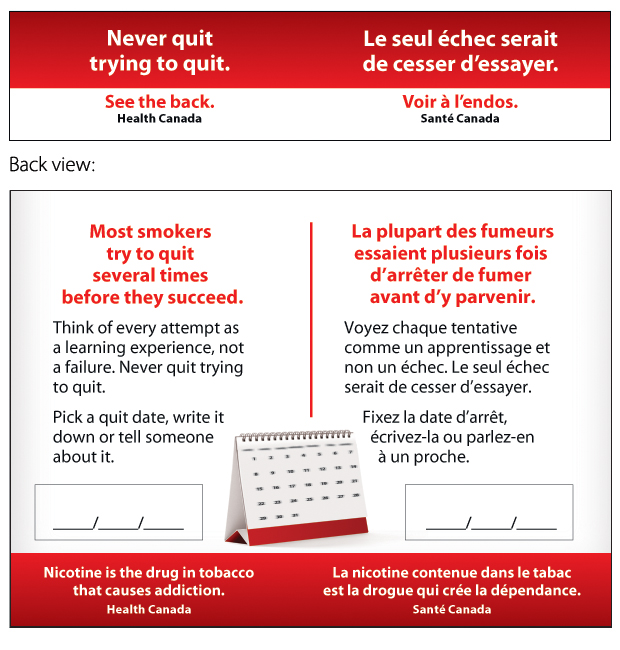
Text Description
An animated calendar and a date box.
Written in both official languages.
The text reads:
Never quit trying to quit.
See the back.
Health Canada
Most smokers try to quit several times before they succeed.
Think of every attempt as a learning experience, not a failure. Never quit trying to quit.
Pick a quit date, write it down or tell someone about it.
Nicotine is the drug in tobacco that causes addiction.
Health Canada
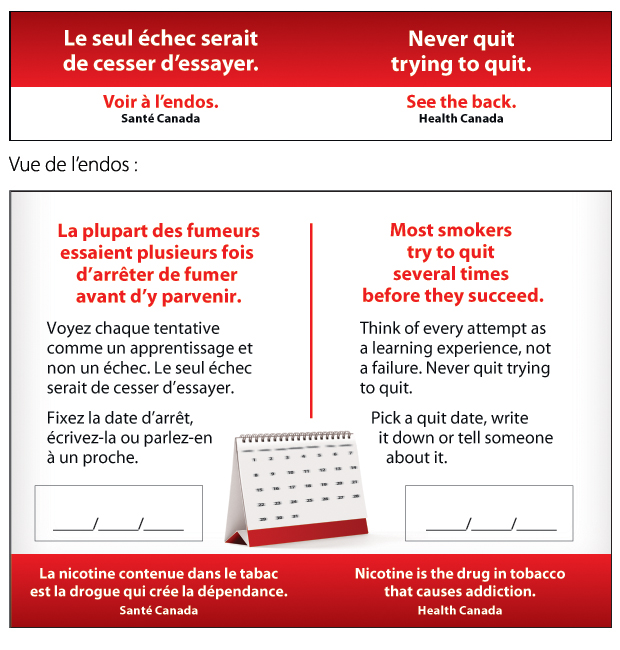
Description textuelle
Un calendrier animé et une boîte de date.
Écrit dans les deux langues officielles.
Le texte est le suivant :
Le seul échec serait de cesser d'essayer.
Voir à l'endos.
Santé Canada
La plupart des fumeurs essaient plusieurs fois d'arrêter de fumer avant d'y parvenir.
Voyez chaque tentative comme un apprentissage et non un échec.
Le seul échec serait de cesser d'essayer.
Fixez la date d'arrêt, écrivez-la ou parlez-en à un proche.
La nicotine contenue dans le tabac est la drogue qui crée la dépendance.
Santé Canada
The colour of this HIM is the first thing most respondents noticed and a quarter of those who were shown it recalled seeing it.
% of respondents exposed to this HIM who recall it: 26%
Roughly one quarter (26%) of S/S package users who were shown this HIM said that they recall seeing it. The bright red colour is what catches a majority of people's eye (55%) with the overall subject of the message being the second most noticeable element (19%). Three quarters see this HIM as interesting (74%) and two thirds (67%) consider it the right length (67%). More than four in five (84%) see it as credible/believable.
| Figure 31: Responses for CurrentHIM_3_SlideShell (n=214) | |
|---|---|
| Q19. What first catches your eye? | Overall |
| The image/picture | 12% |
| The headline at the top of the message | 13% |
| The overall subject of the message | 19% |
| The colour | 55% |
| The text in the body of the message | <1% |
| Other | 1% |
| Q20. How interesting is the topic of the message? | Overall |
| Very/somewhat interesting | 74% |
| Very interesting | 27% |
| Somewhat interesting | 47% |
| Not very interesting | 18% |
| Not at all interesting | 8% |
| Q21. Do you feel the message is.... | Overall |
| Too long | 31% |
| About the right length | 67% |
| Too short | 2% |
| Q22. How credible or believable is this message? | Overall |
| % Very/somewhat credible | 84% |
| Very | 34% |
| Somewhat | 50% |
| Not very | 13% |
| Not at all | 3% |
Significant demographic subgroup differences in evaluations of this HIM:
- Those more likely to have first noticed the colour are people with incomes between $80-$100k (74%). People who first notice the headline at the top of the message are more likely to be daily smokers (17%). Those more inclines to first notice the image/picture are people who have children living in their household (19%).
- People who are less likely to find the message credible are those who have never tried to quit in the past (70%) and people who smoke 25+ cigarettes a day (58%).
HIM Evaluation: CurrentHIM_4_FLIPTOP

Text Description
A young women smiling.
The text reads:
"I had enough of feeling guilty …"
"Quitting is hard and it takes a lot of will power.
I had enough of feeling guilty. I was ashamed of being a smoker.
When I was ready to quit, I called a quitline and, with their support, I made it thought the first few days of cravings.
As the days went by, I was more and more proud of myself and my will to keep going got stronger."
- Susan
1-866-366-3667
Tobacco products are highly addictive.
Health Canada
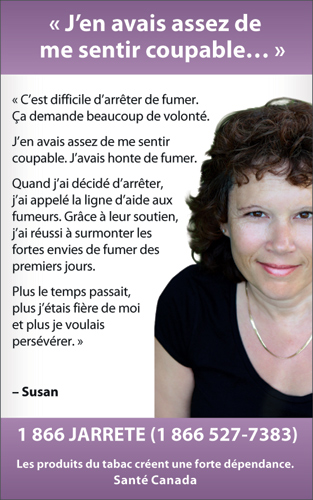
Description textuelle
Une jeune femme souriante.
Le texte est le suivant :
« J'en avais assez de me sentir coupable… »
« C'est difficile d'arrêter de fumer. Ça demande beaucoup de volonté.
J'en avais assez de me sentir coupable. J'avais honte de fumer.
Quand j'ai décidé d'arrêter j'ai appelé la ligne d'aide aux fumeurs. Grâce à leur soutien, j'ai réussi à surmonter les fortes envies de fumer des premiers jours.
Plus le temps passait, plus j'étais fière de moi et plus je voulais persévérer. »
- Susan
1 866 JARRETE (1 866 527-7383)
Les produits du tabac créent une forte dépendance.
Santé Canada
Three in ten recalled this HIM with the image but it is rated as less interesting than most HIM and many consider it too long.
% of respondents exposed to this HIM who recall it: 30%
Three in ten flip-top package users who were shown this HIM say that they recall seeing it. Although the image caught people's eye the most often (31%), the headline at the top of the message (22%) and the colour (20%) are also common responses. Six in ten rate this HIM as interesting (62%) and a similar proportion say it is the right length (59% with 40% saying it is too long). Three quarters see it as credible/ believable (77%).
| Figure 32: Responses for CurrentHIM_4_FlipTop (n=473) | |
|---|---|
| Q19. What first catches your eye? | Overall |
| The image/picture | 31% |
| The headline at the top of the message | 22% |
| The overall subject of the message | 17% |
| The colour | 20% |
| The text in the body of the message | 4% |
| Quitline number/website | 3% |
| Other | 3% |
| Q20. How interesting is the topic of the message? | Overall |
| Very/somewhat interesting | 62% |
| Very interesting | 16% |
| Somewhat interesting | 46% |
| Not very interesting | 23% |
| Not at all interesting | 14% |
| Q21. Do you feel the message is.... | Overall |
| Too long | 40% |
| About the right length | 59% |
| Too short | 1% |
| Q22. How credible or believable is this message? | Overall |
| % Very/somewhat credible | 77% |
| Very | 28% |
| Somewhat | 49% |
| Not very | 15% |
| Not at all | 7% |
Significant demographic subgroup differences in evaluations of this HIM:
- Those saying the colour caught their eye are more likely to be English speakers (23%). People more likely to say the image/picture did are those with a university education (42%) and those saying the headline is the most noticeable are more likely to be female (27%).
- Those who are more likely to find the topic interesting are those planning to quit in the next three or six months (respectively, 76% and 70%) and people with children in the household (70%).
- Those more inclined to find the message too long are people who either do not want to stop smoking (58%), those 18-24 years old (57%), people who know they should quit but don't really want to (49%), French speakers (49%), those with a university degree (47%) and those with a college degree (43%).
- Those who are less likely to see this HIM as credible/believable are those who have never tried to quit before (67%) and people do not want to stop smoking (47%).
HIM Evaluation: CurrentHIM_4_SLIDESHELL
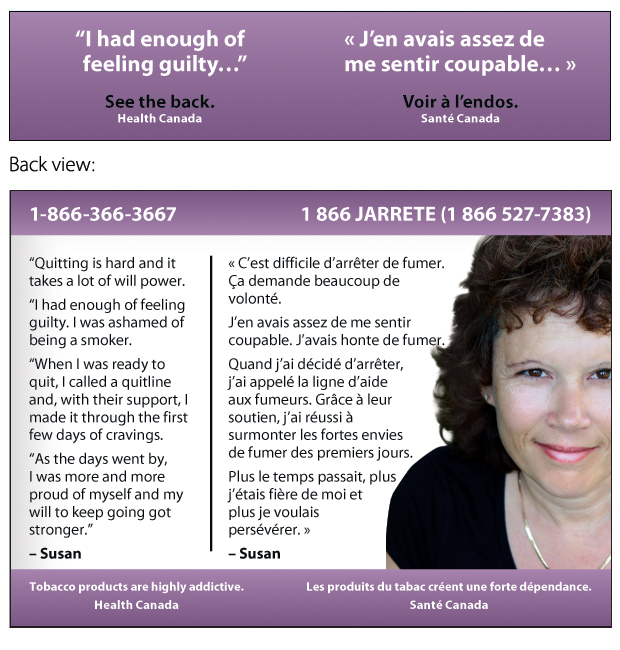
Text Description
A young women smiling.
The text reads:
"I had enough of feeling guilty …"
See the back.
Health Canada
Back view
1-866-366-3667
"Quitting is hard and it takes a lot of will power.
I had enough of feeling guilty. I was ashamed of being a smoker.
When I was ready to quit, I called a quitline and, with their support, I made it thought the first few days of cravings.
As the days went by, I was more and more proud of myself and my will to keep going tot stronger."
- Susan
1-866-366-3667
Tobacco products are highly addictive.
Health Canada
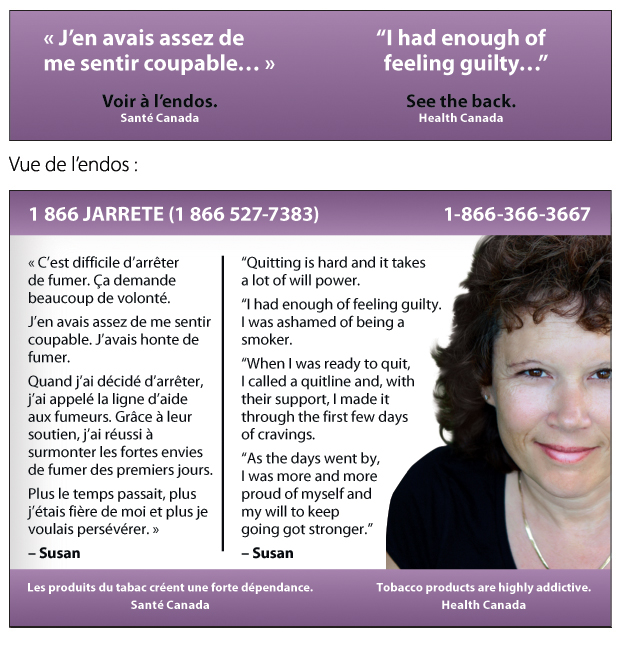
Description textuelle
Une jeune femme souriante.
Écrit dans les deux langues officielles.
Le texte est le suivant :
« J'en avais assez de me sentir coupable… »
Voir à l'endos.
Santé Canada
« C'est difficile d'arrêter de fumer. Ça demande beaucoup de volonté.
J'en avais assez de me sentir coupable. J'avais honte de fumer.
Quand j'ai décidé d'arrêter j'ai appelé la ligne d'aide aux fumeurs. Grâce à leur soutien, j'ai réussi à surmonter les fortes envies de fumer des premiers jours.
Plus le temps passait, plus j'étais fière de moi et plus je voulais persévérer. »
- Susan
1 866 JARRETE (1 866 527-7383)
Les produits du tabac créent une forte dépendance.
Santé Canada
The image and the colour of this HIM are what respondents notice most immediately, but this HIM is not recalled often.
% of respondents exposed to this HIM who recall it: 21%
One in five S/S package users who were shown this HIM said that they recall seeing it. Although the image caught people's eye the most often (35%), the colour (28%) also caught people's eye. Three in five find this HIM interesting (61%) and three quarters find it believable (77%). More than half of respondents who evaluated this HIM feel it is too long (51%).
| Figure 33: Responses for CurrentHIM_4_SlideShell (n=203) | |
|---|---|
| Q19. What first catches your eye? | Overall |
| The image/picture | 35% |
| The headline at the top of the message | 14% |
| The overall subject of the message | 12% |
| The colour | 28% |
| The text in the body of the message | 3% |
| Quitline number/website | 6% |
| Other | 2% |
| Q20. How interesting is the topic of the message? | Overall |
| Very/somewhat interesting | 61% |
| Very interesting | 15% |
| Somewhat interesting | 46% |
| Not very interesting | 27% |
| Not at all interesting | 12% |
| Q21. Do you feel the message is.... | Overall |
| Too long | 51% |
| About the right length | 48% |
| Too short | 1% |
| Q22. How credible or believable is this message? | Overall |
| % Very/somewhat credible | 77% |
| Very | 21% |
| Somewhat | 56% |
| Not very | 19% |
| Not at all | 5% |
Significant demographic subgroup differences in evaluations of this HIM:
- The respondents who say that the colour first caught their eye are more likely to be people who have tried to quit in the past (45%) and those with children in the household (33%).
- Interest in the topic is higher among those who are planning to quit smoking in the next three or six months. (respectively, 74% and 73%).
HIM Evaluation: CurrentHIM_5_FLIPTOP
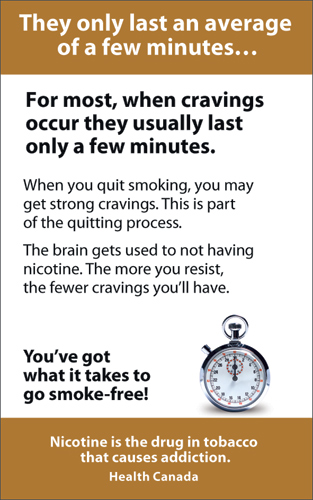
Text Description
A stop watch at the bottom of the page.
The text reads:
They only last an average of a few minutes…
For most, when cravings occur they usually last only a few minutes.
When you quit smoking, you may get strong cravings. This is part of the quitting process.
The brain gets used to not having nicotine. The more you resist, the fewer cravings you'll have.
You've got what it takes to go smoke-free!
Nicotine is the drug in tobacco that causes addiction.
Health Canada
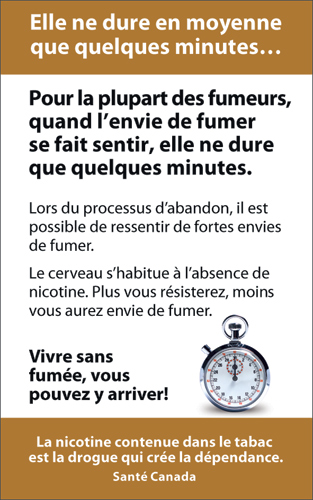
Description textuelle
Un chronomètre au bas de la page.
Le texte est le suivant :
Elle ne dure en moyenne que quelques minutes…
Pour la plupart des fumeurs, quand l'envie de fumer se fait sentir, elle ne dure que quelques minutes.
Lors du processus d'abandon, il est possible de ressentir de fortes envies de fumer.
Le cerveau s'habitue à l'absence de nicotine. Plus vous résisterez moins vous aurez envie de fumer.
Vivre sans fumée, vous pouvez y arriver!
La nicotine contenue dans le tabac est la drogue qui crée la dépendance.
Santé Canada
No single aspect of this HIM catches the eye of respondents.
% of respondents exposed to this HIM who recall it: 29%
Around three in ten F/T package users (29%) shown this HIM recall seeing it. There is no clear attention-grabbing element of this HIM, but a plurality chooses the image (27%) as what caught their eye first. Seven in ten feel this HIM is interesting (71%), three quarters (74%) consider it the right length an even larger proportion feel it is believable (87%).
| Figure 34: Responses for CurrentHIM_5_FlipTop (n=477) | |
|---|---|
| Q19. What first catches your eye? | Overall |
| The image/picture | 27% |
| The headline at the top of the message | 20% |
| The overall subject of the message | 21% |
| The colour | 22% |
| The text in the body of the message | 6% |
| Other | 4% |
| Q20. How interesting is the topic of the message? | Overall |
| Very/somewhat interesting | 71% |
| Very interesting | 17% |
| Somewhat interesting | 54% |
| Not very interesting | 19% |
| Not at all interesting | 9% |
| Q21. Do you feel the message is.... | Overall |
| Too long | 25% |
| About the right length | 74% |
| Too short | 1% |
| Q22. How credible or believable is this message? | Overall |
| % Very/somewhat credible | 87% |
| Very | 34% |
| Somewhat | 53% |
| Not very | 9% |
| Not at all | 4% |
Significant demographic subgroup differences in evaluations of this HIM:
- Those who are less likely to see the image/picture as the most noticeable element are those with no children in the household (24%), French speakers (20%) and those 65 years of age or older (11%).
- People who are more likely to find the topic of interest are those who are planning to quit in the next three or six months (respectively, 84% and 82%), those with a university degree (77%) and those who have tried to quit in the past (74%).
- People more inclined to find the message too long are those who do not want to quit (47%), those who have never tried to quit (37%), French speakers (36%) and people with children in their household (34%).
- People who are more likely to find the message credible/believable are females (92%) and those who have tried to quit in the past (90%).
HIM Evaluation: CurrentHIM_5_SLIDESHELL
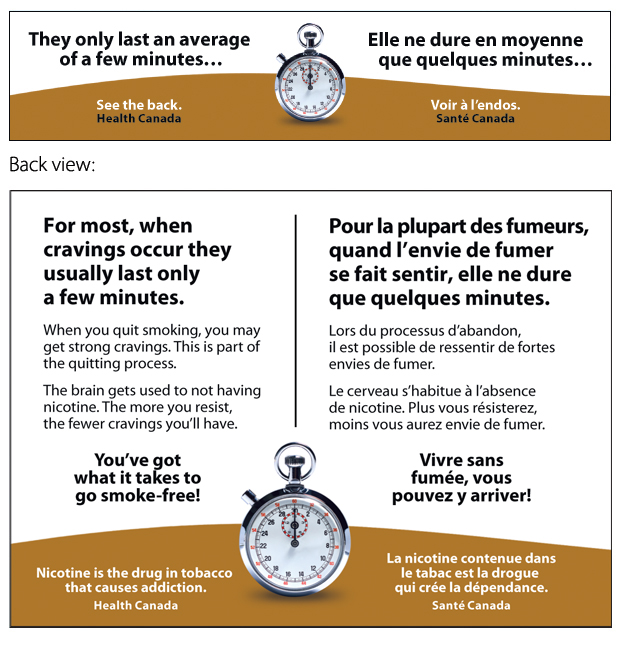
Text Description
A stop watch at the top and bottom of the page.
Written in both official languages.
The text reads:
They only last an average of a few minutes…
See the back.
Health Canada
Back view
For most, when cravings occur they usually last only a few minutes.
When you quit smoking, you may get strong cravings. This is part of the quitting process.
The brain gets used to not having nicotine. The more you resist, the fewer cravings you'll have.
You've got what it takes to go smoke-free!
Nicotine is the drug in tobacco that causes addiction.
Health Canada

Description textuelle
Un chronomètre en haut et en bas de la page.
Écrit dans les deux langues officielles.
Le texte est le suivant :
Elle ne dure en moyenne que quelques minutes…
Voir à l'endos.
Santé Canada
Pour la plupart des fumeurs, quand l'envie de fumer se fait sentir, elle ne dure que quelques minutes.
Lors du processus d'abandon, il est possible de ressentir de fortes envies de fumer.
Le cerveau s'habitue à l'absence de nicotine. Plus vous résisterez moins vous aurez envie de fumer.
Vivre sans fumée, vous pouvez y arriver!
La nicotine contenue dans le tabac est la drogue qui crée la dépendance.
Santé Canada
While the F/T version of this HIM does not have a standout element, respondents are more likely to focus on the image in the S/S version and provide high scores on interest and credibility.
% of respondents exposed to this HIM who recall it: 24%
Around a quarter (24%) of the S/S package users who were shown this HIM recall seeing it. The S/S version of this HIM's most noticeable feature is the image (43%) followed by the overall subject matter (23%). This HIM receives high scores in terms of being interesting (82%) and believable (87%) and seven in ten say it is the right length (70%).
Figure 35: Responses for CurrentHIM_5_SlideShell (n=224) |
|
|---|---|
| Q19. What first catches your eye? | Overall |
| The image/picture | 43% |
| The headline at the top of the message | 17% |
| The overall subject of the message | 23% |
| The colour | 9% |
| The text in the body of the message | 6% |
| Other | 2% |
| Q20. How interesting is the topic of the message? | Overall |
| Very/somewhat interesting | 82% |
| Very interesting | 27% |
| Somewhat interesting | 55% |
| Not very interesting | 13% |
| Not at all interesting | 5% |
| Q21. Do you feel the message is.... | Overall |
| Too long | 29% |
| About the right length | 70% |
| Too short | 1% |
| Q22. How credible or believable is this message? | Overall |
| % Very/somewhat credible | 87% |
| Very | 39% |
| Somewhat | 48% |
| Not very | 10% |
| Not at all | 3% |
Significant demographic subgroup differences in evaluations of this HIM:
- People who are more likely to find the topic of interest are those who smoke between 5 and 9 cigarettes a day (96%) and those who are planning to quit in the next three or six months (respectively, 93% and 92%).
- Those more inclined to find the message too long are females (39%) and daily smokers (33%). Those more likely to say it was the right length are people who intend to quit in the next three months (92%).
- Those significantly more likely to find the message credible/believable are people with children living in the household (94%).
HIM Evaluation: CurrentHIM_6_FLIPTOP
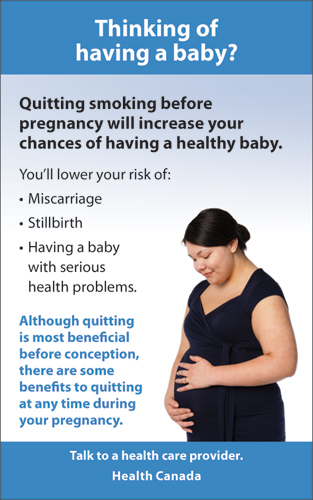
Text Description
A young pregnant women holding her stomach.
The text reads:
Thinking of having a baby?
Quitting smoking before pregnancy will increase your chances of having a health baby.
You'll lower your risk of:
- Miscarriage
- Stillbirth
- Having a baby with serious health problems.
Although quitting is most beneficial before conception, there are some benefits to quitting at any time during your pregnancy.
Talk to a health care provider.
Health Canada
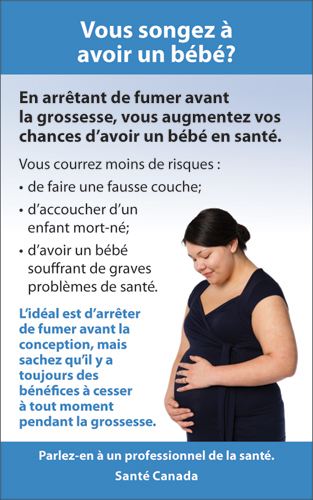
Description textuelle
Une jeune femme enceinte se tenant le ventre.
Le texte est le suivant :
Vous songez à avoir un bébé?
En arrêtant de fumer avant la grossesse, vous augmentez vos chances d'avoir un bébé en santé.
Vous courrez moins de risques :
- De faire une fausse couche;
- D'accoucher d'un enfant mort/né
- D'avoir un bébé souffrant de graves problèmes des santé.
L'idéal est d'arrêter de fumer avant la conception, mais sachez qu'il y a toujours des bénéfices à cesser à tout moment pendant la grossesse.
Parlez-en à un professionnel de la santé.
Santé Canada
This HIM is well recalled and the image/picture is what catches the eye of most people evaluating it.
% of respondents exposed to this HIM who recall it: 46%
Almost half (46%) of the F/T package users who were shown this HIM say that they recall seeing it. The image is the most eye-catching element of this HIM (62%). Seven in ten find it interesting (70%) and three quarters (74%) say it is the right length. It is also seen by a large majority to be credible/believable (93%).
| Figure 36: Responses for CurrentHIM_6_FlipTop (n=608) | |
|---|---|
| Q19. What first catches your eye? | Overall |
| The image/picture | 62% |
| The headline at the top of the message | 9% |
| The overall subject of the message | 14% |
| The colour | 10% |
| The text in the body of the message | 4% |
| Other | 1% |
| Q20. How interesting is the topic of the message? | Overall |
| Very/somewhat interesting | 70% |
| Very interesting | 32% |
| Somewhat interesting | 38% |
| Not very interesting | 16% |
| Not at all interesting | 15% |
| Q21. Do you feel the message is.... | Overall |
| Too long | 25% |
| About the right length | 74% |
| Too short | 1% |
| Q22. How credible or believable is this message? | Overall |
| % Very/somewhat credible | 93% |
| Very | 54% |
| Somewhat | 39% |
| Not very | 4% |
| Not at all | 3% |
Significant demographic subgroup differences in evaluations of this HIM:
- Those who are more likely to see the image as the most noticeable are those who smoke 25 or more cigarettes a day (83%), those whose income is over $100k (80%), those who smoke occasionally (69%), those 45-64 and 65 years of age or older (65% for each group) and those aged 25-44 (64%).
- Those who first notice the overall subject of the message are more likely to be people whose income is below $40k (24%).
- Those who are more likely to find the topic interesting are younger people aged 16-17 (95%) or 18-24 (82%), people with children in the household (82%) and those planning to quit in the next three or six months (respectively, 79% and 78%).
- Those less likely to find the topic interesting are people who smoke 25 or more cigarettes a day (55%) and those who smoke 15-24 per day (53%).
- There is no significant difference in interest by gender.
- Only those who do not want to stop smoking are more inclined to find the message too long (51%).
HIM Evaluation: CurrentHIM_6_SLIDESHELL
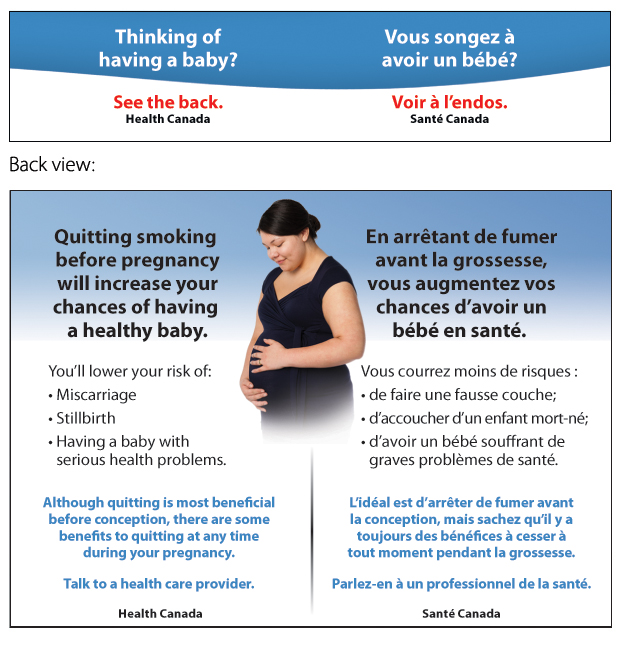
Text Description
A young pregnant women holding her stomach. Written in both official languages.
The text reads:
Thinking of having a baby?
See the back.
Health Canada
Back view
Quitting smoking before pregnancy will increase your chances of having a health baby.
You'll lower your risk of:
- Miscarriage
- Stillbirth
- Having a baby with serious health problems.
Although quitting is most beneficial before conception, there are some benefits to quitting at any time during your pregnancy.
Talk to a health care provider.
Health Canada
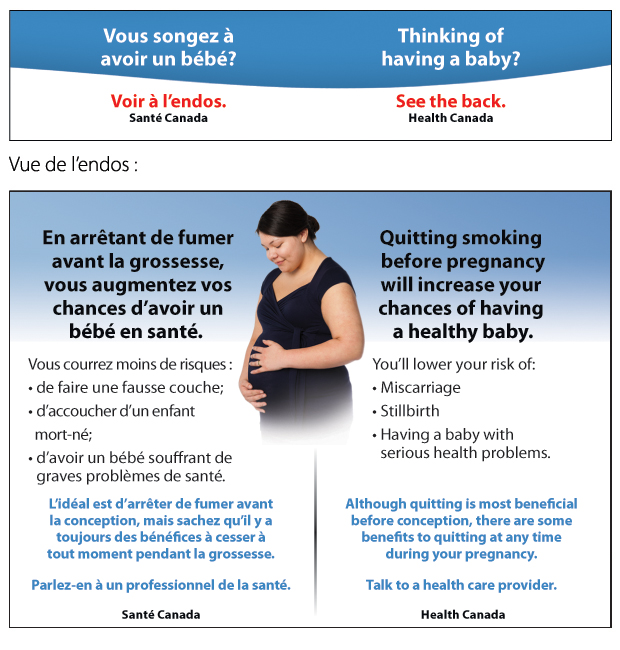
Description textuelle
Une jeune femme enceinte se tenant le ventre.
Écrit dans les deux langues officielles.
Le texte est le suivant :
Vous songez à avoir un bébé?
Voir à l'endos.
Santé Canada
En arrêtant de fumer avant la grossesse, vous augmentez vos chances d'avoir un bébé en santé.
Vous courrez moins de risques :
- De faire une fausse couche;
- D'accoucher d'un enfant mort/né
- D'avoir un bébé souffrant de graves problèmes des santé.
L'idéal est d'arrêter de fumer avant la conception, mais sachez qu'il y a toujours des bénéfices à cesser à tout moment pendant la grossesse.
Parlez-en à un professionnel de la santé.
Santé Canada
This HIM is well recalled and users of S/S packages rate it highly in terms of interest and credibility.
% of respondents exposed to this HIM who recall it: 46%
Almost half (46%) of the respondents who were shown this HIM in S/S version said that they recall seeing it. As with the F/T version, the image/picture is the most noticeable element (64%). Respondents have high levels of interest in the HIM (80%) and almost all feel it is credible/believable (93%). Seven in ten (71%) feel it is the right length.
| Figure 37: Responses for CurrentHIM_6_SlideShell (n=291) | |
|---|---|
| Q19. What first catches your eye? | Overall |
| The image/picture | 64% |
| The headline at the top of the message | 3% |
| The overall subject of the message | 18% |
| The colour | 11% |
| The text in the body of the message | 2% |
| Other | 1% |
| Q20. How interesting is the topic of the message? | Overall |
| Very/somewhat interesting | 80% |
| Very interesting | 31% |
| Somewhat interesting | 49% |
| Not very interesting | 13% |
| Not at all interesting | 8% |
| Q21. Do you feel the message is.... | Overall |
| Too long | 26% |
| About the right length | 71% |
| Too short | 2% |
| Q22. How credible or believable is this message? | Overall |
| % Very/somewhat credible | 93% |
| Very | 54% |
| Somewhat | 38% |
| Not very | 5% |
| Not at all | 2% |
Significant demographic subgroup differences in evaluations of this HIM:
- Those who are more likely to see the image as the most noticeable are those who have never tried to quit smoking before (75%). The people for whom the overall subject of the message catches their eye first are more likely to be those who smoke between 10-14 cigarettes a day (38%), males (24%) and daily smokers (23%).
- Those whose income is between $80-$100k are more likely to feel the message is too long (41%). However, the same income group is also more likely to rate the message as credible (100%) than other income groups.
HIM Evaluation: CurrentHIM_7_FLIPTOP
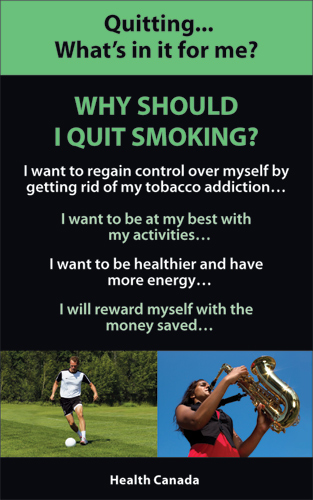
Text Description
A young women playing a trombone and another young women-playing soccer. Placed at the bottom of the page.
The text reads :
Quitting…
What's in it for me?
Why should I quit smoking?
I want to regain control over myself by getting rid of my tobacco addiction…
I want to be at my best with my activities…
I want to be at my best with my activities…
I want to be healthier and have more energy…
I will reward myself with the money saved…
Health Canada

Description textuelle
Une jeune femme jouant du trombone et une autre jeune femme jouant au soccer. Placé au bas de la page.
Le texte est le suivant :
J'arrête de fumer…
Qu'est-ce que j'y gagne?
Pourquoi est-ce que J'arrêterais de fumer?
Je veux reprendre le contrôle de ma vie en me libérant de ma dépendance au tabac…
Je veux être au mieux de ma forme pour mes activités…
Je veux être en santé et avoir plus d'énergie…
Je vais récompenser avec l'argent épargné…
Santé Canada
There is no element of this HIM that is more eye-catching than the others and two thirds see it as interesting.
% of respondents exposed to this HIM who recall it: 28%
A little over a quarter (28%) of respondents who were shown this HIM say they recall it. There is no single element that caught people's attention with roughly even proportions choosing the colour (25%), the headline or the image/picture (24% each) and the overall subject (21%). Two thirds (67%) of respondents see this HIM as interesting, three quarters (74%) think it is the right length (74%) and four in five (82%) feel it is credible/believable.
| Figure 38: Responses for CurrentHIM_7_FlipTop (n=477) | |
|---|---|
| Q19. What first catches your eye? | Overall |
| The image/picture | 24% |
| The headline at the top of the message | 24% |
| The overall subject of the message | 21% |
| The colour | 25% |
| The text in the body of the message | 4% |
| Other | 3% |
| Q20. How interesting is the topic of the message? | Overall |
| Very/somewhat interesting | 67% |
| Very interesting | 23% |
| Somewhat interesting | 44% |
| Not very interesting | 22% |
| Not at all interesting | 11% |
| Q21. Do you feel the message is.... | Overall |
| Too long | 24% |
| About the right length | 74% |
| Too short | 2% |
| Q22. How credible or believable is this message? | Overall |
| % Very/somewhat credible | 82% |
| Very | 33% |
| Somewhat | 48% |
| Not very | 14% |
| Not at all | 5% |
Significant demographic subgroup differences in evaluations of this HIM:
- People who see the image/picture as relatively more noticeable include those whose income is $100k or higher (34%), those who are 25-44 years of age (32%), those who have children in the household (32%) and those who have never tried to quit (31%). 16-17-year-olds are more likely to notice the overall subject of the message (43%) than other age groups.
- Those who are more likely to find the topic more interesting are 16-17 year-olds (96%), those who are planning to quit in the next six months (84%) and those who have tried to quit in the past (72%).
- People who are more likely to see the HIM as credible are those who smoke 5-9 cigarettes a day (92%), those planning to quit in the next three or six months (respectively, 91% and 90%) and those who have tried to quit in the past (86%).
HIM Evaluation: CurrentHIM_7_SLIDESHELL
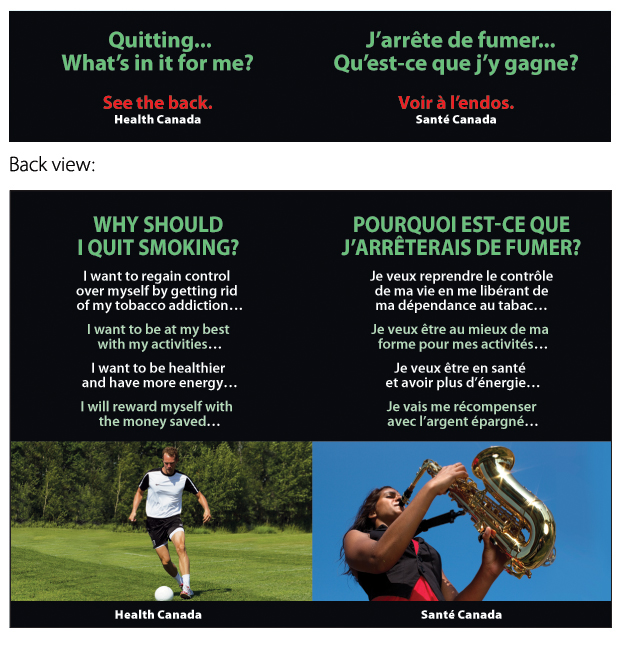
Text Description
A young women playing a trombone and another young women-playing soccer. Placed at the bottom of the page. Written in both official languages.
The text reads :
Quitting…
What's in it for me?
See the back.
Health Canada
Why should I quit smoking?
I want to regain control over myself by getting rid of my tobacco addiction…
I want to be at my best with my activities…
I want to be at my best with my activities…
I want to be healthier and have more energy…
I will reward myself with the money saved…
Health Canada
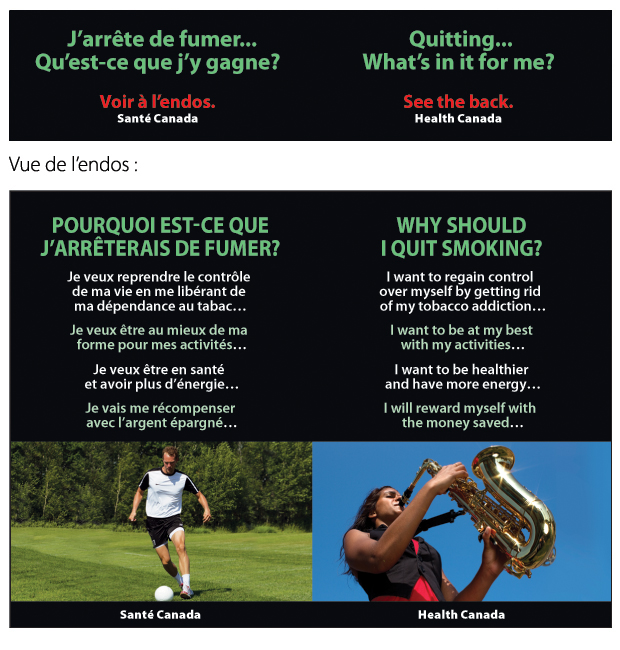
Description textuelle
Une jeune femme jouant du trombone et une autre jeune femme jouant au soccer. Placé au bas de la page.
Écrit dans les deux langues officielles.
Le texte est le suivant :
J'arrête de fumer…
Qu'est-ce que j'y gagne?
Voir à l'endos.
Santé Canada
Pourquoi est-ce que J'arrêterais de fumer?
Je veux reprendre le contrôle de ma vie en me libérant de ma dépendance au tabac…
Je veux être au mieux de ma forme pour mes activités…
Je veux être en santé et avoir plus d'énergie…
Je vais récompenser avec l'argent épargné…
Santé Canada
Unlike the F/T version of this HIM, which was more balanced in terms of noticeable elements, people are more likely to focus on the images in the S/S version.
% of respondents exposed to this HIM who recall it: 22%
Around one in five (22%) S/S package users who were exposed to this HIM say that they recall seeing it. The image/picture is the most attention-grabbing element (41%) in the S/S version. Seven in ten evaluating the HIM say it is interesting (69%) and the same proportion say it is the right length. Greater that four in five say this HIM is credible/believable (83%).
| Figure 39: Responses for CurrentHIM_7_SlideShell (n=202) | |
|---|---|
| Q19. What first catches your eye? | Overall |
| The image/picture | 41% |
| The headline at the top of the message | 14% |
| The overall subject of the message | 21% |
| The colour | 19% |
| The text in the body of the message | 3% |
| Other | 2% |
| Q20. How interesting is the topic of the message? | Overall |
| Very/somewhat interesting | 69% |
| Very interesting | 18% |
| Somewhat interesting | 51% |
| Not very interesting | 21% |
| Not at all interesting | 11% |
| Q21. Do you feel the message is.... | Overall |
| Too long | 29% |
| About the right length | 69% |
| Too short | 2% |
| Q22. How credible or believable is this message? | Overall |
| % Very/somewhat credible | 83% |
| Very | 28% |
| Somewhat | 54% |
| Not very | 12% |
| Not at all | 5% |
Significant demographic subgroup differences in evaluations of this HIM:
- People who are more likely to find the topic interesting are those whose income is $100k or more (86%), 25-44 year-olds (83%) and those with a university degree (81%).
- French respondents are more likely to consider the message too long (47%).
- Credibility is higher among those who plan to quit in the next six months (98%) and those with a university degree (95%).
HIM Evaluation: CurrentHIM_8_FLIPTOP
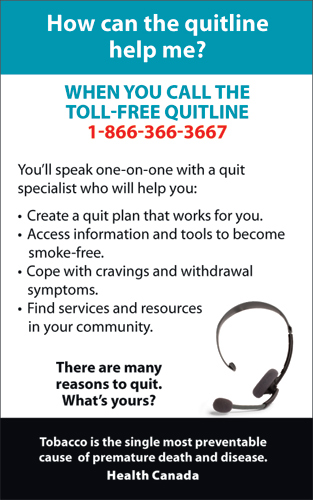
Text Description
A telephone headset at the bottom of the page.
The text reads:
How can the quitline help me?
When you call the toll-free quitline
1-866-366-3667
You'll speak one-on-one with a quit specialist who will help you:
- Create a quit plan that works for you.
- Access information and tools to become smoke-free.
- Cope with cravings and withdrawal symptoms.
- Find services and resources in your community.
There are many reasons to quit. What's yours?
Tobacco is the single most preventable cause of premature death and disease.
Health Canada
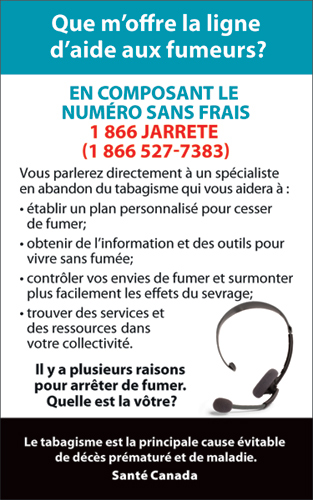
Description textuelle
Un casque téléphonique en bas de page.
Le texte est le suivant :
Que m'offre la ligne d'aide aux fumeurs?
En composant le numéro sans frais 1 866 JARRETE (1 866 527-7383)
Vous parlerez directement à un spécialiste en abandon du tabagisme qui vous aidera à :
- Établir un plan personnalisé pour cesser de fumer;
- Obtenir de l'information et des outils pour vivre sans fumée;
- Contrôler vos envies de fumer et surmonter plus facilement les effets du sevrage;
- Trouver des services et des ressources dans votre collectivité.
Il y plusieurs raisons pour arrêter de fumer.
Quelle est la vôtre?
Le tabagisme est la principale cause évitable de décès prématuré et de maladie.
Santé Canada
The prominent position of the quitline differentiates this HIM and around a third of F/T users who were shown it recall seeing it.
% of respondents exposed to this HIM who recall it: 32%
Just under a third (32%) of all flip-top users who were shown this HIM say that they recall it. The headline caught people's eye the most often (27%) and others mention the overall subject and the colour (18% each). A smaller proportion mention the quitline itself (16%). Around two thirds of respondents find the HIM interesting (64%) and agree that it is the right length (68%). Four in five see it as credible (83%).
| Figure 40: Responses for CurrentHIM_8_FlipTop (n=501) | |
|---|---|
| Q19. What first catches your eye? | Overall |
| The image/picture | 14% |
| The headline at the top of the message | 27% |
| The overall subject of the message | 18% |
| The colour | 18% |
| The text in the body of the message | 5% |
| Quitline number/website | 16% |
| Other | 2% |
| Q20. How interesting is the topic of the message? | Overall |
| Very/somewhat interesting | 64% |
| Very interesting | 17% |
| Somewhat interesting | 47% |
| Not very interesting | 26% |
| Not at all interesting | 10% |
| Q21. Do you feel the message is.... | Overall |
| Too long | 30% |
| About the right length | 68% |
| Too short | 2% |
| Q22. How credible or believable is this message? | Overall |
| % Very/somewhat credible | 83% |
| Very | 30% |
| Somewhat | 54% |
| Not very | 13% |
| Not at all | 4% |
Significant demographic subgroup differences in evaluations of this HIM:
- People who are more likely to say the colour caught their eye are those whose income is between $40 and $80k (28%) and English speakers (19%). Those who are more likely to say the quitline is the most noticeable element are those who intend to quit in the next thre months (28%) and those who smoke occasionally (23%).
- Those who are more likely to find the topic interesting are 16-17 year-olds (95%), those planning to quit in the next three or six months (respectively, 74% and 79%), those with a college education (72%) and those who have tried to quit in the past (67%).
- Those more inclined to find the message too long are French speakers (41%) and those with children in the household (33%).
- Those who are more likely see the HIM as credible are 16-17 year-olds (96%).
HIM Evaluation: CurrentHIM_8_SLIDESHELL

Text Description
A phone headset at the top of the page and a young man wearing a headset with two other people faded out wearing phone headsets.
Written in both official languages.
The text reads:
How can the quitline help me?
See the back.
Health Canada
How can the quitline help me?
When you call the toll-free quitline
1-866-366-3667
You'll speak one-on-one with a quit specialist who will help you:
- Create a quit plan that works for you.
- Access information and tools to become smoke-free.
- Cope with cravings and withdrawal symptoms.
- Find services and resources in your community.
There are many reasons to quit. What's yours?
Tobacco is the single most preventable cause of premature death and disease.
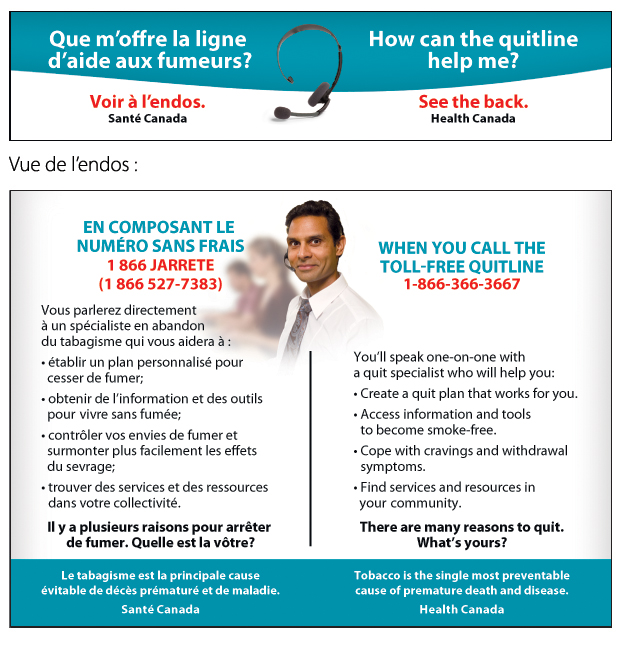
Description textuelle
Un casque téléphonique en haut de la page et un jeune homme portant un casque audio et deux personnes s'est évanouie avec des casques téléphoniques.
Écrit dans les deux langues officielles.
Le texte est le suivant :
Que m'offre la ligne d'aide aux fumeurs?
Voir à l'endos.
Santé Canada
Que m'offre la ligne d'aide aux fumeurs?
En composant le numéro sans frais 1 866 JARRETE (1 866 527-7383)
Vous parlerez directement à un spécialiste en abandon du tabagisme qui vous aidera à :
- Établir un plan personnalisé pour cesser de fumer;
- Obtenir de l'information et des outils pour vivre sans fumée;
- Contrôler vos envies de fumer et surmonter plus facilement les effets du sevrage;
- Trouver des services et des ressources dans votre collectivité.
Il y plusieurs raisons pour arrêter de fumer.
Quelle est la vôtre?
Le tabagisme est la principale cause évitable de décès prématuré et de maladie.
Santé Canada
The quitline is not noticed as prominently in the S/S version of this HIM and the image is the most noticeable element.
% of respondents exposed to this HIM who recall it: 22%
Just over one in five (22%) of all S/S package users who were shown this HIM recall seeing it. The image/picture catches people's eye most often (32%) but the headline (22%) and the colour (21%) are also commonly mentioned. The quitline is mentioned by 16% of F/T package users in that version, very few mention it (2%) in the S/S version. Three quarters of respondents find this HIM interesting (75%) and two thirds feel it is the right length (64%). Almost nine in ten see this HIM as credible (87%).
| Figure 41: Responses for CurrentHIM_8_SlideShell (n=206) | |
|---|---|
| Q19. What first catches your eye? | Overall |
| The image/picture | 32% |
| The headline at the top of the message | 22% |
| The overall subject of the message | 19% |
| The colour | 21% |
| The text in the body of the message | 2% |
| Quitline number/website | 2% |
| Other | 1% |
| Q20. How interesting is the topic of the message? | Overall |
| Very/somewhat interesting | 75% |
| Very interesting | 19% |
| Somewhat interesting | 56% |
| Not very interesting | 19% |
| Not at all interesting | 6% |
| Q21. Do you feel the message is.... | Overall |
| Too long | 35% |
| About the right length | 64% |
| Too short | 0% |
| Q22. How credible or believable is this message? | Overall |
| % Very/somewhat credible | 87% |
| Very | 31% |
| Somewhat | 56% |
| Not very | 10% |
| Not at all | 3% |
Significant demographic subgroup differences in evaluations of this HIM:
- Those who are more likely to say the colour caught their eye are those who smoke 10 to 14 cigarettes a day (34%) and people with a college education (31%). Those aged 25-44 are more likely to first notice the image (43%). Males are more likely to say they noticed the overall subject of the message first (30%).
- People who smoke 5 to 9 cigarettes a day are more likely to find the topic interesting (88%).
- Those more inclined to find the message too long are those who smoke 10 to 14 cigarettes a day (58%) and French speakers (51%).
- People who are more likely see the HIM as credible are those with an education level no higher than high school (95%).
Future placement of HIM
An insert and the inside flap are the most common suggestions for where to put new HIM on S/S packages where they will be noticed.
Respondents were asked to select the best location to promote noticeability of new HIM on slide and shell packages (regardless of what kind of package they usually use). Overall, the most common response was to suggest an insert similar to what is included in F/T packages (42%). Another common suggestion was the inside flap of the slide (36%) which would be visible each time the package is opened.
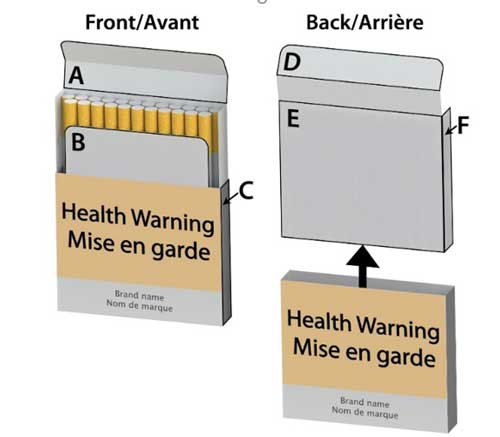
Text Description
Slide and shell cigarette package showing front, back and slide portion all separated. One English and one French.
Health warning
Mise en garde
Each part is numbered.
- top opening
- health information slide
- Side of package
- back of opening
- back of package
- side of back of package
HIM readers are particularly in favour of an insert in slide and shell packages (54%). The idea of including an insert is also as popular among F/T package users (41%) as it is with S/S package users (42%). However, it becomes a less popular suggestion among the group of F/T package users who say they discard the insert upon opening their cigarette package (31%).
The current location of HIM are not chosen as often as some of the other the proposed locations with around a quarter of respondents suggesting the backside of the slide (26%) and one in five selecting the outside flap of the slide. Although S/S package users are more likely to suggest both of these locations than F/T package users, they also made a lot more suggestions for locations as a group.
| Preferred placement of future HIM | Overall | Flip-top | Slide and Shell | HIM reader | Non-HIM reader | Discards inserts (F/T only) |
|---|---|---|---|---|---|---|
| Base size | 3,000 | 2,071 | 929 | 1,350 | 1,650 | 612 |
| Section B - An insert into the package | 42% | 41% | 42% | 54% | 32% | 31% |
| Section A - Inside flap on the slide | 36% | 34% | 40% | 39% | 33% | 31% |
| Section C - Either side of the shell | 30% | 30% | 30% | 33% | 27% | 31% |
| Section E - Backside of the slide | 26% | 23% | 32% | 31% | 22% | 22% |
| Section D - Outside flap on the slide | 19% | 18% | 22% | 23% | 16% | 16% |
| Section F - Side of the slide | 7% | 6% | 9% | 8% | 5% | 5% |
| None of these sections | 9% | 9% | 9% | 2% | 14% | 15% |
Q23. Please select all the places you think would be good to put a Health Message on a slide and shell package so that people would notice it each time they opened a pack. Base: All respondents
The table below splits out HIM-readers and non-readers by package type users. As in the table above, HIM-readers are more likely to make suggestions and significantly more likely to suggest inserts than Non-HIM readers (56% vs 31% for F/T package users and 49% vs 35% for S/S package users).
| Preferred placement of future HIM | F/T and HIM-reader | F/T and non-HIM-reader | S/S and HIM-reader | S/S and non-HIM reader |
|---|---|---|---|---|
| Base size | 882 | 1,189 | 468 | 461 |
| Section B - An insert into the package | 56% | 31% | 49% | 35% |
| Section A - Inside flap on the slide | 38% | 31% | 42% | 39% |
| Section C - Either side of the shell | 32% | 28% | 36% | 28% |
| Section E - Backside of the slide | 28% | 20% | 37% | 24% |
| Section D - Outside flap on the slide | 22% | 15% | 27% | 16% |
| Section F - Side of the slide | 7% | 5% | 11% | 7% |
| None of these sections | 2% | 14% | 3% | 15% |
Q23. Please select all the places you think would be good to put a Health Message on a slide and shell package so that people would notice it each time they opened a pack. Base: All respondents
Demographic differences:
- Those who are more likely to suggest an insert as a location for HIM include 16-17 year-olds (62%), those with children in the household (45%) and those with a high school education (46%).
- English and French speakers suggest inserts in roughly the same proportions, but French respondents are more likely to suggest the inside flap of the slide (39% vs.35% of English speakers) and English speakers more likely to suggest either side of the shell (32% vs. 23% of French speakers).
- Those who are significantly more likely to respond with 'none of the above' include those who say they don't want to stop smoking (23%) and respondents 65 years of age or older (17%).
D. Cessation and health information preferences
Advice/information and strategies
Compared to the experience of those who have previously attempted to quit, those who have not attempted to quit are more likely to anticipate they will use healthcare providers as a source of cessation information.
Respondents who have made a serious past attempt to quit were asked about the sources of information or advice they had used, while those who have not made such an attempt were asked what sources they would use if they decided to quit in the future.
Among both groups, the most common sources of advice/information include healthcare providers, family members and friends. Those who have not yet made a serious quit attempt are more likely than those who have to expect they will rely on a healthcare provider (37%) or other resources like websites (23%), social media (13%), a quitline (15%) or an app on their phone (7%). In turn, those who made a serious quit attempt are more likely to have relied on family members (29%) or to say they didn't use advice/information (34%).
| Sources of cessation advice/information | Overall (n=2,999) | Have attempted to quit | Have not attempted to quit |
|---|---|---|---|
| Base size | 2,999 | 2,217 | 782 |
| A healthcare provider (i.e. doctor, nurse, counsellor) | 31% | 28% | 37% |
| Family members | 27% | 29% | 21% |
| Friends | 26% | 26% | 26% |
| A website | 17% | 14% | 23% |
| Information on a cigarette package | 12% | 12% | 12% |
| Social media (e.g., Facebook, Instagram) | 11% | 10% | 13% |
| A quitline | 9% | 6% | 15% |
| An app downloaded to your phone | 5% | 4% | 7% |
| I didn't get any advice or information OR not interested in information/advice | 31% | 34% | 21% |
Q40. Thinking back to the times you attempted to quit smoking for more than 24 hours, where did you get advice or information, if any, on ways to quit? / If you decided to quit smoking in the future, where do you think you would you go to for advice or information about quitting? Base: All respondents. Note: only responses given by 2% or more are shown.
Demographic differences:
- Younger people (especially those 16-17 years of age) are significantly more likely than those over 65 to say they did/would get information from every single source except healthcare providers.
- Likelihood to mention healthcare providers as a source of advice/information is higher among those who smoke 25 or more each day (44%), those who smoke between 15-24 cigarettes per day (36%), and those who intend to quit in the next three months (35%).
- Reliance on friends or family for information/advice is higher among those planning to quit in the next six months (32% for family and 36% for friends) and occasional smokers (31% for family and 32% for friends).
- People with a higher likelihood of using a website include those with a university education (25%), people with children in their household (22%), occasional smokers (19%), and English speakers (18% vs. 13% of French speakers).
- Reliance on information on a cigarette package is higher among those with children in their household (17%), those who intend to quit in the next three months (16%), males (14% vs. 10% of females) and those with a university degree (14%).
Those who have attempted to quit are more likely to have tried to quit without specific assistance or a plan, whereas those who have not attempted to quit anticipate would be more likely to seek help.
Those who have attempted to quit are most likely to have tried 'cold turkey' without assistance (43%) or to have used nicotine replacement therapies (28%) or gradually reduced the number of cigarettes per day (26%).
When considering a future quit attempt, gradually reducing cigarettes is a more popular approach for those who have not attempted to quit (31%), and fewer of this group envision they will quit cold turkey (27%) or use a nicotine replacement therapy (24%). They are also more likely to say they would try other tools such as prescription medication, counselling, an organized quit program or a smartphone app.
| Cessation strategies/tools | Overall | Have attempted to quit | Have not attempted to quit |
|---|---|---|---|
| Base size | 3,000 | 2,218 | 782 |
| Cold turkey (quit without assistance) | 39% | 43% | 27% |
| Nicotine Replacement Therapy other than vaping (e.g. gum, patches, sprays, inhalers, or lozenges) | 27% | 28% | 24% |
| A plan to reduce the number of cigarettes smoked each day | 27% | 26% | 31% |
| Vaping products (e.g. e-cigarette, vape pen, vaporizer or vape mod) | 19% | 19% | 18% |
| Prescription medication from a health care provider | 16% | 15% | 19% |
| Counselling from a health care provider | 12% | 10% | 17% |
| An organized quit program or challenge | 10% | 9% | 15% |
| An app downloaded to your phone | 6% | 5% | 8% |
| I didn't use/I wouldn't use any strategies or tools | 11% | 9% | 15% |
Q41. Thinking back to the most recent time you attempted to quit smoking for more than 24 hours, what strategies or tools did you use? / If you decided to quit smoking, which strategies or tools do you think you would try? Base: All respondents Note: only responses given by 2% or more are shown.
Those aged 16-17 are the least likely to have/expect to quit cold turkey (27%) but are instead more likely to use almost every other strategy/tool than all of the other age groups. As the table highlights below, there are differences among age groups in what cessation strategies or tools they used or think they would use, with roughly one in ten saying that they didn't/would not use any strategies to quit (outside of 16-17 year-olds who are the least likely to say this).
| Cessation strategies/tools | 16-17 | 18-24 | 25-44 | 45-64 | 65+ |
|---|---|---|---|---|---|
| Base size | 187 | 332 | 1,060 | 1,124 | 297 |
| Cold turkey (quit without assistance) | 27% | 44% | 39% | 37% | 45% |
| Nicotine Replacement Therapy other than vaping (e.g. gum, patches, sprays, inhalers, or lozenges) | 31% | 25% | 25% | 29% | 28% |
| A plan to reduce the number of cigarettes smoked each day | 34% | 20% | 28% | 29% | 20% |
| Vaping products (e.g. e-cigarette, vape pen, vaporizer or vape mod) | 42% | 27% | 21% | 16% | 11% |
| Prescription medication from a health care provider | 29% | 10% | 15% | 17% | 19% |
| Counselling from a health care provider | 35% | 12% | 12% | 11% | 8% |
| An organized quit program or challenge | 32% | 13% | 13% | 7% | 3% |
| An app downloaded to your phone | 17% | 9% | 9% | 3% | - |
| "I didn't use any strategy or tool" OR "I wouldn't use any strategies or tools"? | 4% | 10% | 11% | 11% | 11% |
Q41. Thinking back to the most recent time you attempted to quit smoking for more than 24 hours, what strategies or tools did you use? / If you decided to quit smoking, which strategies or tools do you think you would try? Base: All respondents. Note: only responses given by 2% or more are shown.
Demographic differences:
- Males are more likely to have, or plan to, quit cold turkey (41% vs. 37% of females).
- The proportion who say they will use a plan to reduce the number of cigarettes is higher among those who plan to quit in the next six months (34%), those who have never tried to quit before (31%), those with a university degree (30%), English speakers (29% vs. 18% of French speakers) and daily smokers (29%).
- Likelihood to say they will use vaping products is higher among people who have children in the household (23%).
- Mentions of prescription medication are higher among those who smoke 25+ cigarettes a day (29%).
Interest in health information related to smoking
Those who say they plan to quit smoking in the next three or six months express greater interest in most health topics.
Respondents are most likely to express interest in information about how to end tobacco addiction (43%), how your health improves after quitting (42%) and how to reverse the negative effects of smoking (37%).
Interest in different types of information is closely connected to quit intention, with interest in most topics highest among those intending to quit in the next three months, followed by those who intend to quit in the next six months.
| Interesting health information | Overall | Don't want to stop |
Should quit but don't want to |
Want to quit- haven't thought about when |
Plan to in the next 6 months |
Intend to in the next 3 months |
|---|---|---|---|---|---|---|
| Base size | n=2,999 | n=230 | n=821 | n=875 | n=503 | n=568 |
| How to end addiction to tobacco | 43% | 19% | 37% | 44% | 49% | 54% |
| How your health can improve as a result of quitting | 42% | 17% | 34% | 42% | 50% | 54% |
| How to reverse the negative health effects of smoking | 37% | 13% | 32% | 36% | 42% | 50% |
| Statistics on the health outcomes from quitting | 26% | 16% | 21% | 24% | 29% | 35% |
| Statistics on the likelihood of getting a disease from smoking | 20% | 12% | 17% | 22% | 19% | 25% |
| Statistics on death rates from smoking | 19% | 17% | 14% | 19% | 21% | 25% |
| None of these topics interest me | 20% | 49% | 25% | 17% | 13% | 13% |
Q42. Which of the following types of health information related to smoking interests you? Base: All respondents. Note: only responses given by 2% or more are shown.
Demographic differences:
- Interest is higher for almost every topic among those who read HIM and those who have tried to quit in the past.
- English speakers report higher interest in every topic except how to end tobacco addiction and how quitting improves your health (where there is no difference compared to French speakers).
- Those who report greater interest in how to end tobacco addiction include daily smokers and those with children in the household (46% each).
- Those who are more interested in statistics on the likelihood of getting a disease from smoking include people with children living in their household (25%), those with a university degree (24%), occasional smokers (24% vs. 18% of daily smokers), and males (22% vs. 18% of females).
- The proportion who are not interested in any of these topics is higher among those who do not want to quit (49%), those who do not read HIM (29%), those aged 65 and older (25%) and those with annual incomes below $40,000 (25%).
Interest in information about smoking cessation
Interest is highest for cessation information related to managing cravings and withdrawal symptoms.
Respondents are most interested in cessation information about the physical side of quitting - tips on how to deal with cravings (39%) and how to manage withdrawal symptoms (36%). There is also interest in other, more psychological topics such as how to manage smoking triggers (31%), how to manage relapses (31%) and how to get started on the quitting process (25%).
Those who intend to quit in the next three months are significantly more likely to be interested in information on how to deal with cravings, withdrawal symptoms and relapses.
| Interesting cessation information | Overall | Don't want to stop |
Should quit but don't want to |
Want to quit- haven't thought about when |
Plan to in the next 6 months |
Intend to in the next 3 months |
|---|---|---|---|---|---|---|
| Base size | n=2,999 | n=230 | n=821 | n=875 | n=503 | n=568 |
| Tips on how to deal with cravings | 39% | 16% | 35% | 40% | 44% | 49% |
| How to manage withdrawal symptoms | 36% | 13% | 31% | 36% | 41% | 46% |
| How to manage triggers that make you want to smoke | 31% | 14% | 27% | 34% | 35% | 36% |
| How to manage relapses | 31% | 12% | 24% | 33% | 33% | 41% |
| How to get started on the quitting process | 25% | 9% | 19% | 29% | 29% | 31% |
| Prescription medication that can help you quit smoking | 20% | 11% | 19% | 23% | 22% | 21% |
| Where to go to get help to quit | 19% | 8% | 14% | 22% | 19% | 24% |
| The benefits of vaping instead of smoking | 18% | 11% | 17% | 21% | 18% | 19% |
| How to use Nicotine Replacement Therapies (other than vaping) | 18% | 13% | 16% | 19% | 20% | 22% |
| How to manage social activities while quitting | 18% | 8% | 15% | 18% | 21% | 23% |
| How to use vaping to quit smoking | 17% | 9% | 17% | 20% | 18% | 15% |
| Stories from people who successfully quit | 17% | 6% | 16% | 17% | 18% | 21% |
| None of the above | 17% | 47% | 21% | 14% | 11% | 13% |
Q43. What type of information about how to quit smoking would you be interested in reading about? Base: All respondent. Note: only responses given by 2% or more are shown.
Demographic differences:
- Interest is higher for almost every topic among those have tried to quit in the past.
- People 65 years of age or older show significantly less interest in several topics, including the benefits of vaping instead of smoking (9%) and how to use vaping to quit smoking (12%), where to go to get information about quitting (12%), how to manage social activities while quitting (9%) and stories of people who were successful at quitting (12%).
- Those who are more interested in tips on how to deal with cravings are more likely to be English speakers (41%) and those without children in the household (41%).
- Those more interested in how to manage withdrawal symptoms include females (41%) and daily smokers (38%).
- Those more interested in how to manage triggers that make you want to smoke include those who smoke 25 or more cigarettes per day (42%) and females (34% vs. 29% of males).
- Heavy smokers who smoke 25 or more cigarettes per day are also more likely to be interested in how to handle relapses (41%).
- Those more interested in prescription medication include those who smoke 25 or more cigarettes per day (35%) and daily smokers (22%).
- The people more interested than other groups about how to manage social activities while quitting are younger (16-17 year olds: 26%, 18-24 year olds: 25%, 25-44 year olds: 20%), females (21%), occasional smokers (21%) and English speakers (19% vs. 15% of French speakers).
- People who are more interested in information about vaping as a way to quit smoking include those aged 18-24 (23%), those with a university education (20%) and English speakers (18% vs. 14% of French speakers).
Useful contact information when seeking cessation information
The most helpful contact information suggestions are a shorter quitline telephone number and Facebook page.
When asked what contact information, in addition to the existing quitline, respondents would find helpful, a shorter quitline phone number (31%) and a page on social media like Facebook (30%) are mentioned most often. Other suggestions such as a hashtag or a Twitter/Instagram feed are each chosen by around one in ten respondents. A plurality of respondents, almost four in ten (39%), say that none of these sources would be useful to them.
Those who intend to quit in the next three months express greater interest in a shorter quitline number, while those who plan to quit in six months' time are more interested than others in a Facebook page. Those who do not want to stop smoking (55%) or know they should but don't want to (43%) are significantly more likely to have said 'none of the above' to this question.
| Useful contact methods for cessation information | Overall | Don't want to stop |
Should quit but don't want to |
Want to quit- haven't thought about when |
Plan to in the next 6 months |
Intend to in the next 3 months |
|---|---|---|---|---|---|---|
| Base size | n=2,998 | n=230 | n=821 | n=875 | n=502 | n=567 |
| Quitline telephone number that is shorter than a regular number (i.e. #411) | 31% | 23% | 25% | 33% | 33% | 38% |
| Facebook page information | 30% | 20% | 30% | 29% | 37% | 29% |
| Hash tag (i.e. #smokefree) | 11% | 5% | 9% | 14% | 13% | 12% |
| Twitter feed information | 11% | 10% | 11% | 12% | 10% | 11% |
| @ symbol (i.e. @smokefree) | 8% | 5% | 6% | 8% | 8% | 12% |
| Instagram feed information | 8% | 4% | 5% | 8% | 10% | 9% |
| Other | 4% | 2% | 5% | 2% | 3% | 5% |
| None of the above | 39% | 55% | 43% | 36% | 32% | 39% |
Q44. The quitline currently provides a phone number and a web address. If you were seeking information on how to quit, what other contact information would be useful to you? Base: All respondents. Note: responses given by less than 2% of respondents are collapsed into the 'other' category.
Demographic differences:
- As with many information preferences, those in the 65 and older age group are significantly less likely to consider any of these contact methods useful; two thirds (67%) of this group said none of the options would be useful to them.
- The proportion who would find a shorter quitline number useful to them is higher among French speakers (35%).
E. Cognitive reaction to Health Warnings
A total of 24 HW were evaluated in this research. To begin, each respondent was shown a randomly selected set of five HW which have never appeared on cigarette packages and asked to rank them from most to least noticeable by dragging the images into five slots from the top to the bottom of the screen. Next, respondents were asked a set of follow-up evaluation questions about two HW: the warning they identified as most noticeable and a second randomly selected warning.
All of the packages tested were in the S/S format, regardless of what package type they normally use since proposed measures in the Plain and Standardized Appearance for Tobacco Packaging will mean that in the future all packages will be S/S. As a result, there is no analysis of individual HW by package use type.
The noticeability ratings are based only on the responses from the respondents who were exposed to them. Each of the 24 HW was exposed to an equal number of respondents (approximately 625 per warning) and therefore had an equal likelihood of being selected as the most noticeable by respondents. However, since some HW were chosen as more noticeable than others, the sample size for the follow-up evaluation questions varies for each HW from a low of n=152 to a high of n=437 and is noted in the analysis for each HW in the proceeding pages.
A clear differentiating factor in terms of noticeability of the HW is the graphic nature of the image - the more graphic the image, the more it gets noticed. HW showing decayed teeth/mouth (HW-16), neck cancer (NHW-5) and oral cancer (HW-15) are considered the most noticeable; in each case, the image was clearly identified as the most eye-catching element and most say they wouldn't want to see the image again. These images have a strong impact as people can see the real-life presentations of the health effects of cigarette smoking. HW that include images of babies or pregnant mothers (e.g. HW-23, HW-24 and HW-25) also received higher noticeability ratings. Conversely, HW without graphic images (e.g., kids holding signs, people looking into the camera where illness is not evident), were among the least noticeable.
Noticeability is only one of the aspects of HW which was assessed. In general, the HW all scored high in terms of other criteria such as whether the colour of the warning banner caught their attention, how the picture and text work together to relay the message, quitline information readability and how memorable and credible the warning is.
Ratings for believability/credibility were higher for testimonial-style HW (e.g., regular people affected by death of loved one) and those where health concerns are better-known (e.g., pregnancy, impact on babies, lung cancer, and throat cancer heart disease).
Agreement that the colour of the warning banner catches people's attention is high for all HW. There is no clear pattern as the highest scoring HW include both those with a horizontal warning banner with a yellow background and banners which are vertical with a red background. The HW which scored lowest uses the same vertical warning banner with a red background as some of those which scored highest.
Similarly, people agree that the quitline phone number and web address is easy to read for all HW. There is no clear differentiation between those HW that scored highest and those scoring the lowest for readability of the quitline phone number and web address. Likewise, there was no clear differentiation between the readability of the 3 different quitline phone number and web address formats: (1) white text on a blue background (HW-14 and HW-25), (2) black text on a white background and (3) where the tagline "You can quit, we can help" appears on a different background (white text on blue) than the phone/website (black text on white) information
Images which score high on the picture and text working well together to relay the message and whether the picture works alone to tell people about the health condition tend to be those with striking, graphic images associated with high noticeability. In the case of the image and text working together, higher ranked HW are usually coupled with a brief but direct headline (e.g. Smoking causes oral cancer) while those which receive lower scores generally have a less obvious connection between the text and image (e.g. HW-40).
Similarly, the only evident pattern when respondents assess HW for being memorable ("would you remember this health warning one month from now?") and whether they would want to see the picture again is that HW with graphic images that are associated with high noticeability receive high scores while testimonials and those with less graphic images score lower. Respondents also assessed whether the colour contrast between the text and background makes the text easy to read for each HW but there were no consistent patterns.
There is no evident pattern to explain the higher reported desire to quit for certain HW (those saying "makes we think about quitting" at Q33). The proportion who say this statement fits the HW they are evaluating ranges from 21% to 51% for individual HW. This impression was highest for the HW about neck cancer, tongue cancer, oral cancer and the Barb Tarbox testimonial.
In the evaluation sections for each HW below, the proportion of respondents exposed to each HW who ranked that HW as the most noticeable is given first as an absolute score and, second, against a relative baseline score of 20%. This baseline was chosen because since each respondent was exposed to five HW, a score on this measure of 20% is what would be expected by chance. As a result, the proportion selecting it as most noticeable above or below this number is a notable metric.
Demographic analysis of the individual HW follows a similar approach to the HIM section:
- Subgroup differences are listed if they are statistically significant at the 95% confidence level. Given the smaller number of respondents evaluating each HW and the larger number of variables where significant differences could be observed, comparisons were limited to the most relevant and meaningful groups: gender, age, language, education, smoking frequency (daily or occasional) and future quit intention
- Only subgroups with n=30 or more respondents are considered in the comparisons.
- Although there are some differences in noticeability based on language noted throughout the individual HW evaluations, overall ratings in both languages are similar.
Noticeability
There is a wide range in the noticeability of various HW.
Each respondent was exposed to five HW in order to rank them in terms of noticeability. As a result, any HW that was chosen as most noticeable by more than 20% of respondents means it was chosen more often than it would have been if the image seen as most noticeable were chosen randomly.
The table below is ranked by noticeability and includes the sample sizes for all HW in terms of how many respondents were exposed to each to rank their noticeability and how many evaluated each one with follow-up questions.
| HW and header text | Sample size exposed to HW for noticeability | % who chose it as most noticeable (Overall) | % who chose it as most noticeable (English) | % who chose it as most noticeable (French) | Sample size evaluating the HW on all criteria |
|---|---|---|---|---|---|
| HW-16 (Cigarettes cause infections and cancer inside the mouth) | n=614 | 50% | 50% | 48% | n=437 |
| NHW-5 (Smoking causes neck cancer – neck tumor) | n=612 | 44% | 45% | 38% | n=378 |
| HW-15 (Cigarettes cause oral cancer – jaw bone removal) | n=607 | 41% | 42% | 34% | n=362 |
| HW-25 (Children breathe faster so they inhale more poison) | n=618 | 29% | 27% | 34% | n=303 |
| HW-23 (Smoking when pregnant can cause a baby to be born too early) | n=607 | 26% | 24% | 34% | n=300 |
| HW-20 (Cigarettes damage your blood vessels) | n=611 | 26% | 27% | 20% | n=265 |
| HW-24 (When you smoke during pregnancy harmful chemicals are passed to your baby) | n=616 | 25% | 26% | 23% | n=274 |
| HW-8 (Cigarettes cause deadly heart disease) | n=607 | 24% | 24% | 24% | n=274 |
| NHW-6 (Smoking causes oral cancer – tongue tumor) | n=604 | 23% | 23% | 22% | n=254 |
| HW-11 (Smoking causes throat cancer) | n=613 | 22% | 23% | 18% | n=254 |
| NHW-9 (Testimonial: Barb smoked two packs a day for over 30 years) | n=610 | 21% | 19% | 31% | n=253 |
| NHW-4 (Smoking causes oral disease) | n=610 | 19% | 20% | 16% | n=228 |
| NHW-22 (Cigarettes cause strokes) | n=610 | 18% | 17% | 19% | n=224 |
| HW-22 (Smoking affects blood flow to your penis) | n=608 | 17% | 16% | 20% | n=231 |
| NHW-1 (Cigarettes are highly addictive) | n=609 | 15% | 15% | 17% | n=215 |
| NHW-24 (Smoking causes colorectal cancer) | n=609 | 14% | 14% | 15% | n=211 |
| HW-14 (Testimonial: I can't swallow food and I have to sleep sitting up) | n=603 | 12% | 12% | 12% | n=198 |
| HW-40 (Smoking puts your health at risk) | n=600 | 11% | 12% | 7% | n=180 |
| HW-30 (Testimonial: I have terminal lung cancer) | n=612 | 10% | 8% | 18% | n=190 |
| NHW-3 (In a single year exposure to second-hand smoke kills almost 1000 Canadians) | n=608 | 9% | 9% | 8% | n=178 |
| NHW-2 (There is no safe amount of second -hand smoke) | n=616 | 8% | 8% | 9% | n=179 |
| NHW-8 (Testimonial: My mom died from smoking-related lung cancer at age 42) | n=606 | 6% | 6% | 6% | n=155 |
| HW-19 (Smoking damages your eyes) | n=612 | 6% | 6% | 4% | n=158 |
| NHW-7 (Testimonial: Cigarettes are so addictive that my wife Barb continued to smoke while she was dying of lung cancer) | n=613 | 5% | 5% | 3% | n=152 |
Q24. Please rank these five health warnings based on how noticeable they are (% top pick) Base: all respondents (n=3,000 – n=600 – 618 were asked about any given HW).
The HW with pictures of decayed teeth/mouth (HW-16), neck cancer (NHW-5) and oral cancer (HW-15) are considered the most noticeable. For these HW, the image was identified as the most eye-catching element and most say they wouldn't want to see the image again. Open-ended comments about these HW (see below) also reinforce that it is the image that catches people's attention.
HW that include images of babies or pregnant mothers (e.g. HW-23, HW-24 and HW-25) also received high noticeability ratings. HW that did not include striking and realistic images were among the least noticeable.
Open-ended feedback: Respondents were asked if they had additional open-ended feedback about each HW they evaluated. Few respondents provided additional feedback for any of the HW (73% of all responses were left blank or coded as no comment/don't know). Since the small number of comments for most HW makes it difficult to draw meaningful conclusions, the table below summarizes the most common responses given across all of HW (results shown as a proportion of all of the valid responses provided):
| Comment | % of all comments about HW given |
|---|---|
| It is a scary/terrifying/graphic to look at/too repulsive | 23% |
| Good/effective campaign/gets the point across | 10% |
| Powerful graphics/images catch one's attention/has the shock value/memorable | 7% |
| A wake-up call/makes one think seriously about effects of smoking | 5% |
| Reflects true facts about dangers to smokers/people around them | 5% |
| Most smokers avoid looking at these images on cigarette packages/such images annoy rather than encourage to quit | 5% |
Q37. Do you have any other comments about this health warning? Base: All respondents. Note: categories that represent less than 5% of the comments provided are not shown. Note: proportions given are based on the total number of valid responses provided, not of all responses (73% of which were invalid).
For the most noticeable HW with the most striking images, respondents were most likely to provide open-ended feedback saying the images are scary, terrifying or repulsive. This was mentioned most often for the image of neck cancer at NHW-5 (18%), oral cancer at NHW-6 (17%), a black toe due to damaged blood vessels at HW-20 (16%) and oral disease of the tongue at NHW-4 (15%). The HW that involve babies were somewhat more likely to evoke comments such as "makes me feel sad/sorry for the baby" (8% at the image of the baby at HW-23) and "one shouldn't smoke around babies/expose them to 2nd hand smoking" (6% at the image of the baby being exposed to second hand smoke at HW-25). The testimonials of Barb Tarbox at NHW-9 (6%) and her daughter McKenzie at NHW-8 (5%) both received comments that the HW "reflects true facts about smoking dangers to smokers/people around them."
HW Evaluation: HW-8
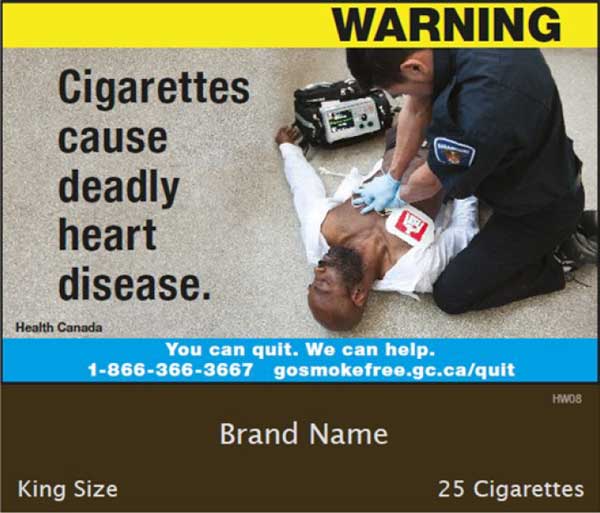
Text Description
A paramedic performing CPR and using a defibrillator on a man who has suffered a heart attack.
The bottom 25% of the package is dark brown.
The text reads:
WARNING
Cigarettes cause deadly heart disease.
You can quit. We can help.
1-866-366-3667
gosmokefree.gc.ca/quit
Health Canada.

Description textuelle
Un ambulancier paramédical pratique la RCR et utilise un défibrillateur sur un homme qui a subi un arrêt cardiaque.
Le quart inférieur du paquet est brun foncé.
Le texte est le suivant :
AVERTISSEMENT
La cigarette cause des maladies cardiaques mortelles.
Vous pouvez arrêter. Nous pouvons vous aider.
1 866 JARRETE (1 866 527-7383)
vivezsansfumee.gc.ca/abandon
Santé Canada
This HW was chosen as the most noticeable by one-quarter (24%) of respondents from the set they were shown for noticeability evaluation.
The image is considered the most eye-catching part of HW-8 (65%) by a three-to-one margin over the text or the warning banner. Most respondents agree that that the text and picture deliver a consistent message (86%) but also that the picture on its own tells them about the health condition (78%). There is agreement (85%) that the colour of the warning banner catches their attention (even if it's not the first thing that does so) and that quitline phone number and web address is easy to read (79%).
Half say "believable" is the statement that best fits their impression of this HW (51%); a strong majority (84%) believe what it says about the health effects of smoking (including half who say it is definitely true). While relatively few respondents select "relevant to me personally" to describe HW, this impression is high for HW-8 (24%). Six in ten respondents (60%) say they don't want to see the picture again and three quarters (76%) say they would remember this HW in a month from now.
% of respondents exposed to this HW (n=607) who chose as most noticeable: 24% (+4%)1
| Number of respondents evaluating this HW | n=274 |
|---|---|
| Q25. What first catches your eye? | Overall |
| Image | 65% |
| Text | 19% |
| Warning banner | 15% |
| Quitline phone number/web address | 1% |
| Q33. Statement(s) that best fit your impression of this HW | Overall |
| Is believable | 51% |
| Leads me to think about quitting | 39% |
| Helps me understand the health conditions caused by smoking | 41% |
| Is relevant to me personally | 24% |
| Makes me interested in reading the text | 20% |
| Has new information | 10% |
| Is hard to understand and/or unclear | 7% |
| None of these fit my impression | 10% |
| Table 52B: Responses for HW-8 (n=274) | ||||
|---|---|---|---|---|
| Q26-Q32. Visual statements | Strongly agree | Somewhat agree | Somewhat disagree | Strongly disagree |
| The colour of the WARNING banner catches my attention | 44% | 41% | 8% | 4% |
| The picture alone tells me about the health condition | 40% | 38% | 13% | 6% |
| The picture and the text work together to relay the message | 39% | 47% | 8% | 4% |
| The quitline phone number and web address is easy to read | 31% | 48% | 14% | 3% |
| The colour contrast between the text and background makes the text easy to read | 38% | 47% | 9% | 2% |
| I would not want to see this picture again | 24% | 36% | 23% | 10% |
| Q35. Believable/credible | Definitely | Probably | Probably not | Definitely not |
| Do you believe what this warning says about the health effects of smoking is true? | 50% | 34% | 10% | 2% |
| Q36. Memorable | Definitely would | Probably would | Probably would not | Definitely would not |
| Would you remember this health warning one month from now? | 31% | 44% | 13% | 7% |
Significant demographic subgroup differences in evaluations of this HW:
- Overall agreement (strongly or somewhat) that the quitline phone number and web address is easy to read is higher among males (84% vs. 71% of females).
- Agreement that the picture and text work together (92% vs. 79%) and that they would not want to see the picture again (70% vs. 50%) is higher among those with a high school diploma or less education than those with a university education.
- Those who plan to quit in the next three months (65%) and those who have tried to quit in the past (45%) are more likely than others to say the warning leads them to think about quitting. These two groups are also more likely to definitely believe the health warning (69% and 56%, respectively).
HW Evaluation: HW-11
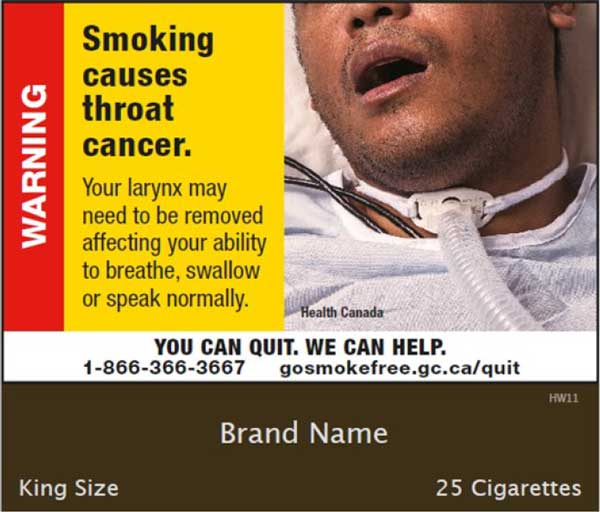
Text Description
Man in a hospital gown with a breathing tube attached to his throat. The bottom 25% of the package is dark brown.
The text reads:
WARNING
Smoking causes throat cancer.
Your larynx may need to be removed affecting your ability to breathe, swallow or speak normally.
You can quit. We can help.
1-866-366-3667
gosmokefree.gc.ca/quit
Health Canada

Description textuelle
Un homme dans un lit d'hôpital avec un tube respiratoire attaché à la gorge.
Le quart inférieur du paquet est brun foncé.
Le texte est le suivant :
AVERTISSEMENT
L'usage du tabac cause le cancer de la gorge.
Vous pourriez éprouver de la difficulté à respirer, avaler at parler normalement si l'on doit enlever votre larynx.
Vous pouvez arrêter. Nous pouvons vous aider.
1 866 JARRETE (1 866 527-7383)
vivezsansfumee.gc.ca/abandon
Santé Canada
This HW was chosen as the most noticeable by around one in five (22%) respondents from the set they were shown to evaluate noticeability.
For HW-11, the image is more than twice as likely as the text to catch the eye first (63%), and well ahead of the warning banner. When asked directly, however, there is strong agreement (82%, with 42% agreeing strongly) that the colour of the warning banner does catch their attention. Most viewers agree that the picture alone (84%) and with the text (80%) conveys the message and that the quitline phone number and web address is easy to read (83%).
More than half (55%) say "believable" is the statement that best fits their impression of this HW; a strong majority (88%) also believe what it says about the health effects of smoking (including half who say it is definitely true). More than six in ten (61%) say they would not want to see the picture again and almost three quarters (74%) say they would remember this HW in a month from now.
% of respondents exposed to this HW (n=613) who chose as most noticeable: 22% (+2%)2
| Number of respondents evaluating this HW | n=254 |
|---|---|
| Q25. What first catches your eye? | Overall |
| Image | 63% |
| Text | 23% |
| Warning banner | 11% |
| Quitline phone number/web address | 4% |
| Q33. Statement(s) that best fit your impression of this HW | Overall |
| Is believable | 55% |
| Leads me to think about quitting | 41% |
| Helps me understand the health conditions caused by smoking | 43% |
| Is relevant to me personally | 20% |
| Makes me interested in reading the text | 27% |
| Has new information | 20% |
| Is hard to understand and/or unclear | 7% |
| None of these fit my impression | 9% |
| Table 53B: Responses for HW-11 (n=254) | ||||
|---|---|---|---|---|
| Q26-Q32. Visual statements | Strongly agree | Somewhat agree | Somewhat disagree | Strongly disagree |
| The colour of the WARNING banner catches my attention | 42% | 40% | 13% | 4% |
| The picture alone tells me about the health condition | 40% | 45% | 10% | 4% |
| The picture and the text work together to relay the message | 42% | 39% | 15% | 3% |
| The quitline phone number and web address is easy to read | 38% | 45% | 14% | 2% |
| The bolding and/or framing of the text draws my attention to the text | 42% | 43% | 10% | 4% |
| The colour contrast between the text and background makes the text easy to read | 40% | 44% | 12% | 3% |
| I would not want to see this picture again | 27% | 34% | 25% | 9% |
| Q35. Believable/credible | Definitely | Probably | Probably not | Definitely not |
| Do you believe what this warning says about the health effects of smoking is true? | 50% | 38% | 7% | 2% |
| Q36. Memorable | Definitely would | Probably would | Probably would not | Definitely would not |
| Would you remember this health warning one month from now? | 37% | 37% | 14% | 7% |
Significant demographic subgroup differences in evaluations of this HW:
- Mentions of the image as the most eye-catching part of HW-11 are higher in French (75%, vs. 60% English); in turn, mentions of the warning banner are higher in English (12% vs. 4% French).
- Strong agreement that the picture and text work together is higher among those with a high school degree or less (57%) than those with a college (33%) or university (34%) education.
- Those who plan to quit in the next three months are more likely than others to say HW-11 is believable (72%), leads them to think about quitting (63%), helps them understand the health conditions caused by smoking (62%), makes them interested in reading the text (45%) and is relevant to them (39%); those planning to quit in the next three months are also more likely than others to say the information about the health effects of smoking is definitely true (71%).
- Daily smokers are more likely to say that HW-11 is relevant to them than occasional smokers (23% vs. 11%).
HW Evaluation: HW-14
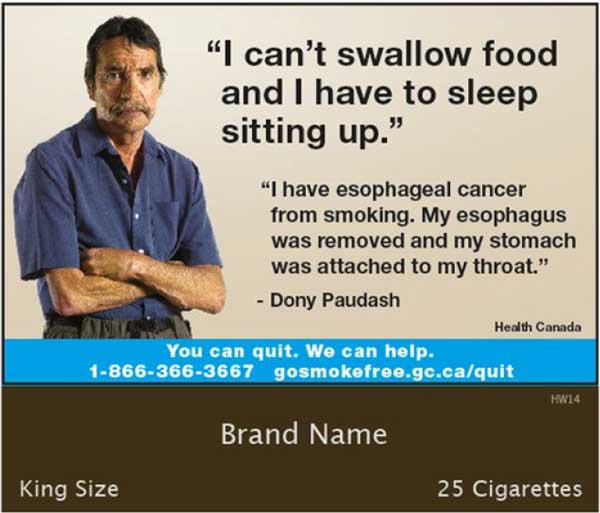
Text Description
An older man standing with arms crossed
The bottom 25% of the package is dark brown.
The text reads:
"I can't swallow food and I have to sleep sitting up"
"I have esophageal cancer from smoking. My esophagus was removed and my stomach was attached to my throat."
- Dony Paudash
You can quit. We can help.
1-866-366-3667
gosmokefree.gc.ca/quit
Health Canada

Description textuelle
Un homme plus âgé qui se tient debout, les bras croisés.
Le quart inférieur du paquet est brun foncé.
Le texte est le suivant :
« Je ne peux plus avaler de nourriture solide et je dois dormir assis. »
« J'ai un cancer de l'œsophage lié au tabagisme. Mon œsophage a été enlevé et mon estomac a été fixé à ma gorge. »
- Dony Paudash
Vous pouvez arrêter. Nous pouvons vous aider.
1 866 JARRETE (1 866 527-7383)
vivezsansfumee.gc.ca/abandon
Santé Canada
This HW was chosen as the most noticeable by just over one in ten (12%) respondents from the set they were shown to evaluate noticeability.
For HW-14, the text is twice as likely as the image to catch the eye first. Three-quarters (76%) agree overall (strongly and somewhat) that the picture and text work together to relay the message, although only one-quarter (25%) strongly agree. There is also overall agreement that the colour contrast between the text and background makes the text easy to read (76%) as is the quitline phone number and web address (72%).
The most common statement selected by respondents about their impression of this HW is "believable" but less than four in ten (39%) chose this impression. While three-quarters (74%) generally believe this is a real person's story about the health effects of smoking, only a quarter (27%) say it definitely is. A majority of respondents (55%) say they don't want to see the picture again and six in ten (62%) say they would remember this HW in a month from now.
% of respondents exposed to this HW (n=603) who chose as most noticeable: 12% (-8%)3
| Number of respondents evaluating this HW | n=198 |
|---|---|
| Q25. What first catches your eye? | Overall |
| Image | 30% |
| Text | 62% |
| Warning banner | 0% |
| Quitline phone number/web address | 8% |
| Q33. Statement(s) that best fit your impression of this HW | Overall |
| Is believable | 39% |
| Leads me to think about quitting | 31% |
| Helps me understand the health conditions caused by smoking | 30% |
| Is relevant to me personally | 12% |
| Makes me interested in reading the text | 16% |
| Has new information | 15% |
| Is hard to understand and/or unclear | 11% |
| None of these fit my impression | 15% |
| Table 54B: Responses for HW-14 (n=198) | ||||
|---|---|---|---|---|
| Q26-Q32. Visual statements | Strongly agree | Somewhat agree | Somewhat disagree | Strongly disagree |
| The picture and the text work together to relay the message | 25% | 51% | 17% | 5% |
| The quitline phone number and web address is easy to read | 27% | 45% | 20% | 6% |
| The colour contrast between the text and background makes the text easy to read | 32% | 44% | 19% | 2% |
| I would not want to see this picture again | 24% | 32% | 33% | 6% |
| Q34. Believable/credible | Definitely | Probably | Probably not | Definitely not |
| Do you believe this is a real person's story about the health effects of smoking? | 27% | 47% | 16% | 4% |
| Q36. Memorable | Definitely would | Probably would | Probably would not | Definitely would not |
| Would you remember this health warning one month from now? | 24% | 38% | 24% | 6% |
Significant demographic subgroup differences in evaluations of this HW:
- The text is considered the most eye-catching part of HW-14 across the board, but mentions are higher in English (66%, vs. 50% French) and among females (77% vs. 52% males); in turn, mentions of the image are higher in French (45% vs. 25% English) and among males (37% vs. 18% females).
- Overall agreement (strongly and somewhat) that the picture and text work together is higher among those aged 45 and older (84% vs. 69% under 45).
- The likelihood to describe their impression of HW-14 as believable is higher among those with a college education (46%, vs. 26% with a high school education) and by those who smoke occasionally (54% vs 32% of daily smokers); those with a university degree are more likely than others to say this is definitely a real person's story (41%, vs. 21% without a university degree).
- Those who plan to quit in the next three months are more likely than others to say HW-14 leads them to think about quitting (59%) and is definitely a real person's story (46%).
HW Evaluation: HW-15
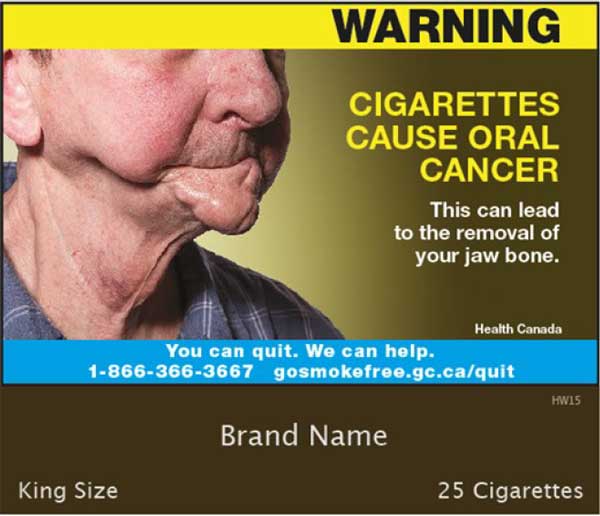
Text Description
An image of a man who had surgery to remove his jawbone.
The bottom 25% of the package is dark brown.
The text reads:
WARNING
CIGARETTES CAUSE ORAL CANCER
This can lead to the removal of your jawbone.
You can quit. We can help.
1-866-366-3667
gosmokefree.gc.ca/quit
Health Canada
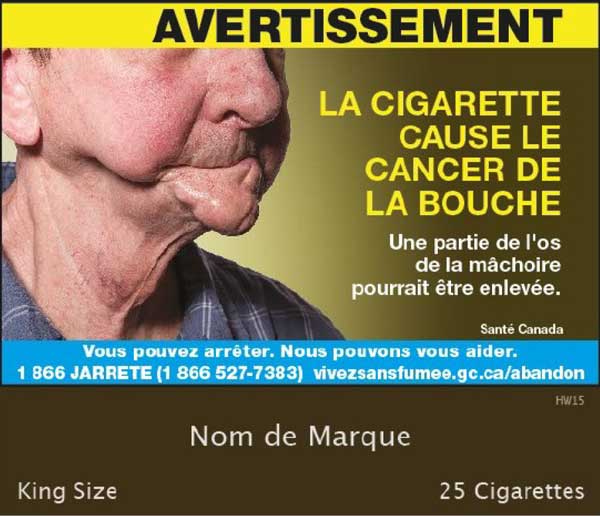
Description textuelle
Une image d'un homme qui a subi une intervention chirurgicale pour retirer son os de la mâchoire.
Le quart inférieur du paquet est brun foncé.
Le texte est le suivant :
AVERTISSEMENT
LA CIGARETTE CAUSE LE CANCER DE LA BOUCHE
Une partie de l'os de la mâchoire pourrait être enlevé.
Vous pouvez arrêter. Nous pouvons vous aider.
1 866 JARRETE (1 866 527-7383)
vivezsansfumee.gc.ca/abandon
Santé Canada
This HW was chosen as the most noticeable by four in ten (41%) respondents from the set they were shown to evaluate noticeability.
The consensus is that the image is the most eye-catching aspect of HW-15, that the picture and text work together particularly effectively to relay the message (91% agree overall, including 54% who strongly agree) and that the colour contrast between the text and background makes the text easy to read (86%). Moreover, a strong majority (82%) say they wouldn't want to see the picture again, that the colour of the warning banner catches their eye (75%) and that the quitline phone number and web address is easy to read (75%).
The key impressions of HW-15 are that it is believable, helps readers understand the health conditions caused by smoking (49% each), and leads them to think about quitting (48%). On a similar note, most (91%) believe what it says about the health effects of smoking (including almost six in ten who say it is definitely true). Three quarters (76%) say they would remember this HW in a month from now.
% of respondents exposed to this HW (n=607) who chose as most noticeable: 41% (+21%)4
| Number of respondents evaluating this HW | n=362 |
|---|---|
| Q25. What first catches your eye? | Overall |
| Image | 90% |
| Text | 5% |
| Warning banner | 2% |
| Quitline phone number/web address | 3% |
| Q33. Statement(s) that best fit your impression of this HW | Overall |
| Is believable | 49% |
| Leads me to think about quitting | 48% |
| Helps me understand the health conditions caused by smoking | 49% |
| Is relevant to me personally | 19% |
| Makes me interested in reading the text | 26% |
| Has new information | 22% |
| Is hard to understand and/or unclear | 8% |
| None of these fit my impression | 6% |
| Table 55B: Responses for HW-15 (n=362) | ||||
|---|---|---|---|---|
| Q26-Q32. Visual statements | Strongly agree | Somewhat agree | Somewhat disagree | Strongly disagree |
| The colour of the WARNING banner catches my attention | 38% | 38% | 19% | 4% |
| The picture alone tells me about the health condition | 48% | 37% | 11% | 3% |
| The picture and the text work together to relay the message | 54% | 37% | 5% | 2% |
| The quitline phone number and web address is easy to read | 31% | 45% | 18% | 5% |
| The colour contrast between the text and background makes the text easy to read | 43% | 44% | 9% | 3% |
| I would not want to see this picture again | 42% | 40% | 10% | 6% |
| Q35. Believable/credible | Definitely | Probably | Probably not | Definitely not |
| Do you believe what this warning says about the health effects of smoking is true? | 58% | 32% | 6% | 1% |
| Q36. Memorable | Definitely would | Probably would | Probably would not | Definitely would not |
| Would you remember this health warning one month from now? | 36% | 40% | 17% | 3% |
Significant demographic subgroup differences in evaluations of this HW:
- Although the image is the most eye-catching element for all groups, French speakers are more likely to say the text first caught their eye (10% vs. 3% for English). Daily smokers are more likely to say that the colour of the warning banner catches their attention (80% vs. 67% of occasional smokers).
- Overall agreement (strongly and somewhat) that the picture alone tells me about the health condition (90% vs. 79%) and that the colour of the warning banner catches their attention (83% vs. 71%) is higher among those with a high school education or less compared to those with a university degree; those with a high school diploma or less are also more likely to say the health effects shown in HW-15 are definitely true (67% vs. 54% with at least some postsecondary education).
- The likelihood to say HW-15 leads them to think about quitting is higher in English (51%, vs. 38% French).
- Those who plan to quit in the next three months are more likely than others to say HW-15 helps them understand the health conditions caused by smoking (71%) and what it says about the health effects of smoking is definitely true (82%).
HW Evaluation: HW-16
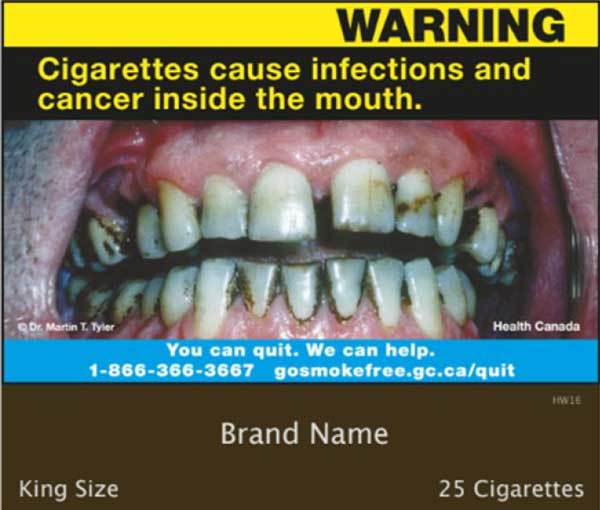
Text Description
An image of a mouth with black discolouration of gums and teeth due to oral disease. © Dr. Martin T. Tyler
The bottom 25% of the package is dark brown.
The text reads:
WARNING
Cigarettes cause infections and cancer inside the mouth.
You can quit. We can help.
1-866-366-3667
gosmokefree.gc.ca/quit
Health Canada
© Dr. Martin T. Tyler
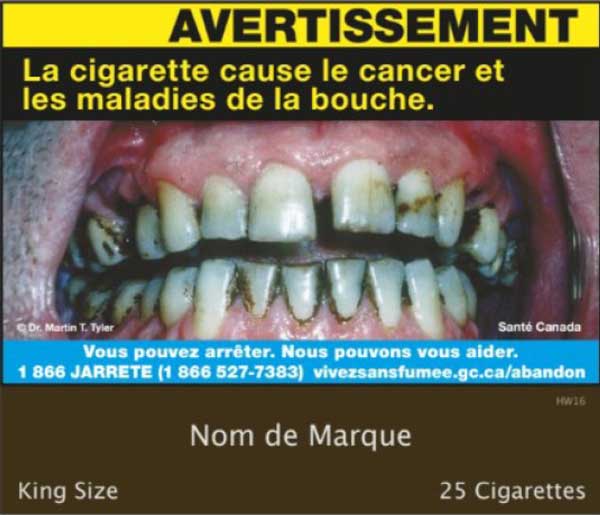
Description textuelle
Une bouche montrant une décoloration noire des gencives et des dents due à une maladie bucco-dentaire. © Dr. Martin T. Tyler
Le quart inférieur du paquet est brun foncé.
Le texte est le suivant :
AVERTISSEMENT
La cigarette cause le cancer et les maladies de la bouche.
Vous pouvez arrêter. Nous pouvons vous aider.
1 866 JARRETE (1 866 527-7383)
vivezsansfumee.gc.ca/abandon
Santé Canada
© Dr. Martin T. Tyler
This HW was chosen as the most noticeable by half (49%) of respondents from the set they were shown to evaluate noticeability.
The consensus is that the image is the most eye-catching aspect of HW-16. Most agree that the picture works alone (86%, with 56% strongly agreeing) and with the text (89%, with 50% strongly agree) to communicate the desired message. Moreover, strong majorities say that the colour of the warning banner catches their attention (82%), that they wouldn't want to see the picture again (78%) and that the quitline phone number and web address is easy to read (77%).
The key impressions of HW-16 are that it is believable (49%) and helps readers understand the health conditions caused by smoking (44%); slightly fewer say it leads them to think about quitting (39%). A strong majority (83%) believe what it says about the health effects of smoking (including half who say it is definitely true) and eight in ten (80%) say they would remember this HW in a month from now.
% of respondents exposed to this HW (n=614) who chose as most noticeable: 50% (+30%)5
| Number of respondents evaluating this HW | n=437 |
|---|---|
| Q25. What first catches your eye? | Overall |
| Image | 92% |
| Text | 3% |
| Warning banner | 2% |
| Quitline phone number/web address | 2% |
| Q33. Statement(s) that best fit your impression of this HW | Overall |
| Is believable | 49% |
| Leads me to think about quitting | 39% |
| Helps me understand the health conditions caused by smoking | 44% |
| Is relevant to me personally | 17% |
| Makes me interested in reading the text | 20% |
| Has new information | 11% |
| Is hard to understand and/or unclear | 4% |
| None of these fit my impression | 14% |
| Table 56B: Responses for HW-16 (n=437) | ||||
|---|---|---|---|---|
| Q26-Q32. Visual statements | Strongly agree | Somewhat agree | Somewhat disagree | Strongly disagree |
| The colour of the WARNING banner catches my attention | 43% | 39% | 11% | 6% |
| The picture alone tells me about the health condition | 56% | 31% | 9% | 2% |
| The picture and the text work together to relay the message | 50% | 39% | 7% | 3% |
| The quitline phone number and web address is easy to read | 35% | 42% | 18% | 4% |
| The colour contrast between the text and background makes the text easy to read | 47% | 37% | 11% | 3% |
| I would not want to see this picture again | 52% | 27% | 12% | 6% |
| Q35. Believable/credible | Definitely | Probably | Probably not | Definitely not |
| Do you believe what this warning says about the health effects of smoking is true? | 51% | 32% | 9% | 2% |
| Q36. Memorable | Definitely would | Probably would | Probably would not | Definitely would not |
| Would you remember this health warning one month from now? | 47% | 33% | 11% | 4% |
Significant demographic subgroup differences in evaluations of this HW:
- A full 100% of people 65 years of age or older said that the image first caught their attention, higher than any other age group.
- Strong agreement that the picture and text work together (52% vs. 41%) and the colour contrast between the text and background makes the text easier to read (50% vs. 36%) is higher in English than in French.
- Overall agreement (strongly or somewhat) that the picture alone tells them about the health condition is higher among females (92%, vs 83% of males).
- The likelihood to say HW-16 makes them interested in reading the text is higher among those 16 to 17 years old (41%), 18-24 year-olds (32%) and 25 to 44 year-olds (25%) than those 45 or older (at 13%).
- Those who plan to quit in the next three months are more likely than others to say HW-16 helps them understand the health conditions caused by smoking (61%) and what it says about the health effects of smoking is definitely true (68%); this segment is also more likely to strongly agree with several statements about the health warning (e.g. warning banner colour catches their attention, the picture and text work together, colour contrast makes text easy to read, would not want to see the picture again).
HW Evaluation: HW-19

Text Description
A child with her mother with their faces blurred out.
The bottom 25% of the package is dark brown.
The text reads:
WARNING
Smoking damages your eyes. You could go permanently blind.
You can quit. We can help.
1-866-366-3667
gosmokefree.gc.ca/quit
Health Canada
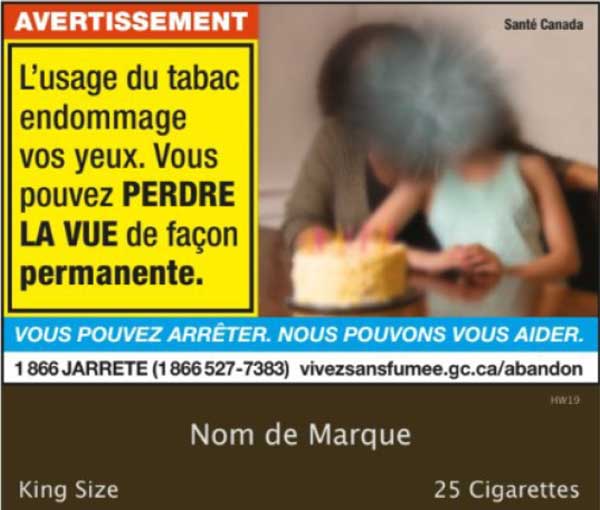
Description textuelle
Un enfant avec sa mère. Leurs visages sont brouillés.
Le quart inférieur du paquet est brun foncé.
Le texte est le suivant :
AVERTISSEMENT
L'usage du tabac endommage vos yeux. Vous pouvez perdre la vue de façon permanente.
Vous pouvez arrêter. Nous pouvons vous aider.
1 866 JARRETE (1 866 527-7383)
vivezsansfumee.gc.ca/abandon
Santé Canada
This HW was chosen as the most noticeable by one in twenty respondents (6%) respondents from the set they were shown to evaluate noticeability.
There are mixed opinions about whether the text (44%) or image (40%) of HW-19 catches the eye first; both are mentioned well ahead of the warning banner (12%), although there is nonetheless overall agreement that the colour of the warning banner catches their attention (82% agree). Three-quarters agree (77%) that the text and picture work together to relay the message, but fewer agree (60%, including only 18% who strongly agree) that the picture alone tells them about the health condition. Although four in five (81%) agree that the quitline and web address is easy to read, only 4% noted it as that element of the HW that first catches their eye.
The key impressions of HW-19 are that it helps readers understand the health conditions caused by smoking (39%) and is believable (34%), but neither score is very high. While four in five (81%) generally believe what it says about the health effects of smoking, only a quarter (26%) say it is definitely true. Three in five (63%) say they don't want to see the picture again and three quarters (73%) say they would remember this HW in a month from now.
% of respondents exposed to this HW (n=612) who chose as most noticeable: 6% (-14%)6
| Number of respondents evaluating this HW | n=158 |
|---|---|
| Q25. What first catches your eye? | Overall |
| Image | 40% |
| Text | 44% |
| Warning banner | 12% |
| Quitline phone number/web address | 4% |
| Q33. Statement(s) that best fit your impression of this HW | Overall |
| Is believable | 34% |
| Leads me to think about quitting | 28% |
| Helps me understand the health conditions caused by smoking | 39% |
| Is relevant to me personally | 16% |
| Makes me interested in reading the text | 21% |
| Has new information | 28% |
| Is hard to understand and/or unclear | 10% |
| None of these fit my impression | 13% |
| Table 57B: Responses for HW-19 (n=158) | ||||
|---|---|---|---|---|
| Q26-Q32. Visual statements | Strongly agree | Somewhat agree | Somewhat disagree | Strongly disagree |
| The colour of the WARNING banner catches my attention | 35% | 48% | 15% | 3% |
| The picture alone tells me about the health condition | 18% | 43% | 26% | 13% |
| The picture and the text work together to relay the message | 32% | 45% | 19% | 4% |
| The quitline phone number and web address is easy to read | 33% | 47% | 16% | 3% |
| The bolding and/or framing of the text draws my attention to the text | 34% | 45% | 16% | 4% |
| The colour contrast between the text and background makes the text easy to read | 36% | 48% | 13% | 3% |
| I would not want to see this picture again | 21% | 42% | 25% | 5% |
| Q35. Believable/credible | Definitely | Probably | Probably not | Definitely not |
| Do you believe what this warning says about the health effects of smoking is true? | 26% | 56% | 13% | 3% |
| Q36. Memorable | Definitely would | Probably would | Probably would not | Definitely would not |
| Would you remember this health warning one month from now? | 24% | 49% | 19% | 4% |
Significant demographic subgroup differences in evaluations of this HW:
- Those with a high school diploma or less education are more likely than others to strongly agree with several statements about HW-19 (e.g., warning banner colour catches their attention, quitline phone number and web address is easy to read, bolding/framing draws attention to text).
- The likelihood to say HW-19 is relevant to them personally is higher among females (25%, vs. 9% of males).
HW Evaluation: HW-20

Text Description
An infected foot from circulation loss. © Dr. Hande Akdeniz
The bottom 25% of the package is dark brown.
The text reads:
WARNING
Cigarettes damage your blood vessels.
This can lead to a loss of circulation, causing body tissue to decay and die.
You can quit. We can help.
1-866-366-3667
gosmokefree.gc.ca/quit
Health Canada
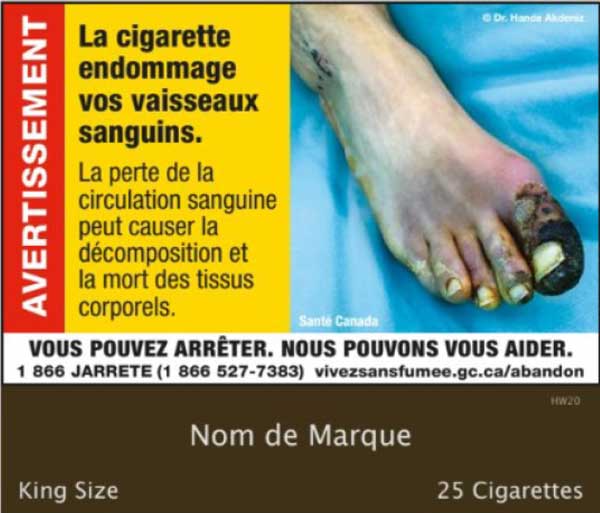
Description textuelle
Un pied atteint d'une perte de la circulation. © Dr. Hande Akdeniz
Le quart inférieur du paquet est brun foncé.
Le texte est le suivant :
AVERTISSEMENT
La cigarette endommage vos vaisseaux sanguins.
La perte de la circulation sanguine peut causer la décomposition et la mort des tissus corporels.
Vous pouvez arrêter. Nous pouvons vous aider.
1 866 JARRETE (1 866 527-7383)
vivezsansfumee.gc.ca/abandon
Santé Canada
This HW was chosen as the most noticeable by one-quarter (26%) of respondents from the set they were shown to evaluate noticeability.
The consensus is that the image is the most eye-catching aspect of HW-20. Most agree that the picture works alone (82%, with 51% strongly agree) and especially with the text (88%, with 48% strongly agree) to communicate the desired message. Moreover, a strong majority (83%) say they wouldn't want to see the picture again, that the quitline phone number and web address is easy to read (83%) and that the colour of the warning banner catches their attention (82%).
The key impressions of HW-20 are that it helps readers understand the health conditions caused by smoking (42%) is believable (39%) and; slightly fewer say it leads them to think about quitting (33%). A strong majority (82%) believe what it says about the health effects of smoking (including close to half who say it is definitely true). More than three quarters (79%) evaluating the HW say they would remember this HW in a month from now.
% of respondents exposed to this HW (n=611) who chose as most noticeable: 26% (+6%)7
| Number of respondents evaluating this HW | n=265 |
|---|---|
| Q25. What first catches your eye? | Overall |
| Image | 87% |
| Text | 7% |
| Warning banner | 5% |
| Quitline phone number/web address | 2% |
| Q33. Statement(s) that best fit your impression of this HW | Overall |
| Is believable | 39% |
| Leads me to think about quitting | 33% |
| Helps me understand the health conditions caused by smoking | 42% |
| Is relevant to me personally | 12% |
| Makes me interested in reading the text | 23% |
| Has new information | 22% |
| Is hard to understand and/or unclear | 7% |
| None of these fit my impression | 12% |
| Table 58B: Responses for HW-20 (n=265) | ||||
|---|---|---|---|---|
| Q26-Q32. Visual statements | Strongly agree | Somewhat agree | Somewhat disagree | Strongly disagree |
| The colour of the WARNING banner catches my attention | 41% | 42% | 10% | 5% |
| The picture alone tells me about the health condition | 51% | 30% | 9% | 7% |
| The picture and the text work together to relay the message | 48% | 39% | 5% | 6% |
| The quitline phone number and web address is easy to read | 39% | 44% | 11% | 4% |
| The bolding and/or framing of the text draws my attention to the text | 33% | 45% | 15% | 5% |
| The colour contrast between the text and background makes the text easy to read | 47% | 40% | 8% | 4% |
| I would not want to see this picture again | 51% | 32% | 12% | 3% |
| Q35. Believable/credible | Definitely | Probably | Probably not | Definitely not |
| Do you believe what this warning says about the health effects of smoking is true? | 45% | 37% | 8% | 5% |
| Q36. Memorable | Definitely would | Probably would | Probably would not | Definitely would not |
| Would you remember this health warning one month from now? | 41% | 37% | 15% | 4% |
Significant demographic subgroup differences in evaluations of this HW:
- The image is considered the most eye-catching part of HW-20 across the board, but particularly in French (95%, vs. 84% English). The likelihood to say HW-20 is relevant to them personally is also higher in French (21%, vs. 10% English). Strong agreement that the quitline phone number and web address is easy to read is higher for the English version (44%, vs. 21% French).
- Overall agreement (strongly and somewhat) with several statements about HW-20 are higher among those with a high school diploma or less (e.g., warning banner colour catches their attention, the picture works alone and with the text to relay the message, the quitline phone number and web address is easy to read, the bolding/framing draw attention to the text).
- Those who plan to quit within six months are more likely than others to say HW-20 leads them to think about quitting (49%). Those who plan to quit in the next three months are more likely than others to believe what the health warning says about the health effects of smoking is definitely true (67%); this segment is also more likely to strongly agree with several statements about the health warning (e.g. warning banner colour catches their attention, the picture works alone and with the text to relay the message, colour contrast makes text easy to read, would not want to see the picture again).
HW Evaluation: HW-22
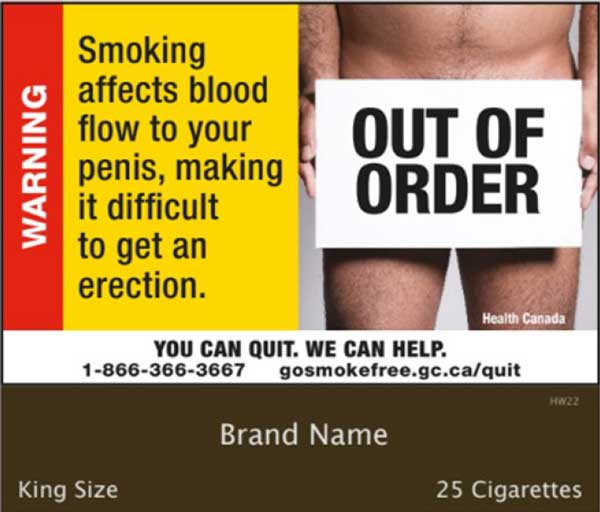
Text Description
A nude man holding an 'out of order' sign in front of his torso.
The bottom 25% of the package is dark brown.
The text reads:
WARNING
OUT OF ORDER
Smoking affects blood flow to your penis, making it difficult to get an erection.
You can quit. We can help.
1-866-366-3667
gosmokefree.gc.ca/quit
Health Canada

Description textuelle
Un homme nu qui tient un panneau « Hors d'usage » devant ses organes génitaux.
Le quart inférieur du paquet est brun foncé.
Le texte est le suivant :
AVERTISSEMENT
HORS D'USAGE
L'usage du tabac diminue la circulation sanguine vers le pénis, limitant votre capacité à avoir une érection.
Vous pouvez arrêter. Nous pouvons vous aider.
1 866 JARRETE (1 866 527-7383)
vivezsansfumee.gc.ca/abandon
Santé Canada
This HW was chosen as the most noticeable by one in six (17%) respondents from the set they were shown to evaluate noticeability.
For HW-22, the image is more than twice as likely as the text to catch the eye first (64% to 25%), and well ahead of the warning banner (10%) although there is strong agreement that the colour of the warning banner catches their attention (78% agree). Most viewers agree that the picture alone (77%) and especially with the text (86%) conveys the message and that the quitline phone number and web address is easy to read (79%).
The key impressions of HW-22 are that it is believable (43%) and helps readers understand the health conditions caused by smoking (38%); only about half as many say it leads them to think about quitting (21%). A strong majority (79%) believe what it says about the health effects of smoking (including one in three who say it is definitely true). Around six in ten (59%) say they wouldn't want to see the picture again and three quarters (75%) say they would remember this HW in a month from now.
% of respondents exposed to this HW (n=608) who chose as most noticeable: 17% (-3%)8
| Number of respondents evaluating this HW | n=231 |
|---|---|
| Q25. What first catches your eye? | Overall |
| Image | 64% |
| Text | 25% |
| Warning banner | 10% |
| Quitline phone number/web address | 1% |
| Q33. Statement(s) that best fit your impression of this HW | Overall |
| Is believable | 43% |
| Leads me to think about quitting | 21% |
| Helps me understand the health conditions caused by smoking | 38% |
| Is relevant to me personally | 18% |
| Makes me interested in reading the text | 29% |
| Has new information | 20% |
| Is hard to understand and/or unclear | 7% |
| None of these fit my impression | 15% |
| Table 59B: Responses for HW-22 (n=231) | ||||
|---|---|---|---|---|
| Q26-Q32. Visual statements | Strongly agree | Somewhat agree | Somewhat disagree | Strongly disagree |
| The colour of the WARNING banner catches my attention | 39% | 38% | 18% | 4% |
| The picture alone tells me about the health condition | 36% | 41% | 17% | 5% |
| The picture and the text work together to relay the message | 42% | 43% | 10% | 1% |
| The quitline phone number and web address is easy to read | 36% | 43% | 15% | 4% |
| The colour contrast between the text and background makes the text easy to read | 42% | 46% | 8% | 3% |
| I would not want to see this picture again | 29% | 30% | 23% | 11% |
| Q35. Believable/credible | Definitely | Probably | Probably not | Definitely not |
| Do you believe what this warning says about the health effects of smoking is true? | 34% | 45% | 10% | 3% |
| Q36. Memorable | Definitely would | Probably would | Probably would not | Definitely would not |
| Would you remember this health warning one month from now? | 29% | 45% | 13% | 6% |
Significant demographic subgroup differences in evaluations of this HW:
- The image is considered the most eye-catching part of HW-22 across the board, but particularly in French (76%, vs. 61% English). In turn, the text is more noticeable in English (28%, vs. 14% French), as is overall agreement (strongly or somewhat) that they do not want to see this picture again (65%, vs. 37% French). French respondents are also more likely than English respondents to believe what the health warning says about the health effects of smoking (89% and 76%, respectively).
- Those with a university degree are more likely to say the image first caught their eye (78%), those with a college education are more likely to say the text first caught their eye and those with a high school education or less are more to say the warning banner (16%).
- The likelihood to say HW-22 is relevant to them personally (27% vs. 8%) and leads them to think about quitting (30% vs. 10%) is higher among males than females.
- Daily smokers are more likely to agree that they would not want to see this image again that occasional smokers (65% vs. 43%).
- Those who plan to quit within three months are more likely than others to strongly agree with several statements about the health warning (e.g. the picture works alone and with the text to relay the message, colour contrast makes text easy to read).
HW Evaluation: HW-23
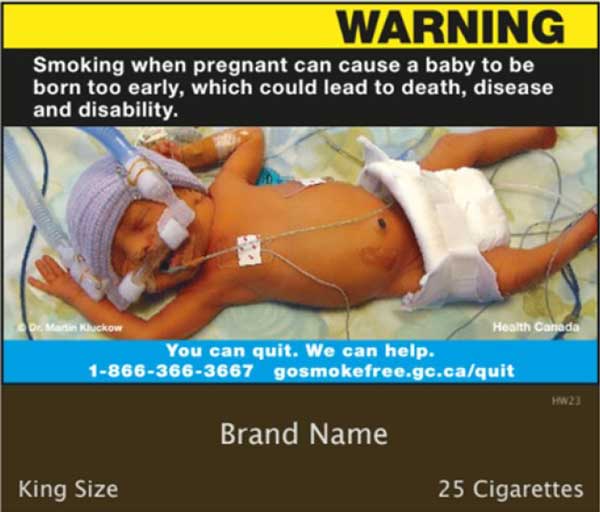
Text Description
A newborn in the hospital in with many tubes attached to the body and mouth. © Dr. Martin Kluckow
The bottom 25% of the package is dark brown.
The text reads:
WARNING
Smoking when pregnant can cause a baby to be born too early, which could lead to death, disease and disability.
You can quit. We can help.
1-866-366-3667
gosmokefree.gc.ca/quit
Health Canada
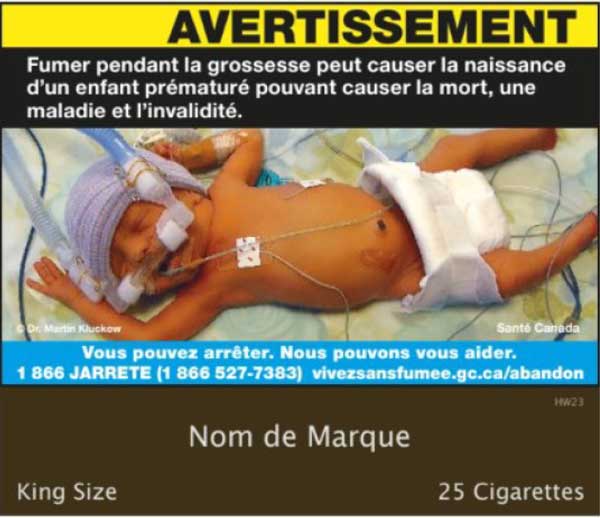
Description textuelle
Un nouveau-né à l'hôpital avec de nombreux tubes fixés au corps et à la bouche. © Dr. Martin Kluckow
Le quart inférieur du paquet est brun foncé.
Le texte est le suivant :
AVERTISSEMENT
Fumer pendant la grossesse peut causer la naissance d'un enfant prématuré peuvent causer la mort, une maladie et l'invalidité.
Vous pouvez arrêter. Nous pouvons vous aider.
1 866 JARRETE (1 866 527-7383)
vivezsansfumee.gc.ca/abandon
Santé Canada
This HW was chosen as the most noticeable by one-quarter (26%) of respondents from the set they were shown to evaluate noticeability.
The consensus is that the image is the most eye-catching aspect of HW-23 (87%). There is also strong agreement (84%) that the colour of the warning banner catches their attention (even if it's not the first thing that does so). Most agree that the picture works alone (80%) and with the text (86%) to communicate the desired message. More than three quarters agree that the quitline phone number and web address is easy to read (78%).
More than half (53%) say the statement that best fits their impression of this HW is "believable"; a strong majority (89%) also believe what it says about the health effects of smoking (including half who say it is definitely true). The HW is also memorable with eight in ten (81%) saying they would remember this HW in a month from now and three-quarters say they wouldn't want to see the picture again.
% of respondents exposed to this HW (n=607) who chose as most noticeable: 26% (+6%)9
| Number of respondents evaluating this HW | n=300 |
|---|---|
| Q25. What first catches your eye? | Overall |
| Image | 87% |
| Text | 8% |
| Warning banner | 3% |
| Quitline phone number/web address | 3% |
| Q33. Statement(s) that best fit your impression of this HW | Overall |
| Is believable | 53% |
| Leads me to think about quitting | 35% |
| Helps me understand the health conditions caused by smoking | 36% |
| Is relevant to me personally | 19% |
| Makes me interested in reading the text | 24% |
| Has new information | 13% |
| Is hard to understand and/or unclear | 5% |
| None of these fit my impression | 13% |
| Table 60B: Responses for HW-23 (n=300) | ||||
|---|---|---|---|---|
| Q26-Q32. Visual statements | Strongly agree | Somewhat agree | Somewhat disagree | Strongly disagree |
| The colour of the WARNING banner catches my attention | 41% | 43% | 9% | 5% |
| The picture alone tells me about the health condition | 42% | 38% | 13% | 6% |
| The picture and the text work together to relay the message | 42% | 44% | 10% | 1% |
| The quitline phone number and web address is easy to read | 31% | 47% | 14% | 6% |
| The colour contrast between the text and background makes the text easy to read | 41% | 45% | 9% | 3% |
| I would not want to see this picture again | 38% | 37% | 12% | 8% |
| Q35. Believable/credible | Definitely | Probably | Probably not | Definitely not |
| Do you believe what this warning says about the health effects of smoking is true? | 50% | 38% | 7% | 0% |
| Q36. Memorable | Definitely would | Probably would | Probably would not | Definitely would not |
| Would you remember this health warning one month from now? | 38% | 42% | 12% | 2% |
Significant demographic subgroup differences in evaluations of this HW:
- Overall agreement (strongly or somewhat) that the picture alone tells them about the health condition is higher in French (87%, vs. 77% English).
- The likelihood to say HW-23 makes them interested in reading the text is also higher in French (34%, vs. 20% English) as well as among females (31%, vs. 17% males).
- The proportion who describe HW-23 as believable (72%), say it helps them understand the health conditions caused by smoking (54%) and is relevant to them personally (32%) is higher among those who plan to quit in the next three months. This segment is also more likely to believe the health warning is definitely true (74%) and to strongly agree with several statements about it (e.g. the warning banner colour catches their attention, the picture works alone and with the text to relay the message, colour contrast makes text easy to read).
HW Evaluation: HW-24
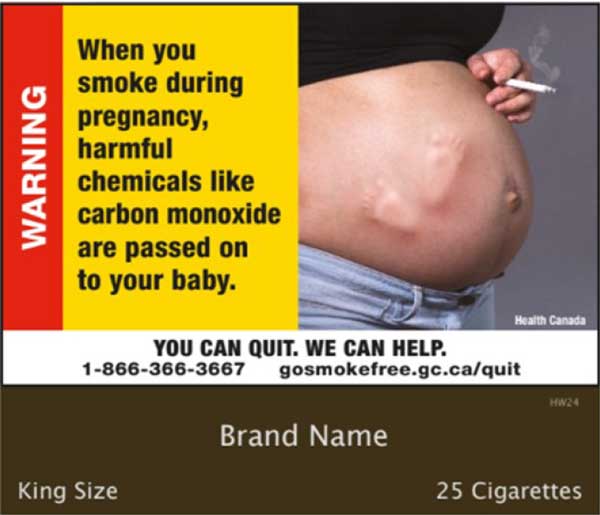
Text Description
The bottom 25% of the package is dark brown.
The text reads:
WARNING
When you smoke during pregnancy, harmful chemicals like carbon monoxide are passed on to your baby.
You can quit. We can help.
1-866-366-3667
gosmokefree.gc.ca/quit
Health Canada
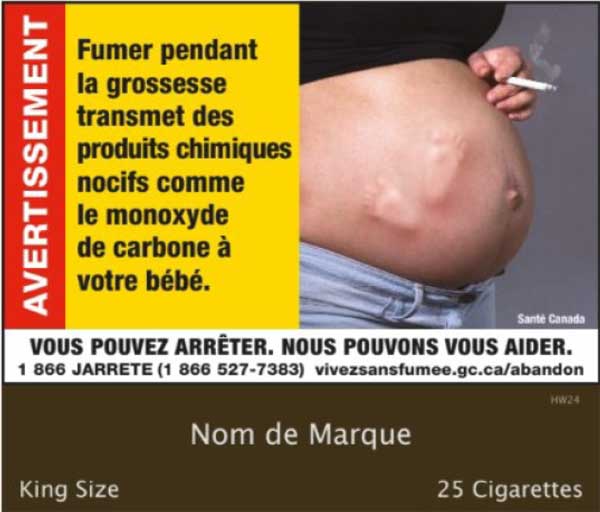
Description textuelle
Une femme enceinte fumant une cigarette alors que son fœtus pousse contre son estomac avec ses pieds.
Le quart inférieur du paquet est brun foncé.
Le texte est le suivant :
AVERTISSEMENT
Fumer pendant la grossesse transmet des produits chimiques nocifs comme le monoxyde de carbone à votre bébé.
Vous pouvez arrêter. Nous pouvons vous aider.
1 866 JARRETE (1 866 527-7383)
vivezsansfumee.gc.ca/abandon
Santé Canada
This HW was chosen as the most noticeable by one-quarter (25%) of respondents from the set they were shown to evaluate noticeability.
The consensus is that the image is the most eye-catching aspect of HW-24 (82%), that the picture and text work together particularly effectively to relay the message (90% agree overall, including half who strongly agree) and that the colour contrast between the text and background makes the text easy to read (91%). There was also agreement that the colour of the warning banner catches their attention (86%), that the picture alone tells them about the health condition (83%) and that the quitline phone number and web address is easy to read (83%).
More than half (53%) say the statement that best fits their impression of this HW is "believable"; a strong majority (90%) also believe what the HW says about the health effects of smoking (including more than half who say it is definitely true). The proportion agreeing it is "relevant to me personally" to describe this HW is only 8%. Two thirds of respondents (68%) say they don't want to see the picture again while more than three quarters (76%) say they would remember this HW in a month from now.
% of respondents exposed to this HW (n=616) who chose as most noticeable: 25% (+5%)10
| Number of respondents evaluating this HW | n=274 |
|---|---|
| Q25. What first catches your eye? | Overall |
| Image | 82% |
| Text | 11% |
| Warning banner | 6% |
| Quitline phone number/web address | 1% |
| Q33. Statement(s) that best fit your impression of this HW | Overall |
| Is believable | 53% |
| Leads me to think about quitting | 26% |
| Helps me understand the health conditions caused by smoking | 38% |
| Is relevant to me personally | 8% |
| Makes me interested in reading the text | 27% |
| Has new information | 12% |
| Is hard to understand and/or unclear | 5% |
| None of these fit my impression | 16% |
| Table 61B: Responses for HW-24 (n=274) | ||||
|---|---|---|---|---|
| Q26-Q32. Visual statements | Strongly agree | Somewhat agree | Somewhat disagree | Strongly disagree |
| The colour of the WARNING banner catches my attention | 46% | 41% | 10% | 2% |
| The picture alone tells me about the health condition | 41% | 42% | 12% | 3% |
| The picture and the text work together to relay the message | 52% | 38% | 5% | 1% |
| The quitline phone number and web address is easy to read | 38% | 45% | 11% | 3% |
| The colour contrast between the text and background makes the text easy to read | 47% | 44% | 5% | 2% |
| I would not want to see this picture again | 31% | 37% | 19% | 7% |
| Q35. Believable/credible | Definitely | Probably | Probably not | Definitely not |
| Do you believe what this warning says about the health effects of smoking is true? | 55% | 35% | 4% | 0% |
| Q36. Memorable | Definitely would | Probably would | Probably would not | Definitely would not |
| Would you remember this health warning one month from now? | 42% | 35% | 10% | 7% |
Significant demographic subgroup differences in evaluations of this HW:
- Occasional smokers are more likely to say the image first caught their eye (90% vs. 78% of daily smokers).
- Strong agreement that the quitline phone number and web address is easy to read (41% vs. 27%), the colour contrast makes the text easy to read (49% vs. 34%), and they would not want to see this picture again (33% vs. 20%) is higher in English than French.
- The proportion saying HW-24 has new information is higher among individuals under 45 (20%, vs. 4% aged 45 and older). Perceived relevance is similarly low among females (6%) and males (9%).
- Those who plan to quit within three months are more likely than others to say HW-24 leads them to think about quitting (42%) and to strongly agree that the picture works alone and with the text to relay the message (69%).
HW Evaluation: HW-25
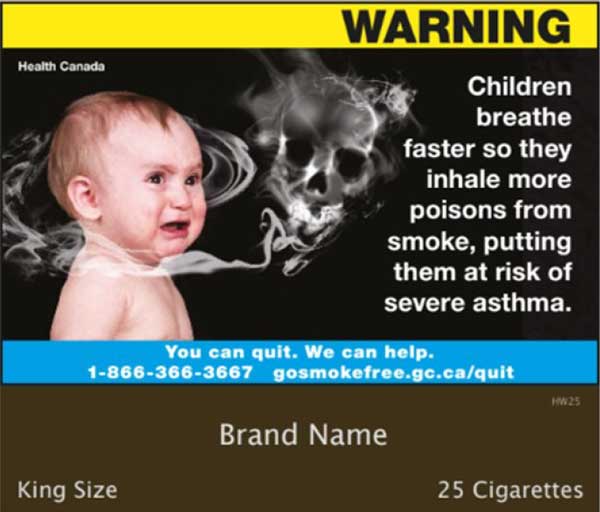
Text Description
A crying baby is surrounded by a cloud of smoke. The smoke forms the shape of a skull.
The bottom 25% of the package is dark brown.
The text reads:
WARNING
Children breathe faster so they inhale more poisons from smoke, putting them at risk of severe asthma.
You can quit. We can help.
1-866-366-3667
gosmokefree.gc.ca/quit
Health Canada
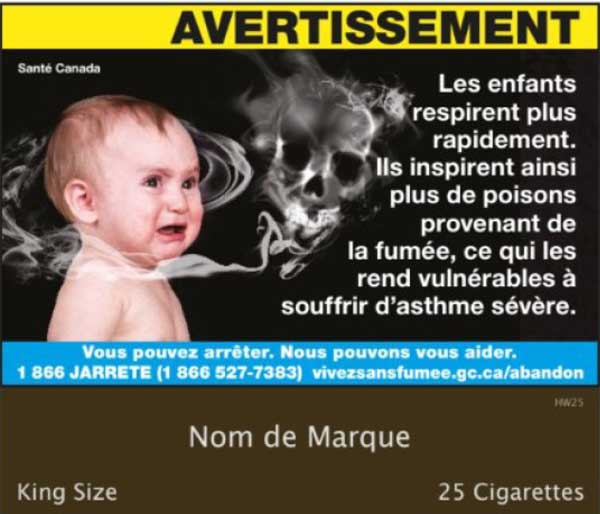
Description textuelle
Un bébé en pleurs est entouré d'un nuage de fumée. La fumée a la forme d'un crâne.
Le quart inférieur du paquet est brun foncé.
Le texte est le suivant :
AVERTISSEMENT
Les enfants respirent plus rapidement. Ils inspirent ainsi plus de poisons provenant de la fumée, ce qui les rend vulnérables à souffrir d'asthme sévère.
Vous pouvez arrêter. Nous pouvons vous aider.
1 866 JARRETE (1 866 527-7383)
vivezsansfumee.gc.ca/abandon
Santé Canada
This HW was chosen as the most noticeable by three in ten (29%) respondents from the set they were shown to evaluate noticeability.
The consensus is that the image is the most eye-catching aspect of HW-25 (87%), and that the picture and text work together particularly effectively to relay the message (93% agree overall, including six in ten who strongly agree). The proportions who say the HW makes them interested in reading the text (32%) and who agree (91%) the colour contrast between the text and background makes it easy to read, are both high. At least four in five also agree (strongly or somewhat) that the colour of the warning banner catches their attention (85%), that the picture alone tells them about the health condition (82%) and that the quitline phone number and web address is easy to read (80%).
More than half (52%) say the statement that best fits their impression of this HW is "believable"; a strong majority (91%) also believe what it says about the health effects of smoking (including more than half who say it is definitely true). Three quarters (75%) of respondents say they don't want to see the picture again and an even higher proportion (83%) say they would remember this HW in a month from now.
% of respondents exposed to this HW (n=618) who chose as most noticeable: 29% (+9%)11
| Number of respondents evaluating this HW | n=303 |
|---|---|
| Q25. What first catches your eye? | Overall |
| Image | 87% |
| Text | 7% |
| Warning banner | 4% |
| Quitline phone number/web address | 3% |
| Q33. Statement(s) that best fit your impression of this HW | Overall |
| Is believable | 52% |
| Leads me to think about quitting | 37% |
| Helps me understand the health conditions caused by smoking | 39% |
| Is relevant to me personally | 20% |
| Makes me interested in reading the text | 32% |
| Has new information | 19% |
| Is hard to understand and/or unclear | 2% |
| None of these fit my impression | 12% |
| Table 62B: Responses for HW-25 (n=303) | ||||
|---|---|---|---|---|
| Q26-Q32. Visual statements | Strongly agree | Somewhat agree | Somewhat disagree | Strongly disagree |
| The colour of the WARNING banner catches my attention | 42% | 42% | 12% | 3% |
| The picture alone tells me about the health condition | 49% | 33% | 14% | 3% |
| The picture and the text work together to relay the message | 59% | 35% | 5% | 1% |
| The quitline phone number and web address is easy to read | 30% | 50% | 15% | 4% |
| The colour contrast between the text and background makes the text easy to read | 50% | 40% | 6% | 3% |
| I would not want to see this picture again | 36% | 39% | 10% | 9% |
| Q35. Believable/credible | Definitely | Probably | Probably not | Definitely not |
| Do you believe what this warning says about the health effects of smoking is true? | 56% | 35% | 4% | 1% |
| Q36. Memorable | Definitely would | Probably would | Probably would not | Definitely would not |
| Would you remember this health warning one month from now? | 41% | 42% | 8% | 4% |
Significant demographic subgroup differences in evaluations of this HW:
- Strong agreement that the picture and text work together to relay the message (63% vs. 44%) and the colour contrast makes the text easy to read (56% vs. 30%) is higher in English than French. English respondents are also more likely to say HW-25 helps them understand the health conditions caused by smoking (42%, vs. 29% French).
- The proportion saying HW-25 is relevant to them personally is higher among individuals under 45 (32%, vs. 8% aged 45 and older).
- Those who plan to quit within three months are more likely than others to say HW-25 leads them to think about quitting (54%) and to believe this health warning is definitely true (77%).
HW Evaluation: HW-30
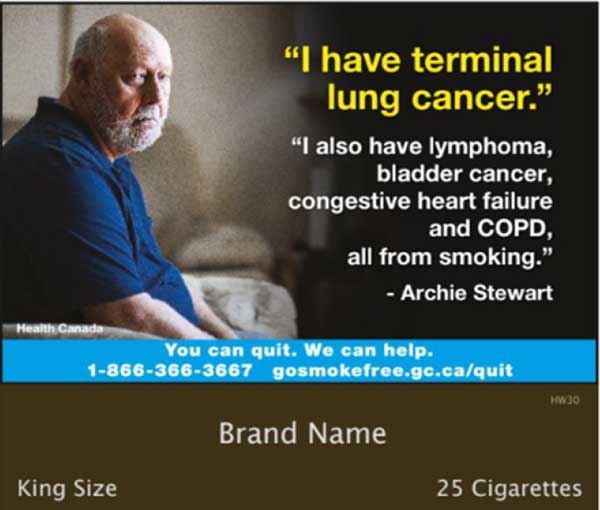
Text Description
A sad man sitting on a bed.
The bottom 25% of the package is dark brown.
The text reads:
"I have terminal lung cancer."
"I also have lymphoma bladder cancer, congestive heart failure and COPD, all from smoking"
- Archie Stewart
You can quit. We can help.
1-866-366-3667
gosmokefree.gc.ca/quit
Health Canada
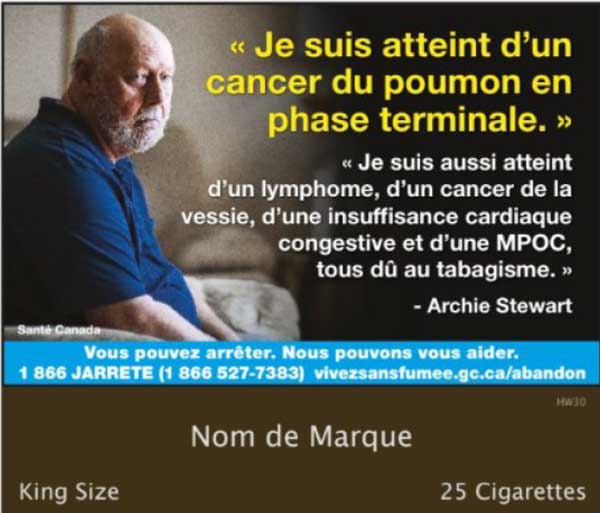
Description textuelle
Un homme triste assis sur un lit.
Le quart inférieur du paquet est brun foncé.
Le texte est le suivant :
« Je suis atteint d'un cancer du poumon en phase terminale. »
« Je suis aussi atteint d'un lymphome, d'un cancer de la vessie, d'une insuffisance cardiaque congestive et d'une MPOC, tous dû au tabagisme »
- Archie Stewart
Vous pouvez arrêter. Nous pouvons vous aider.
1 866 JARRETE (1 866 527-7383)
vivezsansfumee.gc.ca/abandon
Santé Canada
This HW was chosen as the most noticeable by one in ten (10%) respondents from the set they were shown to evaluate noticeability.
For HW-30, the text is almost twice as likely as the image to catch the eye first (65% vs. 34%). More than eight in ten agree overall (82% strongly and somewhat) that the picture and text work together to relay the message. There is also overall agreement that the colour contrast between the text and background makes the text easy to read (88%) and that the quitline phone number and web address is easy to read (78%).
The statement that best fits respondents' impression of this HW is "believable" (54%), while sizeable portions of respondents say it leads them to think about quitting (46%) and helps me understand the health conditions caused by smoking (44%). A strong majority (85%) believes that it is a real person's story (including 37 percent who say it is definitely is). Six in ten (61%) say they don't want to see the picture again and seven in ten (70%) say they would remember this HW in a month from now.
% of respondents exposed to this HW (n=612) who chose as most noticeable: 10% (-10%)12
| Number of respondents evaluating this HW | n=190 |
|---|---|
| Q25. What first catches your eye? | Overall |
| Image | 34% |
| Text | 65% |
| Warning banner | 0% |
| Quitline phone number/web address | 1% |
| Q33. Statement(s) that best fit your impression of this HW | Overall |
| Is believable | 54% |
| Leads me to think about quitting | 46% |
| Helps me understand the health conditions caused by smoking | 44% |
| Is relevant to me personally | 25% |
| Makes me interested in reading the text | 25% |
| Has new information | 14% |
| Is hard to understand and/or unclear | 3% |
| None of these fit my impression | 11% |
| Table 63B: Responses for HW-30 (n=190) | ||||
|---|---|---|---|---|
| Q26-Q32. Visual statements | Strongly agree | Somewhat agree | Somewhat disagree | Strongly disagree |
| The picture and the text work together to relay the message | 38% | 45% | 14% | 3% |
| The quitline phone number and web address is easy to read | 35% | 42% | 19% | 2% |
| The colour contrast between the text and background makes the text easy to read | 46% | 42% | 7% | 4% |
| I would not want to see this picture again | 22% | 39% | 28% | 10% |
| Q34. Believable/credible | Definitely | Probably | Probably not | Definitely not |
| Do you believe this is a real person's story about the health effects of smoking? | 37% | 48% | 8% | 2% |
| Q36. Memorable | Definitely would | Probably would | Probably would not | Definitely would not |
| Would you remember this health warning one month from now? | 26% | 44% | 20% | 6% |
Significant demographic subgroup differences in evaluations of this HW:
- The proportion saying HW-30 helps them understand the health conditions caused by smoking is higher among those with a high school diploma or less (60%, vs. 38% with at least some postsecondary education). The same is true of people 45 years of age or older when compared to those under 45 (58% vs. 31%).
- Those aged 45 or older are more likely to agree that the colour contrast between the text and the background makes the text easy to read (97% vs. 79% of those under 45 years of age) and that the picture and text work together to relay the message (96% vs. 68% of those under 45).
- Those who plan to quit within three months are more likely than others to say HW-30 leads them to think about quitting (75%).
HW Evaluation: HW-40

Text Description
A distressed, teenage girl is surrounded by dirty water filled with cigarette butts. The bottom 25% of the package is dark brown.
The text reads:
WARNING
Smoking puts your health at risk.
this means hundreds of toxic chemicals harm every organ in your body.
The bottom 25% of the package is dark brown
You can quit. We can help.
1-866-366-3667
gosmokefree.gc.ca/quit
Health Canada
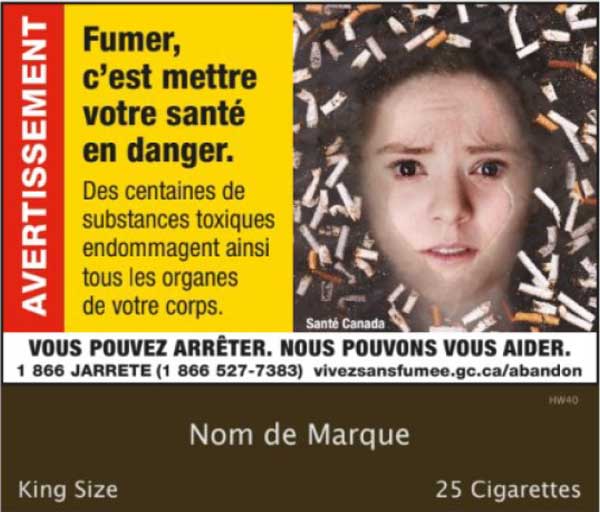
Description textuelle
Une adolescente en détresse est entourée d'eau souillée remplie de mégots de cigarettes.
Le quart inférieur du paquet est brun foncé.
Le texte est le suivant :
AVERTISSEMENT
Fumer, c'est mettre votre santé en danger.
Des centaines de substances toxiques endommagent ainsi tous les organes de votre corps.
Vous pouvez arrêter. Nous pouvons vous aider.
1 866 JARRETE (1 866 527-7383)
vivezsansfumee.gc.ca/abandon
Santé Canada
This HW was chosen as the most noticeable by one in ten (11%) respondents from the set they were shown to evaluate noticeability
The image is considered the most eye-catching part of HW-40 by a three-to-one margin over the text (68% v. 22%). The proportion who agree that the picture alone tells people about the health condition is low at 58% (with only 22% strongly agreeing) while almost three quarters (73%) say the image and text work together to relay the message. Most agree that the colour contrast between the text and background makes the text easy to read (88%), the quitline phone number and web address is easy to read (82%), the colour of the warning banner catches their attention (81%) and that the bolding and/or framing of the text draws their attention to the text (77%).
The top impression of HW-40 is that it is believable (34%) and three in ten (29%) say it makes them interested in reading the text. A large majority say that they either definitely or probably believe what this warning says is true (82%). Six in ten (60%) say they don't want to see the picture again and roughly the same proportion (62%) say they would remember this HW in a month from now.
% of respondents exposed to this HW (n=600) who chose as most noticeable: 11% (-9%)13
| Number of respondents evaluating this HW | n=180 |
|---|---|
| Q25. What first catches your eye? | Overall |
| Image | 68% |
| Text | 22% |
| Warning banner | 7% |
| Quitline phone number/web address | 2% |
| Q33. Statement(s) that best fit your impression of this HW | Overall |
| Is believable | 34% |
| Leads me to think about quitting | 28% |
| Helps me understand the health conditions caused by smoking | 27% |
| Is relevant to me personally | 17% |
| Makes me interested in reading the text | 29% |
| Has new information | 15% |
| Is hard to understand and/or unclear | 13% |
| None of these fit my impression | 20% |
| Table 64B: Responses for HW-40 (n=180) | ||||
|---|---|---|---|---|
| Q26-Q32. Visual statements | Strongly agree | Somewhat agree | Somewhat disagree | Strongly disagree |
| The colour of the WARNING banner catches my attention | 29% | 52% | 13% | 5% |
| The picture alone tells me about the health condition | 22% | 36% | 22% | 19% |
| The picture and the text work together to relay the message | 25% | 48% | 15% | 10% |
| The quitline phone number and web address is easy to read | 40% | 42% | 9% | 8% |
| The bolding and/or framing of the text draws my attention to the text | 24% | 53% | 15% | 4% |
| The colour contrast between the text and background makes the text easy to read | 36% | 53% | 7% | 4% |
| I would not want to see this picture again | 24% | 37% | 24% | 8% |
| Q35. Believable/credible | Definitely | Probably | Probably not | Definitely not |
| Do you believe what this warning says about the health effects of smoking is true? | 35% | 47% | 8% | 6% |
| Q36. Memorable | Definitely would | Probably would | Probably would not | Definitely would not |
| Would you remember this health warning one month from now? | 16% | 46% | 27% | 5% |
Significant demographic subgroup differences in evaluations of this HW: differences:
- Those under the age of 45 are more likely to say the image caught their eye first (78%) than those 45 years of age or older (60%). Conversely, those 45 year of age or older were more likely to choose the text than those under 45 (27% vs 15%).
- Strong agreement that the quitline phone number and web address is easy to read is higher in English (45% vs. 17% French).
HW Evaluation: NHW-1
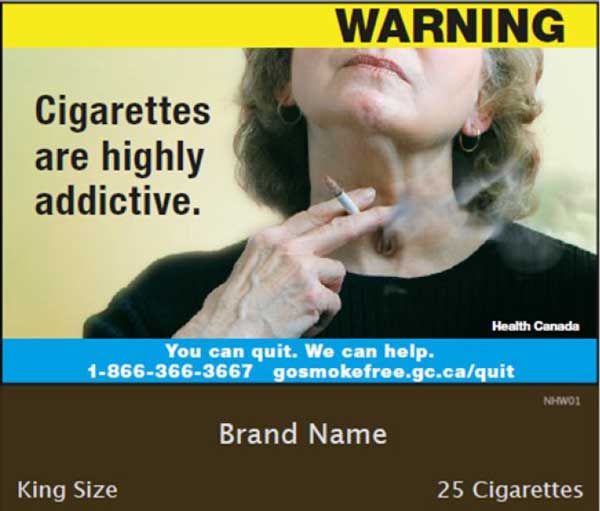
Text Description
A middle-aged woman smoking a cigarette through a hole in her throat.
The bottom 25% of the package is dark brown.
The text reads:
WARNING
Cigarettes are highly addictive.
You can quit. We can help.
1-866-366-3667
gosmokefree.gc.ca/quit
Health Canada

Description textuelle
Une femme d'âge moyen fumant une cigarette par un trou dans sa gorge.
Le quart inférieur du paquet est brun foncé.
Le texte est le suivant :
AVERTISSEMENT
La cigarette crée une très forte dépendance.
Vous pouvez arrêter. Nous pouvons vous aider.
1 866 JARRETE (1 866 527-7383)
vivezsansfumee.gc.ca/abandon
Santé Canada
This HW was chosen as the most noticeable by 15 percent of respondents from the set they were shown to evaluate noticeability.
The consensus is that the image is the most eye-catching aspect of NHW-1 (80%), well ahead of the text and warning banner. Most agree that the picture alone (90%) and with the text (89%) conveys the message, that the colour of the warning banner caught their attention (78%) and that the quitline phone number and web address is easy to read (78%).
The key impressions of NHW-1 are that it is "believable" (49%), helps readers understand the health conditions caused by smoking (45%), and leads them to think about quitting (41%). On a similar note, most (92%) believe what it says about the health effects of smoking (including almost six in ten who say it is definitely true). Three quarters (74%) say they wouldn't want to see the picture again and more than eight in ten (82%) say they would remember this HW in a month from now.
% of respondents exposed to this HW (n=609) who chose as most noticeable: 15% (-5%)14
| Number of respondents evaluating this HW | n=215 |
|---|---|
| Q25. What first catches your eye? | Overall |
| Image | 80% |
| Text | 12% |
| Warning banner | 6% |
| Quitline phone number/web address | 2% |
| Q33. Statement(s) that best fit your impression of this HW | Overall |
| Is believable | 49% |
| Leads me to think about quitting | 41% |
| Helps me understand the health conditions caused by smoking | 45% |
| Is relevant to me personally | 20% |
| Makes me interested in reading the text | 19% |
| Has new information | 10% |
| Is hard to understand and/or unclear | 6% |
| None of these fit my impression | 8% |
| Table 65B: Responses for NHW-1 (n=215) | ||||
|---|---|---|---|---|
| Q26-Q32. Visual statements | Strongly agree | Somewhat agree | Somewhat disagree | Strongly disagree |
| The colour of the WARNING banner catches my attention | 37% | 42% | 14% | 7% |
| The picture alone tells me about the health condition | 47% | 44% | 9% | 0% |
| The picture and the text work together to relay the message | 42% | 47% | 8% | 2% |
| The quitline phone number and web address is easy to read | 27% | 51% | 16% | 5% |
| The colour contrast between the text and background makes the text easy to read | 37% | 43% | 14% | 5% |
| I would not want to see this picture again | 39% | 36% | 13% | 11% |
| Q35. Believable/credible | Definitely | Probably | Probably not | Definitely not |
| Do you believe what this warning says about the health effects of smoking is true? | 58% | 34% | 6% | 0% |
| Q36. Memorable | Definitely would | Probably would | Probably would not | Definitely would not |
| Would you remember this health warning one month from now? | 39% | 43% | 12% | 3% |
Significant demographic subgroup differences in evaluations of this HW:
- The image is considered the most eye-catching part of NHW-1 across the board, but particularly among those planning to quit within six months (96%) or in the next three months (93% vs. 73% who are not). The text is considered a more eye-catching aspect in French (24%) than English (9%).
- Those who plan to quit within three months are more likely than others to say NHW-1 helps them understand the health conditions caused by smoking (68%) and is believable (67%), and to believe this health warning is definitely true (83%).
HW Evaluation: NHW-2

Text Description
A little boy holding a sign "Smoking harms everyone!"
The bottom 25% of the package is dark brown.
The text reads:
WARNING
There is no safe amount of second-hand smoke.
You can quit. We can help.
1-866-366-3667
gosmokefree.gc.ca/quit
Health Canada
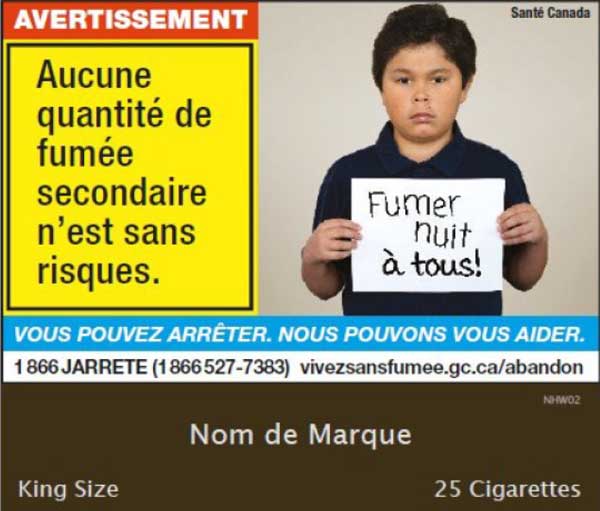
Description textuelle
Un petit garçon tenant une affiche « Fumer nuit à tous! »
Le quart inférieur du paquet est brun foncé.
Le texte est le suivant :
AVERTISSEMENT
Aucune quantité de fumée secondaire n'est sans risques.
Vous pouvez arrêter. Nous pouvons vous aider.
1 866 JARRETE (1 866 527-7383)
vivezsansfumee.gc.ca/abandon
Santé Canada
This HW was chosen as the most noticeable by fewer than one in ten (8%) respondents from the set they were shown to evaluate noticeability
Half say the image is the most eye-catching thing about the NHW-2 health warning, while one-third say it is the text and 14 percent identify the warning banner. Eight in ten (82%) agree the text and picture work together to relay the message, but fewer agree (63%) that the picture alone tells them about the health condition. Large majorities agree that the colour contrast between the text and background makes the text easy to read (88%) and that the colour of the warning banner catches their attention (79%).
Half say the statement that best fits their impression of this HW is "believable"; a strong majority (85%) also believe what it says about the health effects of smoking. Two thirds (65%) say they would remember this HW in a month from now. Less than half (48%) are opposed to seeing this health warning again.
% of respondents exposed to this HW (n=616) who chose as most noticeable: 8% (-12%)15
| Number of respondents evaluating this HW | n=179 |
|---|---|
| Q25. What first catches your eye? | Overall |
| Image | 50% |
| Text | 34% |
| Warning banner | 14% |
| Quitline phone number/web address | 3% |
| Q33. Statement(s) that best fit your impression of this HW | Overall |
| Is believable | 50% |
| Leads me to think about quitting | 32% |
| Helps me understand the health conditions caused by smoking | 24% |
| Is relevant to me personally | 16% |
| Makes me interested in reading the text | 18% |
| Has new information | 8% |
| Is hard to understand and/or unclear | 3% |
| None of these fit my impression | 17% |
| Table 66B: Responses for NHW-2 (n=179) | ||||
|---|---|---|---|---|
| Q26-Q32. Visual statements | Strongly agree | Somewhat agree | Somewhat disagree | Strongly disagree |
| The colour of the WARNING banner catches my attention | 31% | 49% | 12% | 6% |
| The picture alone tells me about the health condition | 24% | 39% | 23% | 11% |
| The picture and the text work together to relay the message | 32% | 50% | 11% | 6% |
| The quitline phone number and web address is easy to read | 27% | 50% | 17% | 5% |
| The colour contrast between the text and background makes the text easy to read | 34% | 54% | 10% | 3% |
| I would not want to see this picture again | 15% | 33% | 31% | 14% |
| Q35. Believable/credible | Definitely | Probably | Probably not | Definitely not |
| Do you believe what this warning says about the health effects of smoking is true? | 44% | 41% | 7% | 4% |
| Q36. Memorable | Definitely would | Probably would | Probably would not | Definitely would not |
| Would you remember this health warning one month from now? | 22% | 44% | 22% | 5% |
Significant demographic subgroup differences in evaluations of this HW:
- The proportion who agree that the colour of the warning banner catches their attention is higher among English respondents (21%) than French ones (9%).
- The proportion who say NHW-2 is relevant to them personally is higher among females (26% vs. 8% of males) and those with a high school diploma or less (29%, vs. 12% with at least some postsecondary education).
- Daily smokers are more likely to say that NHW-2 is believable (58%) than occasional smokers (38%).
HW Evaluation: NHW-3

Text Description
An adolescent girl holding a sign (Stop Smoking)
The bottom 25% of the package is dark brown.
The text reads:
WARNING
In a single year, exposure to second-hand smoke kills almost 1000 Canadians.
You can quit. We can help.
1-866-366-3667
gosmokefree.gc.ca/quit
Health Canada
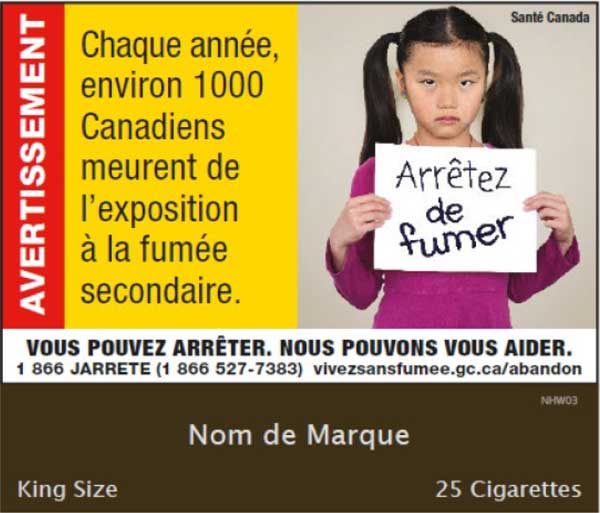
Description textuelle
Une adolescente tenant une affiche « Arrêtez de fumer ».
Le quart inférieur du paquet est brun foncé.
Le texte est le suivant :
AVERTISSEMENT
Chaque année, environ 1000 Canadiens meurent de l'exposition à la fumée secondaire.
Vous pouvez arrêter. Nous pouvons vous aider.
1 866 JARRETE (1 866 527-7383)
vivezsansfumee.gc.ca/abandon
Santé Canada
This HW was chosen as the most noticeable by one in ten (9%) respondents from the set they were shown to evaluate noticeability.
For NHW-3, the image is more than twice as likely (67%) as the text to catch the eye first. Eight in ten (83%) agree the text and picture work together to relay the message, but fewer agree (64%) that the picture alone tells them about the health condition. A large majority agree that the colour contrast between the text and background makes the text easy to read (90%) while three quarters say that the quitline phone number and web address is easy to read (77%) and that the colour of the warning banner catches their attention (73%).
The top impression of NHW-3 is that it is "believable" although less than half chose this (43%). Nonetheless, a strong majority (78%) believe what it says about the health effects of smoking (including more than one in three who say it is definitely true). A little less than three quarters (72%) say they would remember this HW in a month from now. Half of those who evaluated this HW (50%) are opposed to seeing this health warning again.
% of respondents exposed to this HW (n=608) who chose as most noticeable: 9% (-11%)16
| Number of respondents evaluating this HW | n=178 |
|---|---|
| Q25. What first catches your eye? | Overall |
| Image | 67% |
| Text | 24% |
| Warning banner | 8% |
| Quitline phone number/web address | 1% |
| Q33. Statement(s) that best fit your impression of this HW | Overall |
| Is believable | 43% |
| Leads me to think about quitting | 36% |
| Helps me understand the health conditions caused by smoking | 20% |
| Is relevant to me personally | 20% |
| Makes me interested in reading the text | 20% |
| Has new information | 9% |
| Is hard to understand and/or unclear | 5% |
| None of these fit my impression | 17% |
| Table 67B: Responses for NHW-3 (n=178) | ||||
|---|---|---|---|---|
| Q26-Q32. Visual statements | Strongly agree | Somewhat agree | Somewhat disagree | Strongly disagree |
| The colour of the WARNING banner catches my attention | 34% | 39% | 18% | 7% |
| The picture alone tells me about the health condition | 23% | 41% | 19% | 10% |
| The picture and the text work together to relay the message | 31% | 52% | 11% | 5% |
| The quitline phone number and web address is easy to read | 38% | 39% | 17% | 5% |
| The colour contrast between the text and background makes the text easy to read | 39% | 50% | 6% | 4% |
| I would not want to see this picture again | 16% | 34% | 31% | 13% |
| Q35. Believable/credible | Definitely | Probably | Probably not | Definitely not |
| Do you believe what this warning says about the health effects of smoking is true? | 36% | 42% | 15% | 2% |
| Q36. Memorable | Definitely would | Probably would | Probably would not | Definitely would not |
| Would you remember this health warning one month from now? | 26% | 47% | 16% | 8% |
Significant demographic subgroup differences in evaluations of this HW:
- Daily smokers are more likely to say that the image is what caught their eye first (75% vs. 52% of occasional smokers). Conversely, occasional smokers are more likely to say the text did (36% to 18% of daily smokers).
- Those who plan to quit within three months are more likely than others to say NHW-3 is believable (64%) and helps them understand the health conditions caused by smoking (40%).
HW Evaluation: NHW-4
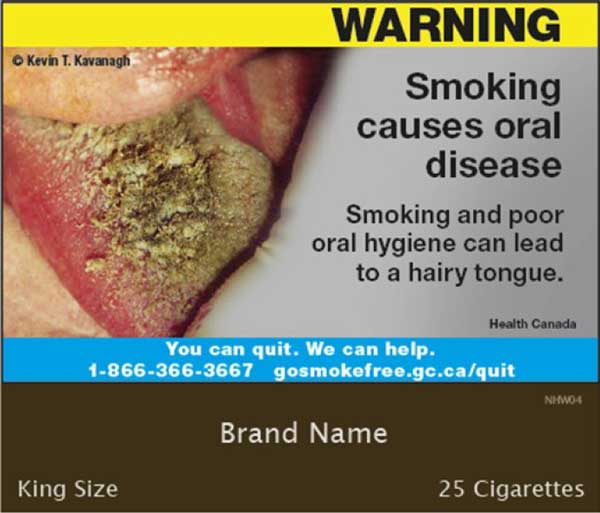
Text Description
A tongue infected by hairy tongue. © Kevin T. Kavanagh
The bottom 25% of the package is dark brown.
The text reads:
WARNING
Smoking causes oral disease.
Smoking and poor oral hygiene can lead to a hairy tongue.
You can quit. We can help.
1-866-366-3667
gosmokefree.gc.ca/quit
Health Canada
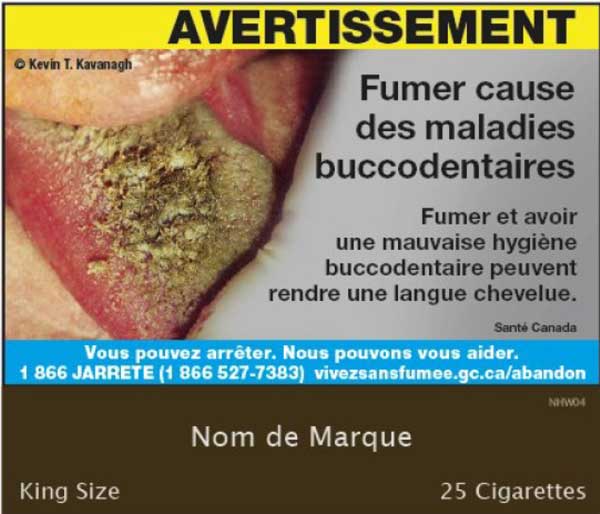
Description textuelle
Une langue atteinte de la langue chevelue. © Kevin T. Kavanagh
Le quart inférieur du paquet est brun foncé.
Le texte est le suivant :
AVERTISSEMENT
Fumer cause des maladies buccodentaires.
Fumer et avoir une mauvaise hygiène buccodentaire peuvent rendre une langue chevelue.
Vous pouvez arrêter. Nous pouvons vous aider.
1 866 JARRETE (1 866 527-7383)
vivezsansfumee.gc.ca/abandon
Santé Canada
This HW was chosen as the most noticeable by one in five (19%) respondents from the set they were shown to evaluate noticeability.
There is a consensus that the image is the most eye-catching aspect of NHW-4 (88%), and that the picture conveys the necessary information about the health condition alone (85%, including 54% who strongly agree) and together with the text (83% agree overall). Most also agree that colour contrast between the text and background makes the text easy to read (84%), the colour of the warning banner catches their attention (83%) and that the quitline phone number and web address is easy to read (76%).
The key impressions of NHW-4 are that it helps readers understand the health conditions caused by smoking, leads them to think about quitting (45% each) and is "believable" (41%). On a similar note, a large majority (84%) believe what it says about the health effects of smoking, including almost half who say it is definitely true). More than three quarters (78%) say they would remember this HW in a month from now. A strong majority (81%) say they wouldn't want to see the picture again.
% of respondents exposed to this HW (n=610) who chose as most noticeable: 19% (-1%)17
| Number of respondents evaluating this HW | n=228 |
|---|---|
| Q25. What first catches your eye? | Overall |
| Image | 88% |
| Text | 6% |
| Warning banner | 4% |
| Quitline phone number/web address | 2% |
| Q33. Statement(s) that best fit your impression of this HW | Overall |
| Is believable | 41% |
| Leads me to think about quitting | 45% |
| Helps me understand the health conditions caused by smoking | 45% |
| Is relevant to me personally | 17% |
| Makes me interested in reading the text | 20% |
| Has new information | 23% |
| Is hard to understand and/or unclear | 8% |
| None of these fit my impression | 13% |
| Table 68B: Responses for NHW-4 (n=228) | ||||
|---|---|---|---|---|
| Q26-Q32. Visual statements | Strongly agree | Somewhat agree | Somewhat disagree | Strongly disagree |
| The colour of the WARNING banner catches my attention | 44% | 39% | 11% | 4% |
| The picture alone tells me about the health condition | 54% | 31% | 7% | 6% |
| The picture and the text work together to relay the message | 44% | 39% | 13% | 2% |
| The quitline phone number and web address is easy to read | 38% | 38% | 18% | 5% |
| The colour contrast between the text and background makes the text easy to read | 44% | 40% | 11% | 3% |
| I would not want to see this picture again | 50% | 31% | 10% | 7% |
| Q35. Believable/credible | Definitely | Probably | Probably not | Definitely not |
| Do you believe what this warning says about the health effects of smoking is true? | 46% | 38% | 9% | 3% |
| Q36. Memorable | Definitely would | Probably would | Probably would not | Definitely would not |
| Would you remember this health warning one month from now? | 36% | 42% | 14% | 6% |
Significant demographic subgroup differences in evaluations of this HW:
- Strong agreement that the picture alone tells them about the health condition (57% vs. 40%) and the colour contrast makes the text easier to read (48% vs. 29%) is higher in English than in French, as is the proportion who say NHW-4 leads them to think about quitting (50% vs. 25%).
- The proportion who believe what NHW-4 says about the health effects of smoking is higher among females (92% definitely/probably, vs. 77% of males).
- Those who plan to quit within three months are more likely than others to say NHW-4 leads them to think about quitting (59%), and to believe this health warning is definitely true (69%). This segment is also more likely to strongly agree with several statements about it (e.g. the warning banner colour catches their attention, the picture and the text work together to relay the message, colour contrast makes text easy to read).
HW Evaluation: NHW-5

Text Description
The side of a man's throat infected by cancer. © Kevin T. Kavanagh
The bottom 25% of the package is dark brown.
The text reads:
WARNING
Smoking causes neck cancer.
You can quit. We can help.
1-866-366-3667
gosmokefree.gc.ca/quit
Health Canada
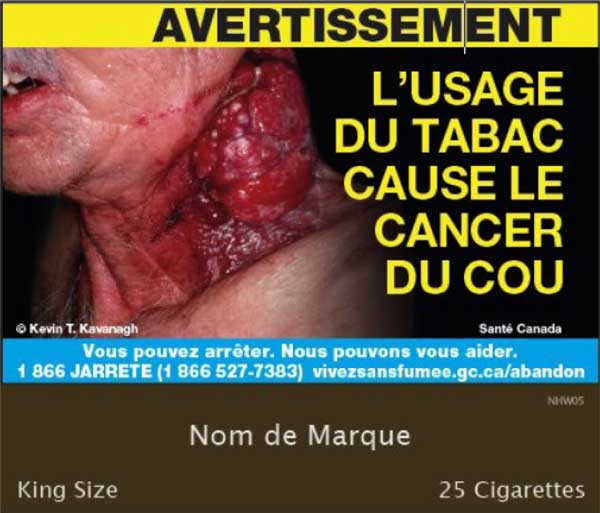
Description textuelle
Le côté de la gorge d'un homme atteint du cancer. © Kevin T. Kavanagh
Le quart inférieur du paquet est brun foncé.
Le texte est le suivant :
AVERTISSEMENT
L'usage du tabac cause le cancer du cou.
Vous pouvez arrêter. Nous pouvons vous aider.
1 866 JARRETE (1 866 527-7383)
vivezsansfumee.gc.ca/abandon
Santé Canada
This HW was chosen as the most noticeable by more than four in ten (44%) respondents from the set they were shown to evaluate noticeability.
The consensus is that the image is the most eye-catching aspect of NHW-5 (92%). Most agree that the picture works alone (90%, with 63% strongly agree) and with the text (91%, with 57% strongly agree) to communicate the desired message. Agreement that the colour contrast between the text and background makes the health warning easy to read (88%) and that the colour of the warning banner catches their attention (85%) are also high. Seven in ten agree that the quitline phone number and web address is easy to read (72%).
The top impression of NHW-5 is that it leads respondents to think about quitting (51%). Almost half say this HW helps them understand the health conditions caused by smoking (46%) and that it is believable (45%). Most (85%) believe what it says about the health effects of smoking (including half who say it is definitely true). The HW is very memorable with more than four in five (82%) agreeing they would remember this HW in a month from now. A strong majority (86%) also say they wouldn't want to see the picture again.
% of respondents exposed to this HW (n=612) who chose as most noticeable: 44% (+24%)18
| Number of respondents evaluating this HW | n=378 |
|---|---|
| Q25. What first catches your eye? | Overall |
| Image | 92% |
| Text | 4% |
| Warning banner | 3% |
| Quitline phone number/web address | 1% |
| Q33. Statement(s) that best fit your impression of this HW | Overall |
| Is believable | 45% |
| Leads me to think about quitting | 51% |
| Helps me understand the health conditions caused by smoking | 46% |
| Is relevant to me personally | 11% |
| Makes me interested in reading the text | 20% |
| Has new information | 17% |
| Is hard to understand and/or unclear | 4% |
| None of these fit my impression | 12% |
| Table 69B: Responses for NHW-5 (n=378) | ||||
|---|---|---|---|---|
| Q26-Q32. Visual statements | Strongly agree | Somewhat agree | Somewhat disagree | Strongly disagree |
| The colour of the WARNING banner catches my attention | 49% | 36% | 9% | 4% |
| The picture alone tells me about the health condition | 63% | 28% | 5% | 3% |
| The picture and the text work together to relay the message | 57% | 34% | 4% | 3% |
| The quitline phone number and web address is easy to read | 33% | 39% | 18% | 7% |
| The colour contrast between the text and background makes the text easy to read | 51% | 37% | 7% | 3% |
| I would not want to see this picture again | 58% | 28% | 8% | 3% |
| Q35. Believable/credible | Definitely | Probably | Probably not | Definitely not |
| Do you believe what this warning says about the health effects of smoking is true? | 49% | 36% | 6% | 3% |
| Q36. Memorable | Definitely would | Probably would | Probably would not | Definitely would not |
| Would you remember this health warning one month from now? | 47% | 35% | 9% | 4% |
Significant demographic subgroup differences in evaluations of this HW:
- Strong agreement that the picture and text work together to relay the message is higher in English (59% vs. 47% in French). The proportion who say NHW-5 is believable is also higher in English (48% vs. 34% French), while the proportion who say it makes them interested in reading the text is higher in French (28%, vs. 18% English).
- Strong agreement that the picture alone tells them about the health condition is higher among those with a high school diploma or less (72%, vs. 55% with a university degree).
- Those who plan to quit within three or six months are more likely than others to say NHW-5 is believable (respectively, 56% and 55%), and to believe this health warning is definitely true (respectively 70% and 62%).
HW Evaluation: NHW-6
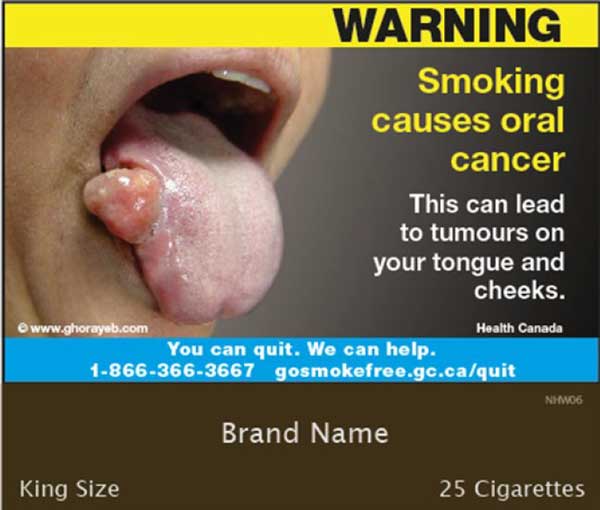
Text Description
A tongue infected by cancer. © www.ghorayeb.com
The bottom 25% of the package is dark brown.
The text reads:
WARNING
Smoking causes oral cancer.
This can lead to tumours on your tongue and cheeks.
You can quit. We can help.
1-866-366-3667
gosmokefree.gc.ca/quit
Health Canada

Description textuelle
Une langue infectée par le cancer. © www.ghorayeb.com
Le quart inférieur du paquet est brun foncé.
Le quart inférieur du paquet est brun foncé.
Le texte est le suivant :
AVERTISSEMENT
Fumer cause le cancer de la bouche.
Ce cancer cause des tumeurs sur la langue et dans les joues.
Vous pouvez arrêter. Nous pouvons vous aider.
1 866 JARRETE (1 866 527-7383)
vivezsansfumee.gc.ca/abandon
Santé Canada
This HW was chosen as the most noticeable by almost one-quarter (23%) of respondents from the set they were shown to evaluate noticeability
The consensus is that the image is the most eye-catching aspect of NHW-6 (95%). Most agree that the picture works alone (91%, with 58% strongly agree) and with the text (94%, with 55% strongly agree) to communicate the desired message. A strong majority (86%) say they wouldn't want to see the picture again. There is also broad agreement that the colour of the warning banner catches people's attention (83%) and that the quitline phone number and web address is easy to read (74%).
The top impressions of NHW-6 are that it is believable, helps them understand the health conditions caused by smoking (51% each) and leads them to think about quitting (50%). Almost all (91%) believe what it says about the health effects of smoking (including more than half who say it is definitely true), and that they would remember this HW in a month from now (83%).
% of respondents exposed to this HW (n=604) who chose as most noticeable: 23% (+3%)19
| Number of respondents evaluating this HW | n=254 |
|---|---|
| Q25. What first catches your eye? | Overall |
| Image | 95% |
| Text | 3% |
| Warning banner | 0% |
| Quitline phone number/web address | 3% |
| Q33. Statement(s) that best fit your impression of this HW | Overall |
| Is believable | 51% |
| Leads me to think about quitting | 50% |
| Helps me understand the health conditions caused by smoking | 51% |
| Is relevant to me personally | 20% |
| Makes me interested in reading the text | 22% |
| Has new information | 21% |
| Is hard to understand and/or unclear | 5% |
| None of these fit my impression | 10% |
| Table 70B: Responses for NHW-6 (n=254) | ||||
|---|---|---|---|---|
| Q26-Q32. Visual statements | Strongly agree | Somewhat agree | Somewhat disagree | Strongly disagree |
| The colour of the WARNING banner catches my attention | 41% | 42% | 11% | 6% |
| The picture alone tells me about the health condition | 58% | 33% | 7% | 1% |
| The picture and the text work together to relay the message | 55% | 39% | 5% | 2% |
| The quitline phone number and web address is easy to read | 33% | 42% | 20% | 3% |
| The colour contrast between the text and background makes the text easy to read | 44% | 47% | 6% | 2% |
| I would not want to see this picture again | 53% | 33% | 8% | 6% |
| Q35. Believable/credible | Definitely | Probably | Probably not | Definitely not |
| Do you believe what this warning says about the health effects of smoking is true? | 55% | 36% | 5% | 1% |
| Q36. Memorable | Definitely would | Probably would | Probably would not | Definitely would not |
| Would you remember this health warning one month from now? | 49% | 34% | 11% | 2% |
Significant demographic subgroup differences in evaluations of this HW:
- Overall agreement (strongly or somewhat) that the colour contrast makes the text easy to read is higher in English (94% vs. 75% in French). The proportion who say NHW-6 helps them understand the health conditions caused by smoking (57% vs. 32%) and leads them to think about quitting (53% vs. 36%) is also higher in English than French.
- Strong agreement with several statements about NHW-6 is higher among females than males (e.g., colour of warning banner catches their attention, the image and the text work together to relay the message, colour contrast makes text easy to read, would not want to see picture again).
- The proportion who say NHW-6 leads them to think about quitting is higher among those who plan to quit within three or six months (respectively, 70% and 66%) and those who want to quit but haven't thought about when (60%) than among those with no plans to quit (20%). Those who plan to quit within three months are more likely than others to believe this health warning is definitely true (73%).
- Occasional smokers are more likely to remember (definitely or probably) this HW in a month from now than daily smokers (91% to 79%).
HW Evaluation: NHW-7
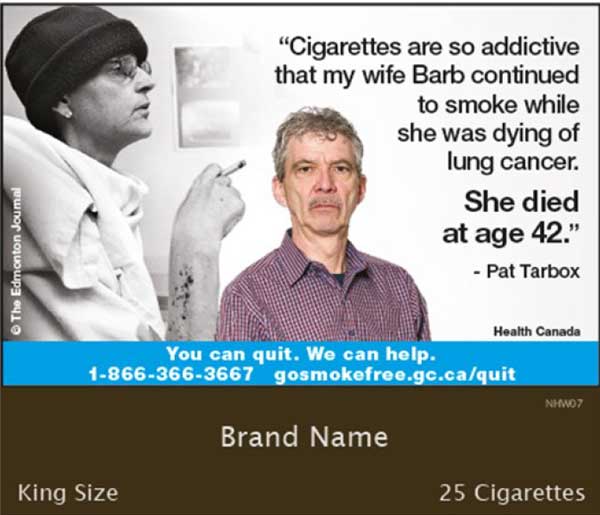
Text Description
Barb Tarbox smoking a cigarette while in the hospital suffering from lung cancer. Her husband Pat Tarbox standing. © The Edmonton Journal
The bottom 25% of the package is dark brown.
The text reads:
"Cigarettes are so addictive that my wife Barb continued to smoke while she was dying of lung cancer.
She died at age 42."
- Pat Tarbox
You can quit. We can help.
1-866-366-3667
gosmokefree.gc.ca/quit
Health Canada
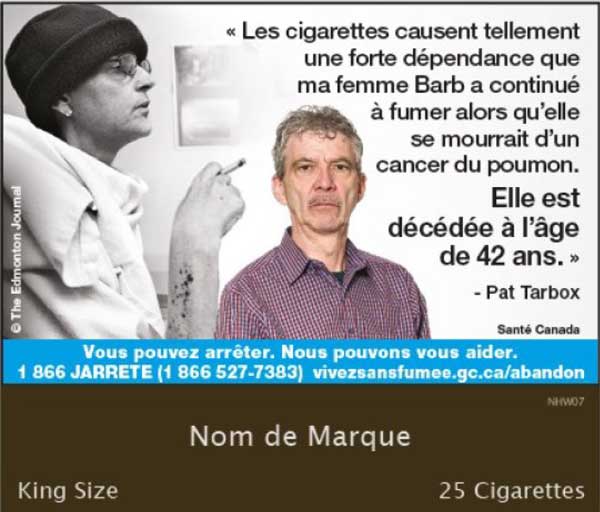
Description textuelle
Barb Tarbox en train de fumer une cigarette pendant qu'elle est à l'hôpital, atteinte d'un cancer du poumon. Son mari Pat Tarbox debout à côté de sa photo. © The Edmonton Journal
Le quart inférieur du paquet est brun foncé.
Le texte est le suivant :
« Les cigarettes causent tellement une forte dépendence que ma femme Barb a continué à fumer alors qu'elle se mourait d'un cancer du poumon.
Elle est décédée à l'âge de 42 ans. »
- Pat Tarbox
Vous pouvez arrêter. Nous pouvons vous aider.
1 866 JARRETE (1 866 527-7383)
vivezsansfumee.gc.ca/abandon
Santé Canada
This HW was chosen as the most noticeable by five percent of respondents from the set they were shown to evaluate noticeability.
Six in ten (59%) say the image is the most eye-catching thing about the NHW-7, while four in ten say it is the text. Regarding the visual elements, the majority agree the picture and text work together to relay the message (86% with 42% agreeing strongly), that the colour contrast between the text and background makes the text easy to read (82%), that the quitline phone number and web address is easy to read (77%) and that the bolding and/or framing of the text draws my attention to the text (75%).
The top impression of NHW-7 is it is believable (60%). Most (90%) also believe it is a real person's story about the health effects of smoking (including one in three who say it definitely is). Around two thirds (65%) say they wouldn't want to see the picture again and seven in ten (70%) say they would remember this HW in a month from now.
% of respondents exposed to this HW (n=613) who chose as most noticeable: 5% (-15%)20
| Number of respondents evaluating this HW | n=152 |
|---|---|
| Q25. What first catches your eye? | Overall |
| Image | 59% |
| Text | 40% |
| Warning banner | 0% |
| Quitline phone number/web address | 0% |
| Q33. Statement(s) that best fit your impression of this HW | Overall |
| Is believable | 60% |
| Leads me to think about quitting | 39% |
| Helps me understand the health conditions caused by smoking | 38% |
| Is relevant to me personally | 14% |
| Makes me interested in reading the text | 26% |
| Has new information | 13% |
| Is hard to understand and/or unclear | 5% |
| None of these fit my impression | 10% |
| Table 71B: Responses for NHW-7 (n=152) | ||||
|---|---|---|---|---|
| Q26-Q32. Visual statements | Strongly agree | Somewhat agree | Somewhat disagree | Strongly disagree |
| The picture and the text work together to relay the message | 42% | 45% | 8% | 5% |
| The quitline phone number and web address is easy to read | 34% | 43% | 17% | 5% |
| The bolding and/or framing of the text draws my attention to the text | 26% | 49% | 15% | 7% |
| The colour contrast between the text and background makes the text easy to read | 28% | 54% | 10% | 8% |
| I would not want to see this picture again | 26% | 39% | 20% | 9% |
| Q34. Believable/credible | Definitely | Probably | Probably not | Definitely not |
| Do you believe this is a real person's story about the health effects of smoking? | 35% | 55% | 3% | 4% |
| Q36. Memorable | Definitely would | Probably would | Probably would not | Definitely would not |
| Would you remember this health warning one month from now? | 29% | 42% | 19% | 5% |
Significant demographic subgroup differences in evaluations of this HW:
- English speakers are more likely to strongly agree that the picture and text work together to relay the message (47% vs. 21% in French) and to agree overall (strongly or somewhat) that they would not want to see the image again (69% vs. 47% in French).
- Those who plan to quit within three or six months are more likely than others to say NHW-7 helps them understand the health conditions caused by smoking (respectively, 52% and 45%).
- Daily smokers are more likely to definitely or probably remember this HW in a month from now than occasional smokers (78% to 59%).
HW Evaluation: NHW-8
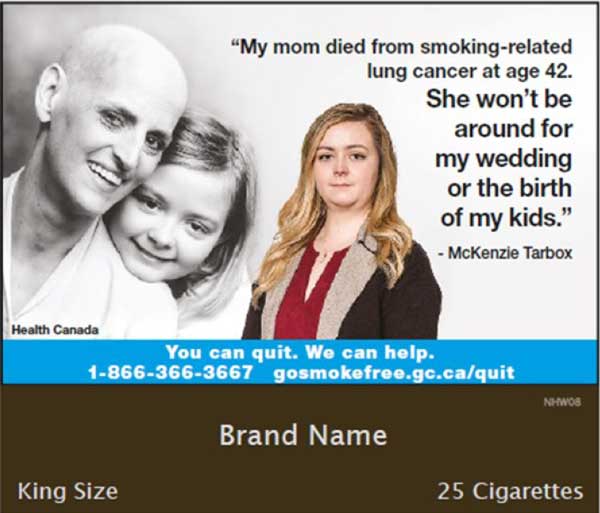
Text Description
A photo of Barb Tarbox without hair and her daughter at a young age and a photo of her daughter as an adult.
The bottom 25% of the package is dark brown
The text reads:
"My mom died from smoking-related lung cancer at age 42. She won't be around for my wedding or the birth of my kids."
- McKenzie Tarbox
You can quit. We can help.
1-866-366-3667
gosmokefree.gc.ca/quit
Health Canada
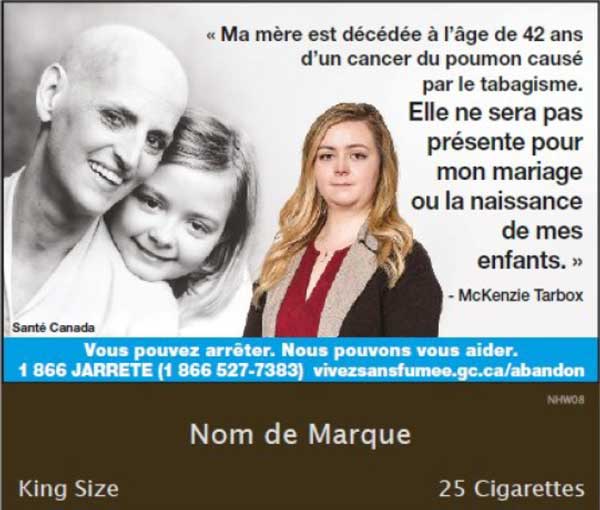
Description textuelle
Une photo de Barb Tarbox sans cheveux avec sa fille lorsqu'elle est enfant, et une photo de sa fille adulte.
Le quart inférieur du paquet est brun foncé.
Le texte est le suivant :
AVERTISSEMENT
« Ma mère est décidée à l'âge de 42 ans d'un cancer du poumon causé par le tabagisme. Elle ne sera pas présente pour mon mariage ou la naissance de mes enfants. »
- McKenzie Tarbox
Vous pouvez arrêter. Nous pouvons vous aider.
1 866 JARRETE (1 866 527-7383)
vivezsansfumee.gc.ca/abandon
Santé Canada
This HW was chosen as the most noticeable by six percent of respondents from the set they were shown to evaluate noticeability.
For NHW-8, the image is twice as likely as the text to catch the eye first (65% to 32%). The majority agree that the colour contrast between the text and background makes the text easy to read (76%) and that the picture and text work together to relay the message (75%). Seven in ten (71%) agree that the quitline phone number and web address is easy to read.
The top impression of NHW-8 is it is believable (63%). The large majority (85%) also believe it is a real person's story about health effects of smoking (including almost half who say it definitely is). Fewer than half (47%) say that they don't want to see the picture again and six in ten (61%) say they would remember this HW in a month from now.
% of respondents exposed to this HW (n=606) who chose as most noticeable: 6% (-14%)21
| Number of respondents evaluating this HW | n=155 |
|---|---|
| Q25. What first catches your eye? | Overall |
| Image | 65% |
| Text | 32% |
| Warning banner | 0% |
| Quitline phone number/web address | 3% |
| Q33. Statement(s) that best fit your impression of this HW | Overall |
| Is believable | 63% |
| Leads me to think about quitting | 39% |
| Helps me understand the health conditions caused by smoking | 35% |
| Is relevant to me personally | 18% |
| Makes me interested in reading the text | 29% |
| Has new information | 8% |
| Is hard to understand and/or unclear | 4% |
| None of these fit my impression | 11% |
| Table 72B: Responses for NHW-8 (n=155) | ||||
|---|---|---|---|---|
| Q26-Q32. Visual statements | Strongly agree | Somewhat agree | Somewhat disagree | Strongly disagree |
| The picture and the text work together to relay the message | 35% | 40% | 15% | 5% |
| The quitline phone number and web address is easy to read | 30% | 41% | 18% | 7% |
| The colour contrast between the text and background makes the text easy to read | 30% | 46% | 13% | 9% |
| I would not want to see this picture again | 17% | 30% | 31% | 16% |
| Q34. Believable/credible | Definitely | Probably | Probably not | Definitely not |
| Do you believe this is a real person's story about the health effects of smoking? | 44% | 41% | 8% | 2% |
| Q36. Memorable | Definitely would | Probably would | Probably would not | Definitely would not |
| Would you remember this health warning one month from now? | 26% | 35% | 24% | 7% |
Significant demographic subgroup differences in evaluations of this HW:
- The proportion who believe this is definitely a real person's story about the health effects of smoking is higher among those with a high school diploma or less (60%, vs. 29% with a university degree).
- Daily smokers are also more likely to believe that this HW contains a real person's story (definitely or probably) than occasional smokers (90% vs. 75%).
HW Evaluation: NHW-9
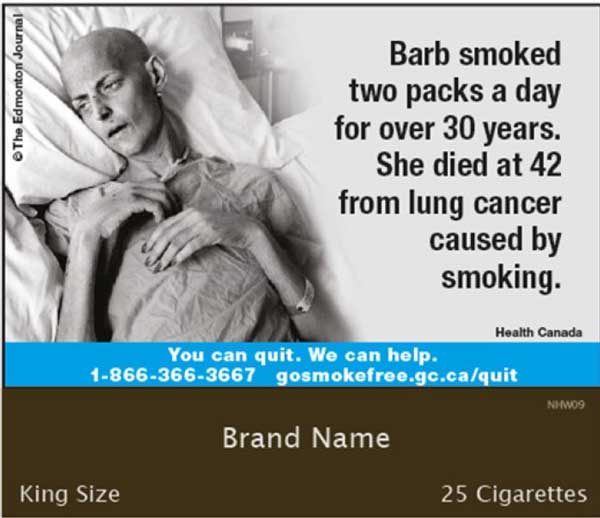
Text Description
Barb Tarbox laying in a hospital bed dying of lung cancer. © The Edmonton Journal
The bottom 25% of the package is dark brown.
The text reads:
Barb smoked two packs a day for over 30 years. She died at 42 from lung cancer caused by smoking.
You can quit. We can help.
1-866-366-3667
gosmokefree.gc.ca/quit
Health Canada
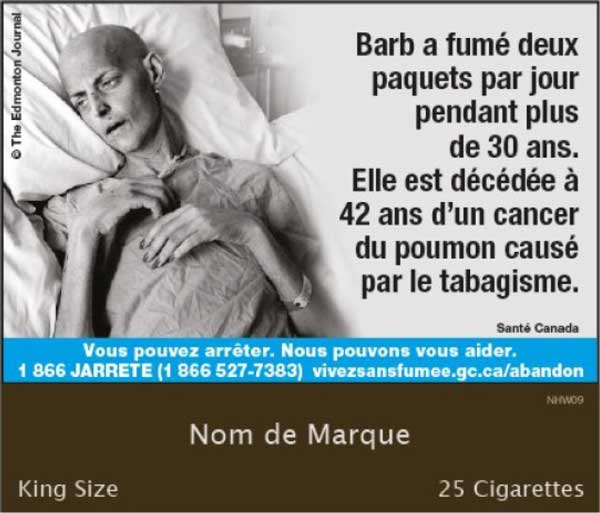
Description textuelle
Barb Tarbox couchée dans un lit d'hôpital, en train de mourir d'un cancer du poumon. © The Edmonton Journal
Le quart inférieur du paquet est brun foncé.
Le texte est le suivant :
Barb a fumé deux paquets par jour pendant plus de 30 ans. Elle est décédée à 42 ans d'un cancer du poumon causé par le tabagisme.
Vous pouvez arrêter. Nous pouvons vous aider.
1 866 JARRETE (1 866 527-7383)
vivezsansfumee.gc.ca/abandon
Santé Canada
This HW was chosen as the most noticeable by one in five (21%) respondents from the set they were shown to evaluate noticeability.
The consensus is that the image is the most eye-catching aspect of NHW-9 (89%). Most agree (89%, with 52% who strongly agree) the picture works with the text to communicate the desired message. A majority also agree that the colour contrast between the text and background makes the text easy to read (86%) and that the quitline phone number and web address is easy to read (75%).
The top impressions of NHW-9 are that it is believable (53%) and helps them understand the health conditions caused by smoking (52%); slightly fewer (48%) say it leads them to think about quitting. The majority (78%) believe it is a real person's story about the health effects of smoking (including almost four in ten who say it definitely is). Seven in ten (72%) say they don't want to see the picture again and four in five (79%) say they would remember this HW in a month from now.
% of respondents exposed to this HW (n=610) who chose as most noticeable: 21% (+1%)22
| Number of respondents evaluating this HW | n=253 |
|---|---|
| Q25. What first catches your eye? | Overall |
| Image | 89% |
| Text | 11% |
| Warning banner | 0% |
| Quitline phone number/web address | 1% |
| Q33. Statement(s) that best fit your impression of this HW | Overall |
| Is believable | 53% |
| Leads me to think about quitting | 48% |
| Helps me understand the health conditions caused by smoking | 52% |
| Is relevant to me personally | 18% |
| Makes me interested in reading the text | 28% |
| Has new information | 11% |
| Is hard to understand and/or unclear | 3% |
| None of these fit my impression | 6% |
| Table 73B: Responses for NHW-9 (n=253) | ||||
|---|---|---|---|---|
| Q26-Q32. Visual statements | Strongly agree | Somewhat agree | Somewhat disagree | Strongly disagree |
| The picture and the text work together to relay the message | 52% | 37% | 6% | 1% |
| The quitline phone number and web address is easy to read | 33% | 42% | 18% | 5% |
| The colour contrast between the text and background makes the text easy to read | 37% | 48% | 10% | 3% |
| I would not want to see this picture again | 37% | 35% | 15% | 7% |
| Q34. Believable/credible | Definitely | Probably | Probably not | Definitely not |
| Do you believe this is a real person's story about the health effects of smoking? | 38% | 40% | 12% | 2% |
| Q36. Memorable | Definitely would | Probably would | Probably would not | Definitely would not |
| Would you remember this health warning one month from now? | 42% | 37% | 12% | 3% |
Significant demographic subgroup differences in evaluations of this HW:
- The image is considered the most eye-catching part of NHW-9 across the board, but particularly in French (96%, vs. 87% in English), while the text is considered a more eye-catching aspect in English (13%) than in French (4%). French respondents are more likely than English respondents to say NHW-9 is relevant to them personally (28% and 15%, respectively).
- Strong agreement that they would not want to see the picture again is higher in English (40% vs. 26% in French) and among females (46% vs. 29% of males). Females are also more likely than males to agree overall (strongly or somewhat) that the picture and text work together to relay the message (94%, vs. 85%) and the quitline phone number and web address is easy to read (82%, vs. 70%).
- Daily smokers are more likely to say that NHW-9 leads them to think about quitting (53% vs. 37% of occasional smokers).
- Those who plan to quit within three months are more likely than others to believe this health warning is definitely true (55%).
HW Evaluation: NHW-22
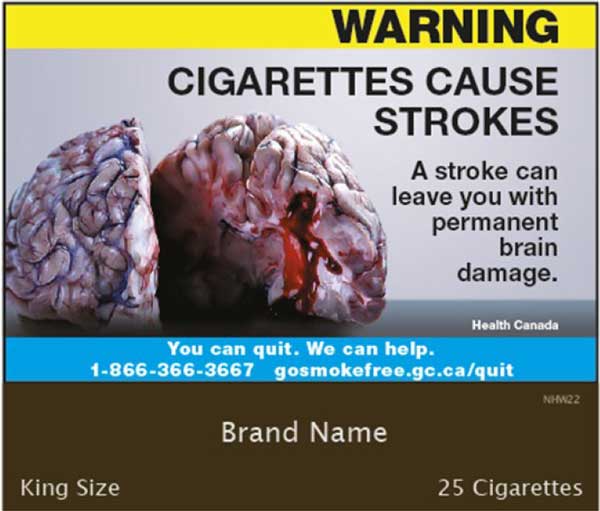
Text Description
A brain split in half affected by a stroke.
The bottom 25% of the package is dark brown
The text reads:
WARNING
Cigarettes cause strokes
A stroke can leave you with permanent brain damage.
You can quit. We can help.
1-866-366-3667
gosmokefree.gc.ca/quit
Health Canada
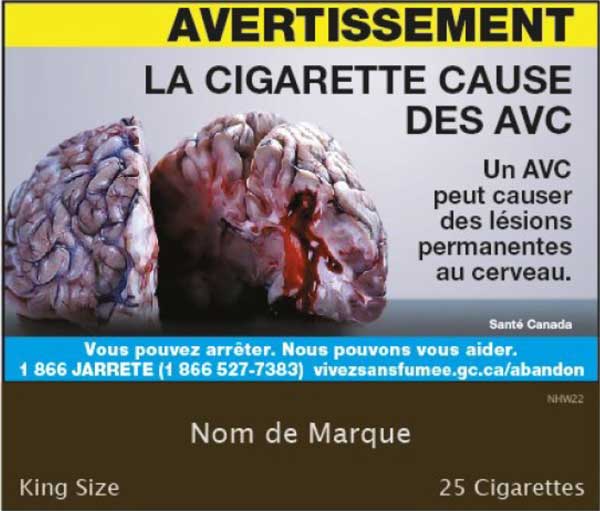
Description textuelle
Un cerveau touché par un AVC coupé en deux.
Le quart inférieur du paquet est brun foncé.
Le texte est le suivant :
AVERTISSEMENT
La cigarette cause des AVC.
Un AVC peut causer des lésions permanentes au cerveau.
Vous pouvez arrêter. Nous pouvons vous aider.
1 866 JARRETE (1 866 527-7383)
vivezsansfumee.gc.ca/abandon
Santé Canada
This HW was chosen as the most noticeable by more than one in six (18%) respondents from the set they were shown to evaluate noticeability.
The consensus is that the image is the most eye-catching aspect of NHW-22 (81%). Most agree that the picture alone (77%) and especially with the text (87%) conveys the message and that the colour contrast between the text and background makes the text easy to read (83%). While four in five agree that the colour of the warning banner catches their attention (80%), only two thirds agree that the quitline phone number and web address is easy to read (66%).
The top impressions of NHW-22 are that it is "believable" (48%) and helps them understand the health conditions caused by smoking (47%). Almost all (90%) believe what it says about the health effects of smoking (including half who say it is definitely true). Almost three quarters (74%) say they don't want to see the picture again and slightly more (78%) say they would remember this HW in a month from now.
% of respondents exposed to this HW (n=610) who chose as most noticeable: 18% (-2%)23
| Number of respondents evaluating this HW | n=224 |
|---|---|
| Q25. What first catches your eye? | Overall |
| Image | 81% |
| Text | 12% |
| Warning banner | 6% |
| Quitline phone number/web address | 1% |
| Q33. Statement(s) that best fit your impression of this HW | Overall |
| Is believable | 48% |
| Leads me to think about quitting | 40% |
| Helps me understand the health conditions caused by smoking | 47% |
| Is relevant to me personally | 20% |
| Makes me interested in reading the text | 26% |
| Has new information | 13% |
| Is hard to understand and/or unclear | 4% |
| None of these fit my impression | 10% |
| Table 74B: Responses for NHW-22 (n=224) | ||||
|---|---|---|---|---|
| Q26-Q32. Visual statements | Strongly agree | Somewhat agree | Somewhat disagree | Strongly disagree |
| The colour of the WARNING banner catches my attention | 38% | 42% | 9% | 10% |
| The picture alone tells me about the health condition | 44% | 33% | 15% | 6% |
| The picture and the text work together to relay the message | 47% | 40% | 9% | 3% |
| The quitline phone number and web address is easy to read | 26% | 40% | 23% | 9% |
| The colour contrast between the text and background makes the text easy to read | 37% | 46% | 7% | 8% |
| I would not want to see this picture again | 38% | 36% | 14% | 8% |
| Q35. Believable/credible | Definitely | Probably | Probably not | Definitely not |
| Do you believe what this warning says about the health effects of smoking is true? | 50% | 39% | 4% | 4% |
| Q36. Memorable | Definitely would | Probably would | Probably would not | Definitely would not |
| Would you remember this health warning one month from now? | 33% | 45% | 14% | 2% |
Significant demographic subgroup differences in evaluations of this HW:
- Overall agreement (strongly or somewhat) that the picture alone tells them about the health condition is higher in French (87%, vs. 75% of English), as is the proportion who say NHW-22 leads them to think about quitting (55% vs. 37% English).
- Strong agreement that they would not want to see this picture again is higher among females (48%, vs. 27% of males), as is the proportion who definitely believe what this warning says about the health effects of smoking (58%, vs. 43% of males).
- The proportion who say NHW-22 leads them to think about quitting (61%) is higher among those planning to quit in the next six months, than among those who are planning a quit attempt within three months, or have no firm plans to quit.
HW Evaluation: NHW-24

Text Description
Set of colons. One healthy one infected. © Dr. Iain Murray
The bottom 25% of the package is dark brown.
The text reads:
WARNING
Smoking causes colorectal cancer.
You can quit. We can help.
1-866-366-3667
gosmokefree.gc.ca/quit
Health Canada
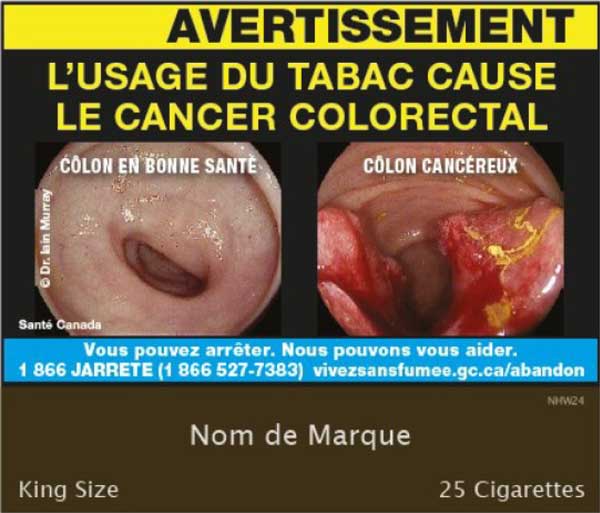
Description textuelle
Deux colons. Un en santé, un infecté. © Dr. Iain Murray
Le quart inférieur du paquet est brun foncé.
Le texte est le suivant :
AVERTISSEMENT
L'usage du tabac cause le cancer colorectal
Vous pouvez arrêter. Nous pouvons vous aider.
1 866 JARRETE (1 866 527-7383)
vivezsansfumee.gc.ca/abandon
Santé Canada
This HW was chosen as the most noticeable by 14 percent of respondents from the set they were shown to evaluate noticeability.
The consensus is that the image is the most eye-catching aspect of NHW-24 (81%). Most agree that the picture alone (85%) and with the text (85%) conveys the message, that the colour of the warning banner catches their attention (86%) and that the colour contrast between the text and background makes the text easy to read (82%). Around three quarters agree that the quitline phone number and web address is easy to read (74%).
The top impressions of NHW-24 is that it helps them understand the health conditions caused by smoking (51%) and that it is believable (48%). Most (88%) believe what it says about the health effects of smoking (including almost half who say it is definitely true) and four in five (80%) say they would remember this HW in a month from now. Moreover, a strong majority (82%) say they wouldn't want to see the picture again.
% of respondents exposed to this HW (n=609) who chose as most noticeable: 14% (-6%)24
| Number of respondents evaluating this HW | n=211 |
|---|---|
| Q25. What first catches your eye? | Overall |
| Image | 81% |
| Text | 9% |
| Warning banner | 8% |
| Quitline phone number/web address | 2% |
| Q33. Statement(s) that best fit your impression of this HW | Overall |
| Is believable | 48% |
| Leads me to think about quitting | 43% |
| Helps me understand the health conditions caused by smoking | 51% |
| Is relevant to me personally | 19% |
| Makes me interested in reading the text | 26% |
| Has new information | 14% |
| Is hard to understand and/or unclear | 3% |
| None of these fit my impression | 12% |
| Table 75B: Responses for NHW-24 (n=211) | ||||
|---|---|---|---|---|
| Q26-Q32. Visual statements | Strongly agree | Somewhat agree | Somewhat disagree | Strongly disagree |
| The colour of the WARNING banner catches my attention | 47% | 40% | 10% | 2% |
| The picture alone tells me about the health condition | 49% | 37% | 12% | 1% |
| The picture and the text work together to relay the message | 47% | 38% | 9% | 4% |
| The quitline phone number and web address is easy to read | 33% | 40% | 21% | 4% |
| The colour contrast between the text and background makes the text easy to read | 43% | 38% | 13% | 3% |
| I would not want to see this picture again | 38% | 44% | 12% | 4% |
| Q35. Believable/credible | Definitely | Probably | Probably not | Definitely not |
| Do you believe what this warning says about the health effects of smoking is true? | 45% | 42% | 4% | 3% |
| Q36. Memorable | Definitely would | Probably would | Probably would not | Definitely would not |
| Would you remember this health warning one month from now? | 36% | 44% | 13% | 2% |
Significant demographic subgroup differences in evaluations of this HW:
- Overall agreement (strongly or somewhat) that the picture and text work together to relay the message is higher in French (93%, vs. 83% in English), as is the proportion who say NHW-24 makes them interested in reading the text (38%, vs. 24% in English). English respondents are more likely than French respondents to say they would not want to see the picture again (85% and 70%, respectively).
- Those who plan to quit in the next three months are more likely than others to say NHW-24 helps them understand the health conditions caused by smoking (73%) and leads them to think about quitting (66%). Those who plan to quit within three months are also more likely than others to say they definitely believe the health warning (66%).
F. Conclusions
The results of this online survey indicate that the information conveyed in HIM and HW is noticeable and understood. Moreover, this research did not uncover any technical or methodological reasons to avoid using a quantitative online methodology again in the future. This type of research design does not replace qualitative research, which can uncover the "why" behind people's reactions.
Health information messages (HIM)
- The current HIM have been developed and previously tested to be both noticeable and effective, and this online survey, which involved comparing them to a pair of uncirculated control HIM, further supports those results.
- Placement matters for HIM; flip-top inserts are more likely to get noticed, but less likely to be read, than slide and shell HIM on the back of the slide. Based on findings around the insert in the FT packages, adding a HIM insert to future S/S packages may increase noticeability but may not increase rates of reading the HIM since many users may discard the insert.
- There is no single variable or element of HIM that, when present or absent, reliably leads to higher levels of recall, interest and credibility. This finding supports the use of a range of approaches and formats for HIM. Moreover, those who are interested in quitting are more open to HIM in general.
Health warnings (HW)
- The HW evaluated in this research are well understood, seen as credible/believable and effective at communicating the health effects and hazards of cigarette use.
- However, there is a clear relationship between noticeability and how graphic the image is. Testimonial HW tend to receive higher believability/credibility scores, even if they are not as noticeable.
- The results of the online survey show that HW are rated differently by respondents depending on their age, gender, education level and intentions to quit. This highlights the importance of exposing smokers to a variety of HW types and approaches that will appeal to people at different stages of life and different smoking experiences.
Appendix A: Methodology
The results of this research are based on an online survey conducted with Canadians aged 16 and older. Data collection was conducted between January 28 to March 5, 2019 with a total of n=3,000 online respondents who identified themselves as current smokers ("At the present time, do you smoke cigarettes every day, occasionally or not at all?" and selected either daily or occasionally).
Survey respondents were drawn from among panels of individuals who have agreed to participate in online surveys. The data have been weighted to reflect the demographic composition of current smokers in Canada. Because the sample is based on those who initially self-selected for participation in the panel, no estimates of sampling error can be calculated, and the results cannot be described as statistically projectable to the target population.
Target population and sample design
The samples were designed to achieve completed surveys with 3,000 current smokers. The 2017 Canadian Tobacco, Alcohol and Drugs Survey (CTADS) provides detailed estimates on the demographic make-up of the current smoker population in Canada in terms of age, gender and region. Quotas were used to obtain a sample stratified by age, gender and region to ensure as representative a sample of Canadian smokers as possible. The quotas also ensured that a sizeable number of surveys were completed by respondents in four different age groups (16-19, 20-24, 25-44 and 45+) to allow adequate sample sizes for analysis of all age groups.
A quota was also included to ensure that at least 1,000 surveys were completed in French which included an oversample in Quebec and the targeting of panellists from areas outside Quebec with French-speaking populations. In total, 2% of French speaking respondents came from outside of Quebec and 98% came from Quebec.
To allow for the inclusion of youth under 18 years of age, the invitation was sent to panellists who were profiled as parents of children aged 16-17. They were then asked to provide consent for their child's participation before having their child complete the survey.
After the data was collected, weighting was used to ensure that each wave is representative of smokers in Canada, per the 2017 CTADS data for current smokers. The weighted data set matches the CTADS data closely in terms of age, region and gender:
| Demographic groups | % of current smokers (CTADS) | Quota | Unweighted sample size | Unweighted proportion | Weighted proportion |
|---|---|---|---|---|---|
| Region | |||||
| Atlantic | 7% | 300 | 301 | 10% | 7% |
| Quebec | 24% | 1,200 | 1,200 | 40% | 24% |
| Ontario | 33% | 600 | 617 | 21% | 33% |
| Prairies | 21% | 600 | 576 | 19% | 21% |
| BC | 14% | 300 | 306 | 10% | 14% |
| Age group | |||||
| 16-19 | 4% | 225 | 227 | 8% | 4% |
| 20-24 | 8% | 320 | 292 | 10% | 8% |
| 25-44 | 37% | 1,055 | 1,060 | 35% | 37% |
| 45+ | 51% | 1,400 | 1,421 | 47% | 51% |
| Sex | |||||
| Male | 54% | 1,750 | 1,727 | 58% | 54% |
| Female | 46% | 1,250 | 1,264 | 42% | 46% |
| Other | n/a | n/a | 9 | <1% | <1% |
| Language | |||||
| English | n/a | 2,000 | 1,993 | 66% | 79% |
| French | n/a | 1,000 | 1,007 | 34% | 21% |
Questionnaire design
Health Canada developed a draft questionnaire which was revised and finalized based on recommendations from Environics. The overall approach for testing HWMs and HIM was developed in close consultation with Health Canada beginning at the kick-off meeting and continuing through questionnaire development.
This collaboration enabled the research to meet the desired objectives and captured all the necessary feedback. The questionnaire was designed to adhere to Federal Government standards for public opinion research. Upon approval from Health Canada, the questionnaire was translated into French. The final questionnaire is included as Appendix B.
In addition to Environics' internal quality control, extensive testing of a test link was done by Health Canada staff to test accuracy in the survey logic, that images being tested were visible and that there was consistency between the English and French questionnaires.
Prior to finalizing the survey for field, an extensive pre-test (soft launch) was conducted in English (50 completed) and French (50 completed). The pre-test included respondents under 18 to ensure that no issues arose which were specific to them. The pre-test assessed the questionnaires in terms of understanding various elements of the question wording, any technical issues involved in viewing or evaluating the images presented and sensitivity to specific questions (and the survey overall). The pre-test also measured the survey length and asked standard Government of Canada pre-testing questions in addition to the survey-specific questions. No changes affecting the integrity of the interviews were made as a result of the pre-test and they were all kept as part of the final sample.
The survey was available to respondents on both a standard, laptop/desktop display format as well as a format optimized for mobile phones/tablets. It used high-resolution visuals of HIM and HW and images which outlined potential locations for new HIM.
Fieldwork
The surveys were conducted by Environics using a secure, fully featured web-based survey environment. Environics' data analysts programmed the questionnaires then performed thorough testing to ensure accuracy in set-up and data collection. This validation ensured that the data entry process conformed to the surveys' basic logic and that responses were being accurately recorded. The data collection system handles sampling invitations, quotas and questionnaire completion (skip patterns, branching, and valid ranges).
All respondents were offered the opportunity to complete the surveys in their official language of choice. Respondents received incentives from the panel supplier in accordance with their regular process for online surveys. All research work was conducted in accordance with the Standards for the Conduct of Government of Canada Public Opinion Research – Online Surveys as well as applicable federal legislation (Personal Information Protection and Electronic Documents Act, or PIPEDA).
Completion results
The completion results are presented in the table below:
| Total email addresses used | 227,472 |
|---|---|
| Invalid cases | 0 |
| invitations mistakenly sent to people who did not qualify for the study | 0 |
| incomplete or missing email addresses | 0 |
| Unresolved (U) | 208,784 |
| email invitations bounce back | 0 |
| email invitations unanswered | 208,784 |
| In-scope non-responding units (IS) | 2713 |
| non-response from eligible respondents | 0 |
| respondent refusals | 0 |
| language problem | 0 |
| selected respondent not available (illness; leave of absence; vacation; other) | 0 |
| early break-offs | 2713 |
| Responding units (R) | 15,975 |
| completed surveys disqualified – quota filled | 584 |
| completed surveys disqualified for other reasons | 12391 |
| completed surveys | 3,000 |
| Participation rate / response rate = R ÷ (U + IS + R) | 7.0% |
Appendix B: Research instrument
Environics Research
January 28, 2019
Health Canada
Online Testing of Health Information Messages and Health Warnings for Tobacco Products
Questionnaire (Final)
Online survey to be conducted with n=3,000 smokers aged 16+; 20-minute average length
QUOTAS
| Quota | |
|---|---|
| Region | |
| Canada (16+) | 3,000 |
| Atlantic (NL, PEI. NB, NS) | 300 |
| Quebec | 1,200 |
| Ontario | 600 |
| Manitoba/Saskatchewan | 300 |
| Alberta | 300 |
| BC + Territories Combined | 300 |
| Quota | |
|---|---|
| Age | |
| 16-19 | 225 |
| 20-24 | 320 |
| 25-44 | 1,055 |
| 45+ | 1,400 |
| Sex | |
| Male | 1,750 |
| Female | 1,250 |
LANDING PAGE
Please select your preferred language for completing the survey.
- 01 – English/Anglais
- 02 – Francais/French
INTRODUCTION FOR PARENTS AND LEGAL GUARDIANS OF 16/17-YEAR OLDS ONLY
As a parent of or legal guardian to a youth living in your household, we are requesting your permission for your 16- or 17-year-old teenager to participate in an important survey being conducted for Health Canada.
The purpose of the survey is to understand opinions about cigarette packaging in Canada. This feedback will be used by Health Canada to develop strategies related to tobacco packaging.
The survey will take about 20 minutes to complete.
Since privacy is important while respondents answer this survey, we request that your child be able to complete the survey in a setting where his/her answers will not be seen by others. All answers will remain anonymous and confidential.
How does the online survey work?
- Your child is being asked to give their opinions about cigarette packaging.
- Your child's participation is completely voluntary.
- Your decision on whether or not to allow your child to participate will not affect any dealings you may have with the Government of Canada.
What about your child's personal information?
- The personal information your child will provide to Health Canada is governed in accordance with the Privacy Act and is being collected under the authority of section 4 of the Department of Health Act in accordance with the Treasury Board Directive on Privacy Practices. We only collect the information we need to conduct the research project.
- Purpose of collection: We require your child's personal information such as demographics (e.g., age, gender) to better understand the topic of the research. However, your child's responses are always combined with the responses of others for analysis and reporting; your child will never be identified.
- For more information: This personal information collection is described in the standard personal information bank Public Communications – PSU 914, in Info Source, available online at infosource.gc.ca.
- Your child's rights under the Privacy Act: In addition to protecting your child's personal information, the Privacy Act gives your child the right to request access to and correction of their personal information. For more information about these rights, or about our privacy practices, please contact Health Canada's Privacy Coordinator at privacy-vie.privee@hc-sc.gc.ca. Your child also has the right to file a complaint with the Privacy Commissioner of Canada if they think their personal information has been handled improperly.
- Your child's personal information will be collected, used, retained and disclosed by Environics in accordance with the applicable provincial privacy legislation or the Personal Information Protection and Electronic Documents Act (PIPEDA). Please click here to review Environics' privacy policy.
- Your child's survey answers will remain anonymous and will not be attributed to him/her in any way.
What happens after the survey?
- The final report written by Environics will be available to the public from Library and Archives Canada (http://www.bac-lac.gc.ca/).
If you have any questions about the survey, please contact Environics at sarah.roberton@environics.ca.
If you agree to allow your child to participate in this survey, please provide the survey link to him/her.
Your child can access the survey using the URL from the email you received or by clicking on the "Continue" button below.
Thank you for your support of this important research.
LINK GOES TO "INTRODUCTION FOR ALL RESPONDENTS" BELOW
INTRODUCTION FOR ALL RESPONDENTS
Background information
Thank you for agreeing to take part in this 20-minute survey being conducted on behalf of Health Canada.
The purpose of the survey is to understand opinions about cigarette packaging in Canada. This feedback will be used by Health Canada to develop strategies related to tobacco packaging.
[RECALL FOR 16/17-YEAR-OLD RESPONDENTS ONLY]: Your parent or legal guardian has given permission for you to participate in this very important study. Your participation is voluntary, so it is up to you to decide whether you are willing to answer, but we hope you do! You can do the survey on your computer, laptop, tablet or phone. You can stop at any time if you feel uncomfortable or choose not to answer certain questions. Your answers will not be shown to your parent(s), legal guardian(s), teachers or anyone else, so please be as honest as you can.
How does the online survey work?
- You are being asked to give your opinions about cigarette packaging.
- Your participation is completely voluntary.
- Your decision whether or not to participate will not affect any dealings you may have with the Government of Canada.
What about your personal information?
- The personal information you provide to Health Canada is governed in accordance with the Privacy Act and is being collected under the authority of section 4 of the Department of Health Act in accordance with the Treasury Board Directive on Privacy Practices. We only collect the information we need to conduct the research project.
- Purpose of collection: We require your personal information such as demographics (e.g. age, gender) to better understand the topic of the research. However, your responses are always combined with the responses of others for analysis and reporting; you will never be identified.
- For more information: This personal information collection is described in the standard personal information bank Public Communications – PSU 914, in Info Source, available online at infosource.gc.ca.
- Your rights under the Privacy Act: In addition to protecting your personal information, the Privacy Act gives you the right to request access to and correction of your personal information. For more information about these rights, or about our privacy practices, please contact Health Canada's Privacy Coordinator at privacy-vie.privee@hc-sc.gc.ca. You also have the right to file a complaint with the Privacy Commissioner of Canada if you think your personal information has been handled improperly.
- Your personal information will be collected, used, retained and disclosed by Environics in accordance with the applicable provincial privacy legislation or the Personal Information Protection and Electronic Documents Act (PIPEDA). Please click here to review Environics' privacy policy.
- Your survey answers will remain anonymous and will not be attributed to you in any way.
What happens after the survey?
- The final report written by Environics will be available to the public from Library and Archives Canada (http://www.bac-lac.gc.ca/).
If you have any questions about the survey, please contact Environics at sarah.roberton@environics.ca.
Please try to answer each question. However, if there is a question you feel unable to answer or prefer not to answer, you can simply continue to the next question. To begin, please click the > button below.
Screening
All screening questions are mandatory
1. Do you or any member of your household work in or have retired from:
| Yes | No | |
|---|---|---|
| A marketing research firm | 1 | 2 |
| A magazine or newspaper | 1 | 2 |
| A radio or television station | 1 | 2 |
| A public relations company | 1 | 2 |
| The government, whether federal or provincial | 1 | 2 |
| An advertising agency or graphic design firm | 1 | 2 |
| Tobacco or e-cigarette company | 1 | 2 |
| Company that produces smoking cessation aids | 1 | 2 |
| Legal or law firm | 1 | 2 |
IF YES TO ANY AT Q1, TERMINATE – Text: "Unfortunately, you do not fit the profile to complete the survey. Thank you for your time and interest in this study."
2. At the present time, do you smoke cigarettes every day, occasionally or not at all?
- 01 – Every day CONTINUE
- 02 - Occasionally CONTINUE
- 03 - Not at all THANK AND TERMINATE
Terminate with standard message – Text: "Unfortunately, you do not fit the profile to complete the survey. Thank you for your time and interest in this study."
3. In what year were you born?
Year ___
- 9999 – Prefer not to say
IF YOUNGER THAN 16, TERMINATE – Text: "Unfortunately, you do not fit the profile to complete the survey. Thank you for your time and interest in this study."
4. IF PREFER NOT TO SAY AT Q3: Would you be willing to indicate in which of the following age categories you belong?
- 01 – Under 16 years of age
- 02 – 16 to 17 years of age
- 03 – 18 to 19 years of age
- 04 – 20 to 24 years of age
- 05 – 25 to 34 years of age
- 06 – 35 to 44 years of age
- 07 – 45 to 54 years of age
- 08 – 55 to 64 years of age
- 09 – 65 years of age or older
- 10 – Prefer not to answer
IF YOUNGER THAN 16 OR REFUSE TO ANSWER, TERMINATE – Text: "Unfortunately, you do not fit the profile to complete the survey. Thank you for your time and interest in this study."
5. In which province or territory do you live? DROP DOWN LIST
- 01 - Alberta
- 02 - British Columbia
- 03 - Manitoba
- 04 - New Brunswick
- 05 - Newfoundland and Labrador
- 06 – Northwest Territories
- 07 - Nova Scotia
- 08 – Nunavut
- 09 - Ontario
- 10 - Prince Edward Island
- 11 - Quebec
- 12 - Saskatchewan
- 13 – Yukon
6. Are you...?
- 01 – Female
- 02 – Male
- 03 – Other
7. [IF Q2=EVERY DAY] Approximately how many cigarettes do you smoke in a day on average?
- 01 – Less than 5
- 02 – 5-9
- 03 – 10-14
- 04 – 15-24
- 05 – 25+
8. What type of cigarette package do you use most often, a flip top or slide and shell package? Be sure to scroll down so that you can see both types of packages. SHOW ONE VISUAL FOR EACH PACKAGE TYPE FLIPTOP: Q8 FT.jpg S/S: Q8_SS.jpg
- 01 - Flip Top
- 02 - Slide and Shell
Health Information Messages (HIM)
The next few questions are about the Health Messages included [IF Q8=flip top:] as an insert in a flip top cigarette package [IF Q8=slide and shell:] on the slide of a slide and shell cigarette package. SHOW VISUAL – FLIPTOP: Q11 FT.jpg S/S: Q9_SS.jpg AND Q10_SS.jpg
Noticeability
9. (If Q8=Slide and shell) In the past month, how often have you noticed the message on the top flap of the slide of cigarette packages? SHOW VISUAL – Q9_SS.jpg
- 01 – Always
- 02 – Often
- 03 – Sometimes
- 04 – Rarely
- 05 – Never
10. (If Q8=Slide and shell and Q9=01-04) In the past month, how often have you read the message on the top flap of the slide of cigarette packages? SHOW VISUAL – Q9_SS.jpg
- 01 – Always
- 02 – Often
- 03 – Sometimes
- 04 – Rarely
- 05 – Never
11. (If Q8=S/S) In the past month, how often, have you noticed messages on the back of the slide of cigarette packages? SHOW VISUAL – Q12_SS.jpg
(If Q8=Flip top) In the past month, how often, have you noticed inserts in cigarette packages? SHOW VISUAL – Q11_FT.jpg
- 01 – Always
- 02 – Often
- 03 – Sometimes
- 04 – Rarely
- 05 – Never SKIP TO SECTION STARTING AT Q.18 (SKIP ALL MEMORY-BASED QUESTIONS)
12. (If Q8=S/S and Q11=01-04) In the past month, how often, have you read the messages on the back of the slides of cigarette packages? SHOW VISUAL – Q12_SS.jpg.
(If Q8=F/T and Q11=01-04) In the past month, how often, have you read the messages on the inserts in cigarette packages? SHOW VISUAL – Q11_FT.jpg.
- 01 – Always SKIP TO Q.14
- 02 – Often SKIP TO Q.14
- 03 – Sometimes SKIP TO Q.14
- 04 – Rarely
- 05 – Never
13. (IF Q12=04-05) Why don't you read the messages on (Q8=S/S: the slides of cigarette packages) (IF Q8=F/T: inserts in cigarette packages) (IF Q12=Rarely: more often)?
Select all that apply
RANDOMIZE LIST
- 01 – I have read/seen them all before/there is nothing new
- 02 – Not interested in getting health messages with my cigarette packages
- 03 – Messages are too long
- 04 – Information is not relevant to me
- 05 – Messages are not interesting/too repetitive
- 06 - (Q8=F/T) I remove the insert as soon as I open the pack
- 07 - (Q8=F/T) Difficult to remove the insert to read it
- 08 - Do not trust the information on a cigarette package
- 09 - Not visually appealing
- 98 [ANCHOR] Other (please specify)
14. (IF Q12=01-03) Why do you read the messages on (Q8=S/S: the slides of cigarette packages) (IF Q8=F/T: inserts in cigarette packages)? Select all that apply
RANDOMIZE LIST
- 01 – The information is interesting
- 02 – To learn something new
- 03 – Information is relevant to me
- 04 – They are very prominent/hard to miss/ignore
- 05 – Information is helpful/helps me try to quit or cut back
- 06 – I trust this source of health information
- 98 - [ANCHOR] Other (please specify)
15. (IF Q12=01-04) Compared to a year ago, do you read the health messages on cigarette package (Q8=S/S: slides) (IF Q8=F/T: inserts)...?
- 01 – More often than before
- 02 – About the same amount
- 03 – Less often than before
16. (if Q8=S/S and Q12=01-04) Thinking about the last time you read a message on the slide of a cigarette package, how much of the message did you read?
(If Q8=F/T and Q12=01-04) Thinking about the last time you read an insert in a cigarette package, how much of the message did you read?
- 01 – All of it
- 02 – Half or more, but not all of it
- 03 – Less than half of it
17. (If Q8=S/S and Q12=01-04) Without looking at a cigarette package, please select up to THREE health topics you remember seeing on cigarette packages.
(If Q8=F/T and Q12=01-04) Without looking at a cigarette package, please select up to THREE health topics you remember seeing on inserts in cigarette packages.
SHOW LIST – RANDOMIZE (DO NOT INCLUDE HEADINGS) – ALLOW UP TO THREE TO BE SELECTED
- Current HIM topics
- 01 - Increasing life expectancy by quitting smoking
- 02 - Respiratory problems /coughing
- 03 - Never quit trying to quit
- 04 - A personal quit story
- 05 - Cravings after quitting smoking
- 06 - Quitting smoking before pregnancy
- 07 - Reasons to quit smoking
- 08 - How to access the Quitline for support
- Other topics (incorrect)
- 09 – Looking better after you have quit smoking
- 10 – How much money you will save from quitting smoking
- 11 – Having better sex as a result of quitting smoking
- 12 – Smoking and your pet
- 13 – Third-hand smoke health effects
- 99 – Not sure/can't recall
Prompted recall of HIMs
IN THIS SECTION, SHOW VISUALS REFLECTING TYPE OF PACKAGE PURCHASED AT Q8
18. Which of these four Health Messages have you ever seen in a cigarette package?
Please scroll to the bottom of the page to view all four images before making your selections.
SHOW 4 TOTAL HIMS – 3 CURRENT AND 1 NEW MESSAGE (RANDOM SELECTION) – IMAGE TYPE (F/T or S/S) BASED ON RESPONSE TO Q8 FOR ALL IMAGES IN Q18 – Q22.
- 01 – Image 1
- 02 – Image 2
- 03 – Image 3
- 04 – Image 4
- 05 – I have not seen any of these before
Reasons for recall (for two HIMs)
PROGRAMMING NOTE: Q19-22 to be asked twice, for two different HIMs (=4 questions *2=8 total questions). Fill in with current messages recalled at Q18 (randomly select 2 if all 3 recalled). If none or only one of current messages recalled, randomly insert current message(s) from remaining list (not shown at Q18). IMAGE TYPE (F/T or S/S) BASED ON RESPONSE TO Q8
SHOW IMAGE ON SAME PAGE AS QUESTIONS FOR ALL Q19-22
19. What about this message first catches your eye?
Select one only
- 01 - The colour
- 02 - The image/picture
- 03 - The overall subject of the message
- 04 - The headline at the top of the message
- 05 - The text in the body of the message
- 06 – (If image includes "(Quitline) in the file name) The quitline number or website
- 98 - Other: please specify
20. How interesting is the topic of this message?
- 01 – Very interesting
- 02 – Somewhat interesting
- 03 – Not very interesting
- 04 – Not at all interesting
21. Do you feel the message is:
- 01 - Too long
- 02 – About the right length
- 03 - Too short
22. How credible or believable is this message?
- 01 – Very
- 02 – Somewhat
- 03 – Not very
- 04 – Not at all
Future HIM placement
23. Please select all the places you think would be good to put a Health Message on a slide and shell package so that people would notice it each time they opened a pack.
Select all that apply
VISUAL – Q23 SS_FINAL.JPG
- 01 – Section A - Inside flap on the slide
- 02 – Section B - An insert into the package
- 03 – Section C - Either side of the shell
- 04 – Section D - Outside flap on the slide
- 05 – Section E - Backside of the slide
- 06 – Section F - Side of the slide
- 07 – None of these sections
Health Warnings (HW)
Note to reader: The objective of the following section is a) to measure the effectiveness (noticeability) of each HW and b) provide feedback on why they are more effective. Rather than rank order, we will group together the effective HW and try to identify the common characteristics among them.
The analysis for this section will compare the responses to Q26 – Q37 for the HW chosen as most effective to the randomly selected less effective HW and the areas of largest difference will demonstrate which elements are most important.
We are now going to show you five draft health warnings for the front of cigarette packages.
RANDOMLY SELECT 5 HWMs
Noticeability
24. Please rank these five health warnings based on how noticeable they are. [IF LAPTOP/DESKTOP] Click and drag to order them from most noticeable at the top, to least noticeable at the bottom or simply click the images in the order you would rank them. [IF MOBILE] Click the images in the order you would rank them with (1) being most noticeable and (5) being least noticeable.
Please scroll to the bottom of the page to view all five images before making your selections.
Reasons for recall (for two HWMs)
PROGRAMMING NOTE: ASK Q25-37 FOR THE HW SELECTED AS MOST NOTICEABLE AND FOR A SECOND RANDOMLY SELECTED HEALTH WARNING.
SHOW IMAGE ON SAME PAGE AS QUESTIONS FOR ALL Q25-37
25. Please select which part of this health warning first (WHEN ASKING ABOUT FIRST HW CHOSEN: "caught" WHEN ASKING ABOUT THE SECOND HW WHICH WAS NOT CHOSEN: "catches") your eye.
Select one only.
- 01 – Image
- 02 – Text
- 03 – Quitline phone number/web address
- 04 – NON-TESTIMONIALS ONLY: Warning banner
Do you agree or disagree with each of the following statements about this Health Warning?
CAROUSEL – RANDOMIZE – MAKE EACH QUESTION MANDATORY
- Strongly agree
- Somewhat agree
- Somewhat disagree
- Strongly disagree
- Not sure
Statements
26. NON-TESTIMONIALS ONLY The colour of the WARNING banner catches my attention
27. NON-TESTIMONIALS ONLY The picture alone tells me about the health condition
28. The picture and the text work together to relay the message
29. The quitline phone number and web address is easy to read
30. [Ask only for the following HWs: HW11, HW19, HW20, HW40, NHW-7] The bolding and/or framing of the text draws my attention to the text
31. The colour contrast between the text and background makes the text easy to read
32. I would not want to see this picture again
33. Please select the statement(s) that best fits your impression of this health warning. Note that you can choose as many statements as apply.
- 01 - Helps me understand the health conditions caused by smoking
- 02 - Makes me interested in read the text
- 03 - Has new information
- 06 - Is relevant to me personally
- 07 - Is believable
- 08 - Leads me to think about quitting
- 09 – Is hard to understand and/or unclear
- 10 – [Exclusive] None of these fit my impression
34. For testimonial Health Warnings only (there are five - Dony, Archie Stewart, Pat Tarbox, MacKenzie Tarbox and Barb Tarbox): Do you believe this is a real person's story about the health effects of smoking?
- 01 – Definitely is
- 02 – Probably is
- 03 - Probably is not
- 04 - Definitely is not
- 05 - Not sure
35. For all non-testimonial Health Warnings: Do you believe what this warning says about the health effects of smoking is true?
- 01 – Definitely
- 02 – Probably
- 03 - Probably not
- 04 - Definitely not
- 05 - Not sure
36. Would you remember this health warning one month from now?
- 01 – Definitely would
- 02 – Probably would
- 03 - Probably would not
- 04 - Definitely would not
- 05 - Not sure
37. Do you have any other comments about this health warning? Please be as specific as possible.
OPEN-ENDED TEXT BOX
- 99 – No comments
Information preferences
Note to reader: In order to avoid introducing bias, Q38 and Q39 should be asked after the HW/HIM questions. We feel that the order of Q40-Q44 works well because it asks first about information/tools used, then the content of the information/tools.
38. Which of the following best describes you? Select one only.
- 01 - I don't want to stop smoking
- 02 - I think I should stop smoking but don't really want to
- 03 - I want to stop smoking but haven't thought about when
- 04 - I want to stop smoking and plan to do so in the next 6 months
- 05 - I really want to stop smoking and intend to in the next 3 months
39. Since you started smoking cigarettes, have you ever made a serious attempt to quit smoking which lasted more than 24 hours?
- 01 - Yes
- 02 – No
40. (IF Q39=YES) Thinking back to the times you attempted to quit smoking for more than 24 hours, where did you get advice or information, if any, on ways to quit?
(IF Q39=NO) If you decided to quit smoking in the future, where do you think you would you go to for advice or information about quitting? Select all that apply
RANDOMIZE LIST
- 01 - A quitline
- 02 - A website
- 03 - Information on a cigarette package
- 04 - An app downloaded to your phone
- 05 - Social media (e.g., Facebook, Instagram)
- 06 - A healthcare provider (i.e. doctor, nurse, counsellor)
- 07 - Friends
- 08 – Family members
- 98 – Other: please specify
- 11 – EXCLUSIVE CHOICE (IF Q39=YES) "I didn't get any advice or information" (IF Q39=NO) "Not interested in information/advice"
41. (IF Q39=YES) Thinking back to the most recent time you attempted to quit smoking for more than 24 hours, what strategies or tools did you use?
(IF Q39=NO) If you decided to quit smoking, which strategies or tools do you think you would try?
Select all that apply
RANDOMIZE LIST
- 01 - Cold turkey (quit without assistance)
- 02 - A plan to reduce the number of cigarettes smoked each day
- 03 - An app downloaded to your phone
- 04 - Counselling from a health care provider
- 05 - Prescription medication from a health care provider
- 06 - Vaping products (e.g. e-cigarette, vape pen, vaporizer or vape mod)
- 07 - Nicotine Replacement Therapy other than vaping (e.g. gum, patches, sprays, inhalers, or lozenges)
- 08 – An organized quit program or challenge
- 98 – Other: please specify
- 11 – EXCLUSIVE CHOICE (IF Q39=YES) "I didn't use any strategy or tool" (IF Q39=NO) "I wouldn't use any strategies or tools"?
42. Which of the following types of health information related to smoking interests you?
Select all that apply
RANDOMIZE LIST
- 01 - Statistics on death rates from smoking
- 02 - Statistics on the health outcomes from quitting
- 03 – How your health can improve as a result of quitting
- 04 – How to reverse the negative health effects of smoking
- 05 - How to end addiction to tobacco
- 06 – Statistics on the likelihood of getting a disease from smoking.
- 98 - Other topics: (please specify)
- 97 - EXCLUSIVE CHOICE None of these topics interest me
43. What type of information about how to quit smoking would you be interested in reading about?
Select all that apply
RANDOMIZE LIST
- 01 – How to use Nicotine Replacement Therapies (other than vaping)
- 02 - How to use vaping to quit smoking
- 03 - The benefits of vaping instead of smoking
- 04 - Tips on how to deal with cravings
- 05 - Stories from people who successfully quit
- 06 - Prescription medication that can help you quit smoking
- 07 - Where to go to get help to quit
- 08 - How to manage triggers that make you want to smoke
- 09 - How to manage withdrawal symptoms
- 10 - How to get started on the quitting process
- 11 – How to manage relapses
- 12 – How to manage social activities while quitting
- 98 - Other: please specify
- 97 - EXCLUSIVE CHOICE None of the above
44. The quitline currently provides a phone number and a web address. If you were seeking information on how to quit, what other contact information would be useful to you? Select all that apply
- 01 - Quitline telephone number that is shorter than a regular number (i.e. #411)
- 02 - Facebook page information
- 03 - Twitter feed information
- 04 - Hash tag (i.e. #smokefree)
- 05 - @ symbol (i.e. @smokefree)
- 06 - Instagram feed information
- 98 - Other (please specify)
- 97 – EXCLUSIVE CHOICE None of the above
Respondent profile questions
The survey is almost done. Just a few more questions that will help us in our statistical calculations. Your answers will be kept anonymous and confidential.
D1. What is the highest level of formal education that you have completed?
- 01 - Some high school or less
- 02 - High School diploma or equivalent
- 03 - Registered Apprenticeship or other trades certificate or diploma
- 04 - College, CEGEP or other non-university certificate or diploma
- 05 - University certificate or diploma below bachelor's level
- 06 - Bachelor's degree
- 07 - Post graduate degree above bachelor's level
- 99 – Prefer not to say
D2. How many people, including yourself, live in your household?
__ - Number of people
- 99 – Prefer not to say
D3. (IF D2=2 OR MORE) How many children under 18 are currently living in your household?
__ - Number of people
- 99 – Prefer not to say
D4. (IF Aged 18 or older) Which of the following categories best describes your total household income? That is, the total income of all persons in your household combined, before taxes?
- 01 – Under $20,000
- 02 - $20,000 to just under $40,000
- 03 - $40,000 to just under $60,000
- 04 - $60,000 to just under $80,000
- 05 - $80,000 to just under $100,000
- 06 - $100,000 to just under $150,000
- 07 - $150,000 and above
- 98 – Don't know
- 99 – Prefer not to say
Pre-test questions
This survey is one of the very first completed for this project. We have a few last questions, to get your feedback on ways we can improve the survey.
P1. What was your overall impression of the survey?
- 01 – Excellent
- 02 – Good
- 03 – Fair
- 04 – Poor
- 05 – Very poor
P2. What made you give that rating?
P3. To what extent do you agree or disagree that…
RANDOMIZE – ASK A + B BEFORE THE REST OF THE QUESTION
- Overall, this survey was easy to complete
- The survey was an acceptable length
- I liked evaluating the different health messages
- There were too many different images to look at
- It was hard for me to see the pictures and read the text on the health messages
- Answering the same questions about different health messages was too repetitive
- 01 – Strongly agree
- 02 – Somewhat agree
- 03 – Somewhat disagree
- 04 – Strongly disagree
P5. How easy or difficult was it to answer the questions that distinguished between "noticing" and "reading" health messages?
- 01 – Very easy
- 02 – Somewhat easy
- 03 – Somewhat difficult
- 04 – Very difficult
P6. How easy or difficult was it to answer the question "would you remember this health warning a month from now?"
- 01 – Very easy
- 02 – Somewhat easy
- 03 – Somewhat difficult
- 04 – Very difficult
P7. Based on the images provided, how easy or difficult was it to identify the slide and shell and flip top packages?
- 01 – Very easy
- 02 – Somewhat easy
- 03 – Somewhat difficult
- 05 – Very difficult
P8. Were there any questions or terms used in this survey that you felt were not explained properly? If yes, please specify NO CODING - VERBATIMS ONLY
- 99 – No comment
P9. Did you encounter any technical difficulties when completing the survey? If yes, please specify NO CODING - VERBATIMS ONLY
- 99 – No technical difficulties
P10. Finally, do you have any other comments or suggestions to offer for ways to improve this survey? If yes, please specify NO CODING - VERBATIMS ONLY
- 99 – No comment
This completes the survey. On behalf of the Government of Canada, thank you for your participation.
(SURVEY END LINK DIRECTS TO ENVIRONICS OR RESEARCH NOW WEB SITE)